BARTEC PEGASUS GSM/GPRS mobile phone with GPS User Manual E 2010 03 01 Version 1
BARTEC GSM/GPRS mobile phone with GPS E 2010 03 01 Version 1
BARTEC >
Contents
- 1. PEGASUS-UserMan
- 2. PEGASUS_UserMan
PEGASUS-UserMan

GmbH
Max-Eyth-Straße 16 Phone: +49 7931 597-0 Contact:
97980 Bad Mergentheim Fax: +49 7931 597-119 info@bartec.de
Germany
User Manual
Pegasus 70xx Series
Pegasus 7000 Type G7-C010-*Q*1/0000
Pegasus 7010ex Type 17-C110-*Q*1/0000
Pegasus 7020ex Type B7-C210-*Q*1/0000
Document No. 11-C110-7D0001
Status: 17. February 2010
Technical subject to change!
Contents Page
English 1 - 44
Appendix EC-Declaration of Conformity
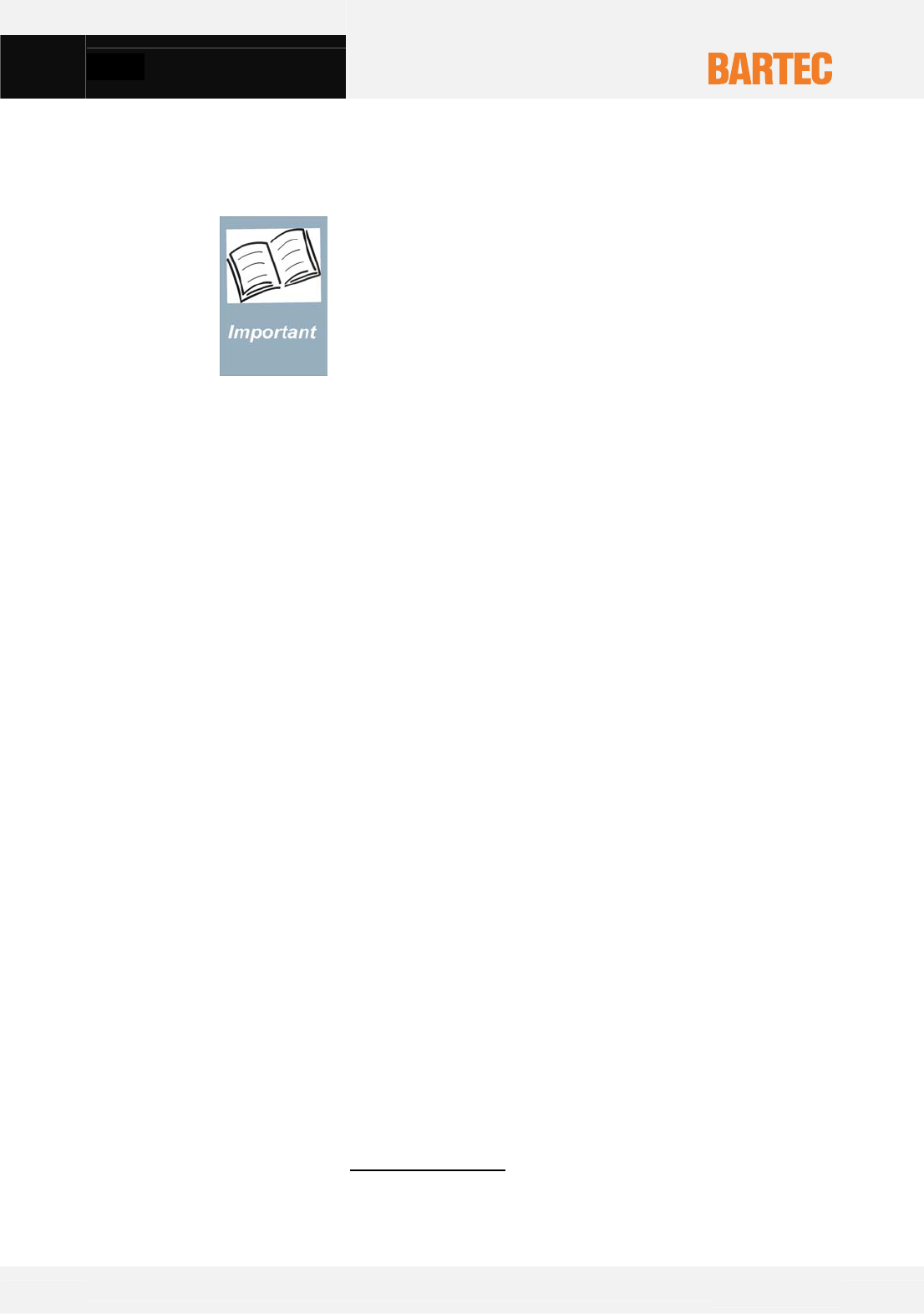
Safety
Technical data subject to change without notice.
Issue 01/2010
The user manual is a constituent part of the product and must be kept in
the direct vicinity of the device and accessible at all times to installation,
operating and maintenance personnel.
It contains important notes, safety instructions and test certificates which
are necessary for perfect functioning when the devices are being
operated and handled. It is written for technically qualified personnel.
Familiarity with and the technically perfect implementation of the safety
instructions and warnings described in this manual are preconditions for
safe installation and commissioning. The safety notes and warnings
given in this documentation are given in a general way and only qualified
personnel will have the necessary specialized know-how to interpret and
implement them correctly in specific cases.
Qualifications of the personnel working with the devices
The user manual is written for all people who carry out assembly,
installation, commissioning and service work on the product, whereby
the directives and standards must be observed.
For Europe:
99/92/EC, EN 60079-17, EN 60079-19 for the gas area
EN 61241-17 and EN 61241-19 for the dust area
For North America:
NEC 500.
For other countries or regions:
National directives and standards must be observed.
Changes to the document
BARTEC reserves the right to alter the contents of this document without
notice. No guarantee is given for the correctness of the information. In
case of doubt the German safety instructions shall apply because it is
not possible to rule out errors in translation or in printing. In the event of
a legal dispute, the “General Terms and Conditions” of the BARTEC
group shall apply in addition.
The respective up-to-date versions of data sheets, manuals, certificates,
EC Declaration of Conformity may be downloaded from the “Ex
Visualization and Communication Systems” product page at
www.bartec-group.com or ordered directly from BARTEC GmbH.
Notes on this manual
Read carefully
before putting
the devices
into operation.

Safety
Technical data subject to change without notice.
Issue 01/2010
The documents are currently available in German and English.
The product described in this manual has been tested and left the
factory in perfect condition as regards meeting safety requirements.
To maintain this condition and ensure that this product operates
perfectly and safely, it may be used only in the manner described by the
manufacturer. Appropriate transportation, suitable storage and careful
operation are also essential for the perfect and safe operation of this
product.
The Pegasus 70xx series has been constructed in conformance to the
latest technical developments and the recognized safety regulations.
Nevertheless, its use can still cause danger to life and limb of the user
or damage the device and other property.
The Pegasus 70xx series is available in three versions:
Pegasus 7000 Type G7-C010-*Q*1/0000
was developed for use in non Ex environment.
Pegasus 7010ex Type 17-C110-*Q*1/0000
was developed specially for use in hazardous areas in ATEX Zone 1 /
21, IECEx and UL Class I, II, III Division 1.
Pegasus 7020ex Type B7-C210-*Q*1/0000
was developed specially for use in hazardous areas in ATEX Zone 2 /
22 and UL Class I, II, III Division 2.
The manufacturer will not be liable for any ensuing damage. The risk
shall be borne by the user alone. Use for the intended purpose requires
also the observation of the operating instructions. Only people who are
familiar with the Pegasus 70xx series and instructed about the risks it
poses may use it or do any maintenance work on it.
Handing the Product
Use for the Intended Purpose
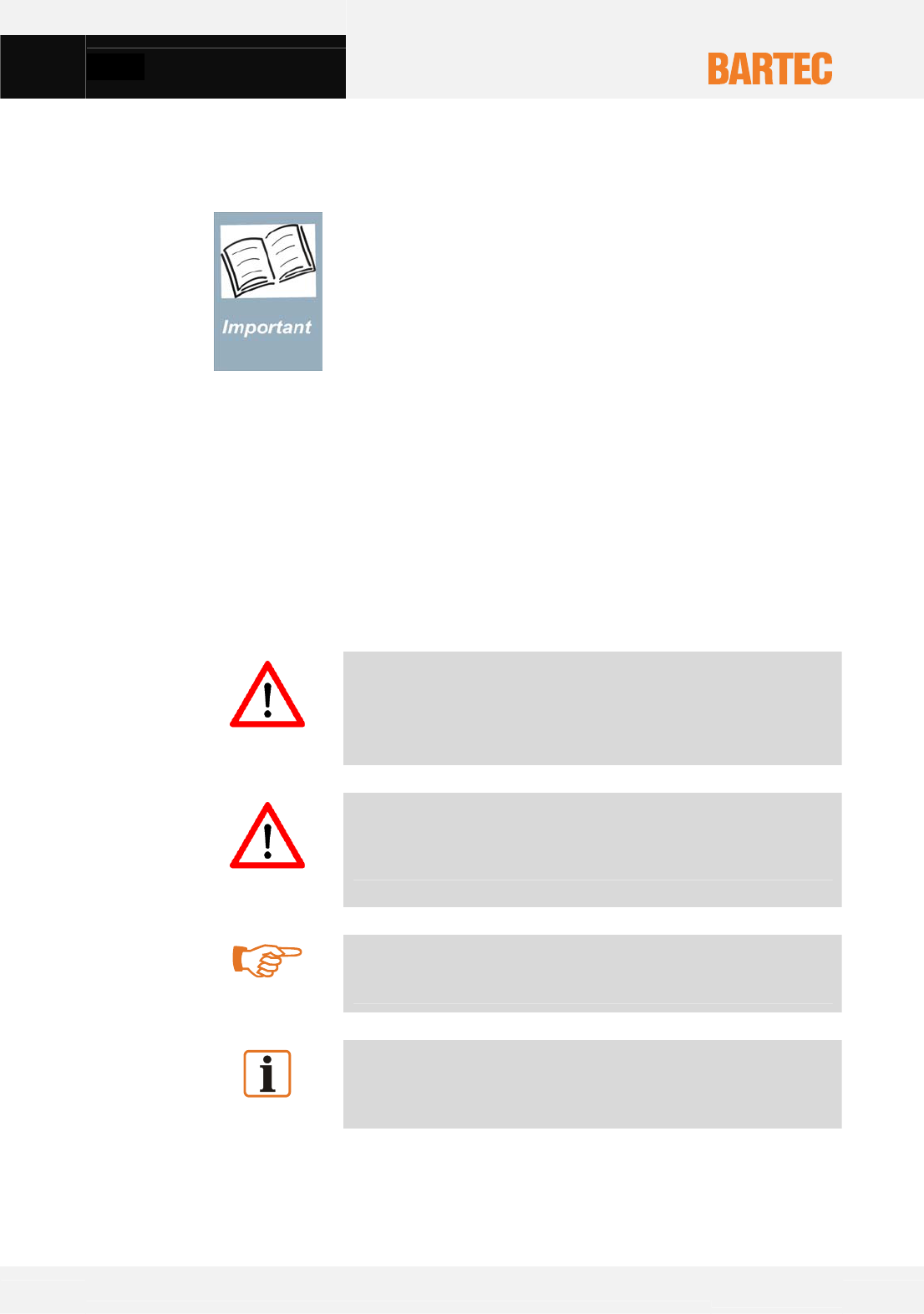
Safety
Technical data subject to change without notice.
Issue 01/2010
Safety instructions and warnings are specially highlighted in this manual
and marked by symbols.
The safety instructions and warnings are assigned to the individual work
steps. Careful handling and consistent observation of the instructions will
prevent accidents, personal injuries and damage to property.
The adherence to all directions and safety instructions in this manual is a
precondition for safe working and the correct handling of the device.
The graphic representations in these instructions serve to show the
information being described and are not necessarily true to scale and
they may deviate slightly from the actual construction of the device.
Particularly important points in these instructions are marked with a
symbol:
Danger!
Non-observance leads to death or serious physical injury. The
necessary safety measures must be taken.
Caution!
Warning of damage to property and financial and penal
disadvantages (e.g. loss of guarantee rights, liability etc.).
Attention
Important instructions and information on preventing
disadvantageous behavior.
Note
Important instructions and information on effective, economical
and environmentally compatible handling.
Safety Instructions
Marking
Read carefully
before putting
the devices
into operation.

Contents
Technical data subject to change without notice.
Issue 01/2010
1 Product Description....................................................................................................................................3
1.1 Definition .........................................................................................................................................3
2 Specification Pegasus 70xx series............................................................................................................5
2.1 Specification Pegasus 7000, type G7-C010-*Q*1/0000..................................................................5
2.1.1 Marking ...........................................................................................................................................5
2.2.1 Technical data.................................................................................................................................5
2.2 Specification Pegasus 7010ex, type 17-C110-*Q*1/0000...............................................................6
2.1.2 Ex protection marking .....................................................................................................................6
2.2.2 Technical data.................................................................................................................................6
2.3 Specification Pegasus 7020ex, type B7-C210-*Q*1/0000 ..............................................................7
2.1.3 Ex protection marking .....................................................................................................................7
2.2.3 Technical data.................................................................................................................................7
2.4 Product Marking..............................................................................................................................8
3 Safety and Security.....................................................................................................................................9
3.1 General Information ........................................................................................................................9
3.2 Notes of Handling............................................................................................................................9
3.3 Battery Safety................................................................................................................................10
3.4 Health and Safety recommendations ............................................................................................12
3.5 Exposure to RF energy .................................................................................................................12
3.6 Driving...........................................................................................................................................12
3.7 Electronic devices .........................................................................................................................12
3.8 Vehicle electronic equipment ........................................................................................................13
3.9 Medical electronic equipment........................................................................................................13
3.10 Aircraft...........................................................................................................................................13
3.11 Children.........................................................................................................................................13
3.12 Blasting areas ...............................................................................................................................13
3.13 Potentially explosive atmospheres................................................................................................13
3.14 Safety Standards...........................................................................................................................14
3.15 RF Exposures ...............................................................................................................................14
3.16 Statement of the UL ......................................................................................................................15

Safety
Technical data subject to change without notice.
Issue 01/2010
4 Commissioning .........................................................................................................................................16
4.1 Purchased parts in packages........................................................................................................16
4.2 Functional Parts of the device.......................................................................................................16
4.3 Fastening and Changing the belt clip............................................................................................18
4.4 Inserting and Changing the battery ...............................................................................................19
4.5 Charging the battery......................................................................................................................20
4.6 Inserting the Micro SD-card ..........................................................................................................21
4.7 SIM card........................................................................................................................................22
5 Operation ...................................................................................................................................................23
5.1 Getting started...............................................................................................................................23
5.1.1 PIN number...................................................................................................................................23
5.2.1 Navigation Principle ......................................................................................................................23
5.3.1 General Settings ...........................................................................................................................24
5.4.1 Key lock.........................................................................................................................................26
5.2 Phone settings ..............................................................................................................................26
5.1.2 Making a call .................................................................................................................................26
5.2.2 Receiving call................................................................................................................................28
5.3.2 Last call.........................................................................................................................................28
5.3 SMS (Short Message Service) Settings........................................................................................30
5.1.3 SMS Options.................................................................................................................................30
5.2.3 Creating a new message ..............................................................................................................30
5.3.3 Incoming........................................................................................................................................31
6 Maintenance, Inspection, Repair .............................................................................................................33
7 Disposal .....................................................................................................................................................34
8 Dispatch and Packaging Instructions .....................................................................................................34
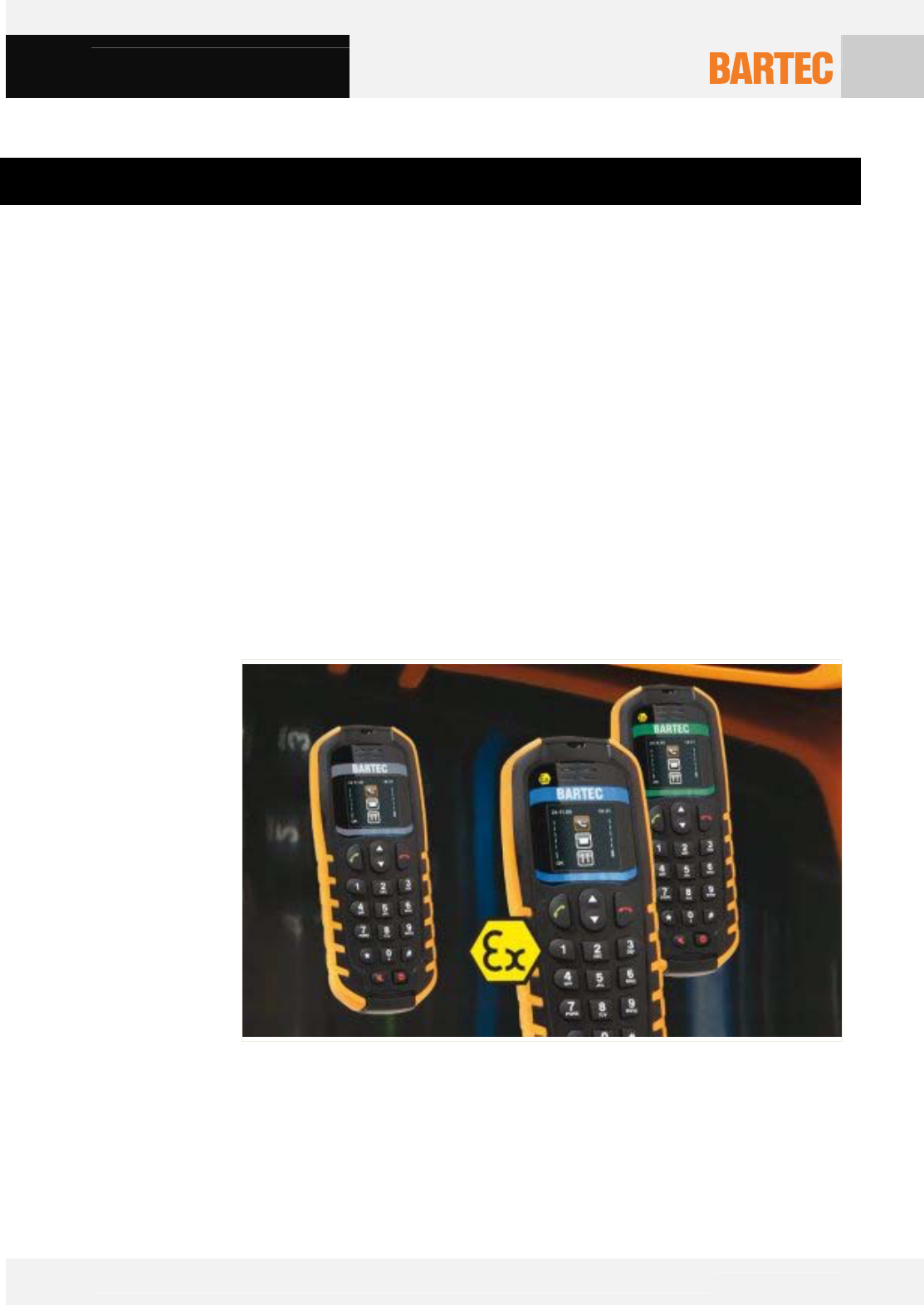
User Manual Pegasus 70xx series
Technical data subject to change without notice.
Issue 01/2010 Page 3 of 44
1 Product Description
PEGASUS 70xx series - the All in One Solution
PEGASUS is the new mobile phone/online tracking system for industry. It is perfect for
utilization in extreme conditions in the chemicals and pharmaceuticals industries and
also in the oil and gas industry. PEGASUS is robust, simple to use and comes in an
attractive distinctive design. „Made by BARTEC“ stands for top quality, long product
availability and excellent service.
PEGASUS 70xx series is available in different models and is the optimal mobile phone
for every region and every field of application:
- PEGASUS 7000 (industrial version)
- PEGASUS 7010ex (ATEX Zone 1,2, 21,22, IEC Ex ; UL Class I, II, III, Div 1, Div 2)
- PEGASUS 7020ex (ATEX Zone 2, 22 ; UL Class I, II, III Div 2)
Figure 1: Pegasus 70xx series
1.1 Definition

User Manual Pegasus 70xx series
Technical data subject to change without notice.
Issue 01/2010 Page 4 of 44
User-friendly keyboard
The keyboard is generously dimensioned and offers enough space for steady operation,
even with gloves. To prevent operating errors, all keys give tactile feedback in the form
of a click.
Quad Band GSM Module
PEGASUS knows no boundaries. With the Quad Band GSM module
(850/900/1800/1900 MHz) the device is ideally equipped for utilization on all continents.
Hands-free function
Workplace safety is the keyword where simultaneous working and phoning are
concerned. PEGASUS has a convenient hands-free function and emits a vibration alarm
at the same time as the ring tone.
Professional Online Tracking System
GPS receivers and special software make PEGASUS an efficient online tracking system.
The „history“ function provides a map showing movement along a route. This opens up
new possibilities for transporters of hazardous goods and other logistical tasks. You can
choose to store and evaluate the PEGASUS data on your own server or use the server
BARTEC has set up especially for it.
Man down function
PEGASUS is the perfect mobile phone for protecting individuals in extreme areas. The
fitted sensor (motion detection) reacts to the absence of movement and triggers an
online alarm after a defined period of time. The device is located by means of GPS. A
flag on a scalable map shows the location detected. The alarm including the GPS
position data can also be forwarded as a text message or as a voice message on a
phone.
Bright display
The OLED Full Color Display promises good legibility at all times, even in bad lighting
conditions.
Long talk time
The unusually long talk time is based on a high performance, rechargeable lithium
polymer battery.
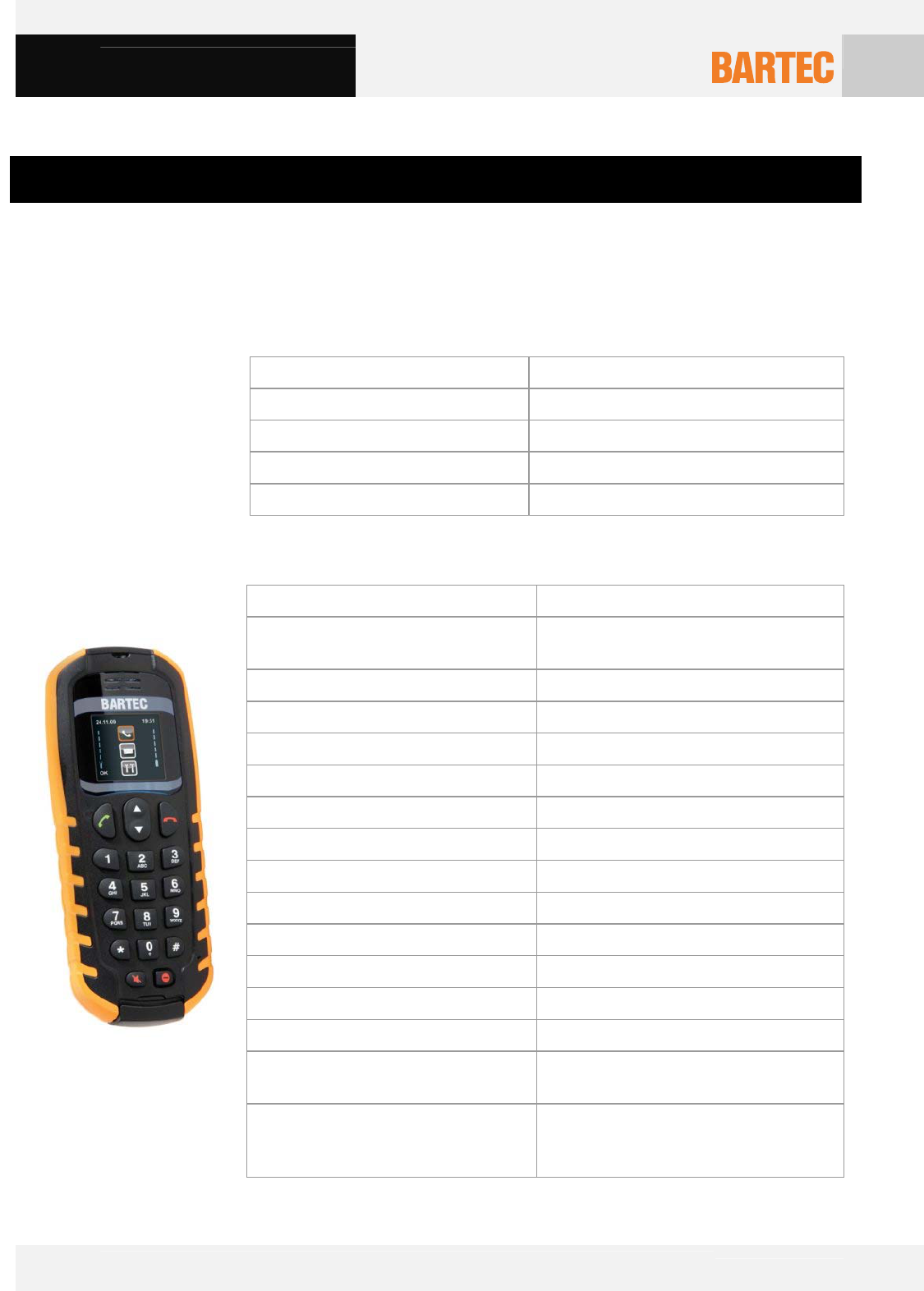
User Manual Pegasus 70xx series
Technical data subject to change without notice.
Issue 01/2010 Page 5 of 44
2 Specification Pegasus 70xx series
2.1 Specification Pegasus 7000, type G7-C010-*Q*1/0000
2.1.1 Marking
Type G7-C010-*Q*1/0000
Marking CE marking
Standards EN 60950-1
Directives -
2.2.1 Technical data
Display OLED color display
Networks Quad Band GSM
850/900/1800/1900 MHz
Dimensions (Height x Width x Depth) 155 mm x 59 mm x 27 mm
Weight approx. 240 g
IP rating IP 65
Ambient temperature -20 °C to +60 °C
Storage and transport temperature -20 °C to +60 °C
Charging temperature 0 °C to +50 °C
Air humidity 5 % up to 95 % (non-condensing)
GSM module Telit GE864
Power supply lithium polymer battery 3,7 V/2650 mAh
Interfaces mini USB
Audio system microphone and speaker integrated
Antennas integrated in the device (GPS and GSM)
Scope of supply includes battery, charger and USB
transmission cable
Accessories – Desktop charger
– Holster
– Micro SD card 1 GB or 2 GB
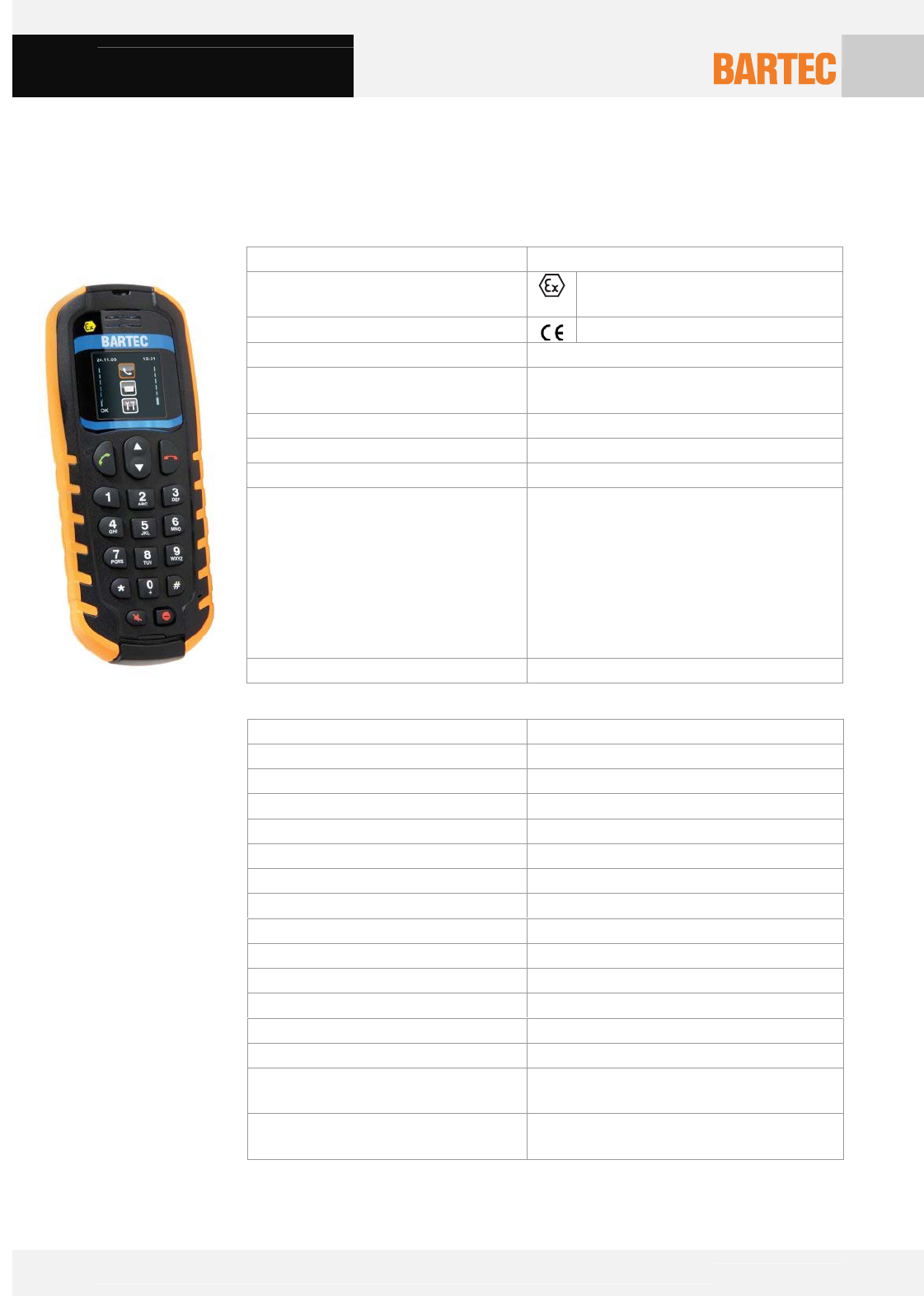
User Manual Pegasus 70xx series
Technical data subject to change without notice.
Issue 01/2010 Page 6 of 44
2.1.2 Ex protection marking
Type 17-C110-*Q*1/0000
Ex protection type (ATEX Zone 1 / 21) II 2G Ex ib IIB T4
II 2D Ex ibD21 T130°
Product marking
Certification Demko 10 ATEX 0911055X
Ex protection type (IECEx) Ex ib IIB T4 Gb
II 2D Ex ibD21 T130°
Certification IECEx UL 10.0003X
Ex protection type (UL) Class I, II, III Div 1, Groups C-D and F-G, T4
Certification E 321557
Standards UL 913, Seventh Edition (referencing UL 60079-
0, Fourth Edition and UL 60079-11, First Edition)
CAN/CSA C22.2 No. 157-92
UL 60950-1, First Edition
CSA C22.2 60950-1, First Edition
EN 60079-0:2009 EC 60079-0:2007
EN 60079-11:2007 IEC 60079-11:2006
DE 0825-1:2004 VDE 0825-11:2007
Directives 94/9/EC
2.2 Specification Pegasus 7010ex, type 17-C110-*Q*1/0000
2.2.2 Technical data
Display OLED color display
Networks Quad Band GSM 850/900/1800/1900 MHz
Dimensions (Height x Width x Depth) 155 mm x 59 mm x 27 mm
Weight approx. 240 g
IP rating IP 65
Ambient temperature -20 °C to +60 °C
Storage and transport temperature -20 °C to +60 °C
Charging temperature 0 °C to +50 °C
Air humidity 5 % up to 95 % (non-condensing)
GSM module Telit GE864
Power supply lithium polymer battery 3,7 V/2650 mAh
Interfaces mini USB
Audio system microphone and speaker integrated
Antennas integrated in the device (GPS and GSM)
Scope of supply includes battery, charger and USB
transmission cable
Accessories Desktop charger, Holster, Micro SD card 1
GB or 2 GB
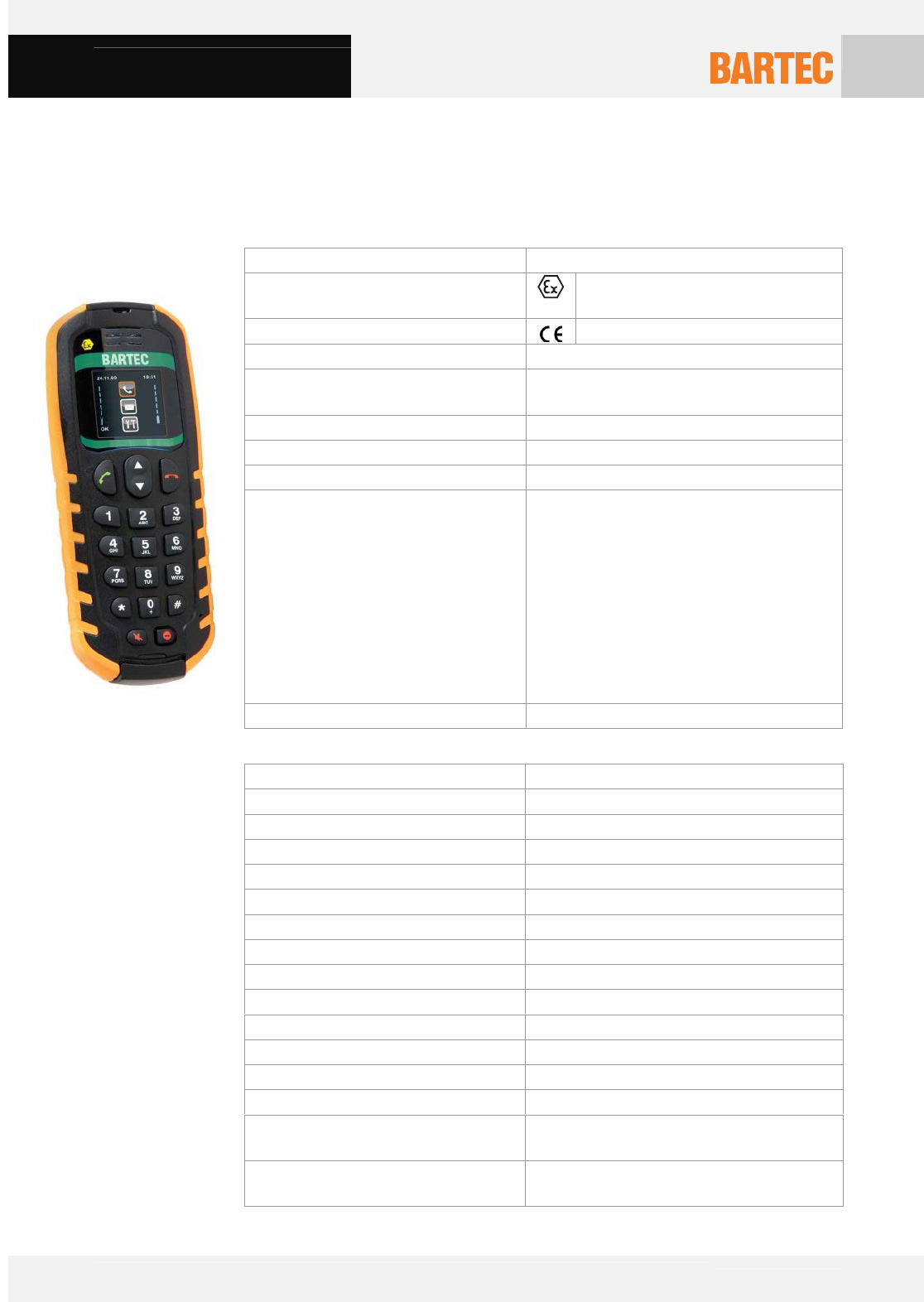
User Manual Pegasus 70xx series
Technical data subject to change without notice.
Issue 01/2010 Page 7 of 44
2.1.3 Ex protection marking
Type B7-C210-*Q*1/0000
Ex protection type (ATEX Zone 2 / 22) II 3G Ex ib IIC T4
II 3D Ex ibD22 T130°
Product marking
Certification Demko 10 ATEX 147282X
Ex protection type (IECEx) II 3G Ex ic IIC T4 Gc
II 3D Ex icD22 T130°
Certification IECEx UL 10.0004X
Ex protection type (UL) Class I, II, III Div 2, Groups C-D and F-G, T4
Certification E 321557
Standards UL 913, Seventh Edition (referencing UL
60079-0, Fourth Edition and UL 60079-11,
First Edition)
CAN/CSA C22.2 No. 157-92
UL 60950-1, First Edition
CSA C22.2 60950-1, First Edition
EN 60079-0:2009 IEC 60079-0:2007
EN 60079-11:2007 IEC 60079-11:2006
DE 0825-1:2004
VDE 0825-11:2007
Directives 94/9/EC
2.3 Specification Pegasus 7020ex, type B7-C210-*Q*1/0000
2.2.3 Technical data
Display OLED color display
Networks Quad Band GSM 850/900/1800/1900 MHz
Dimensions (Height x Width x Depth) 155 mm x 59 mm x 27 mm
Weight approx. 240 g
IP rating IP 65
Ambient temperature -20 °C to +60 °C
Storage and transport temperature -20 °C to +60 °C
Charging temperature 0 °C to +50 °C
Air humidity 5 % up to 95 % (non-condensing)
GSM module Telit GE864
Power supply lithium polymer battery 3,7 V/2650 mAh
Interfaces mini USB
Audio system microphone and speaker integrated
Antennas integrated in the device (GPS and GSM)
Scope of supply includes battery, charger and USB
transmission cable
Accessories Desktop charger, Holster, Micro SD card 1
GB or 2 GB
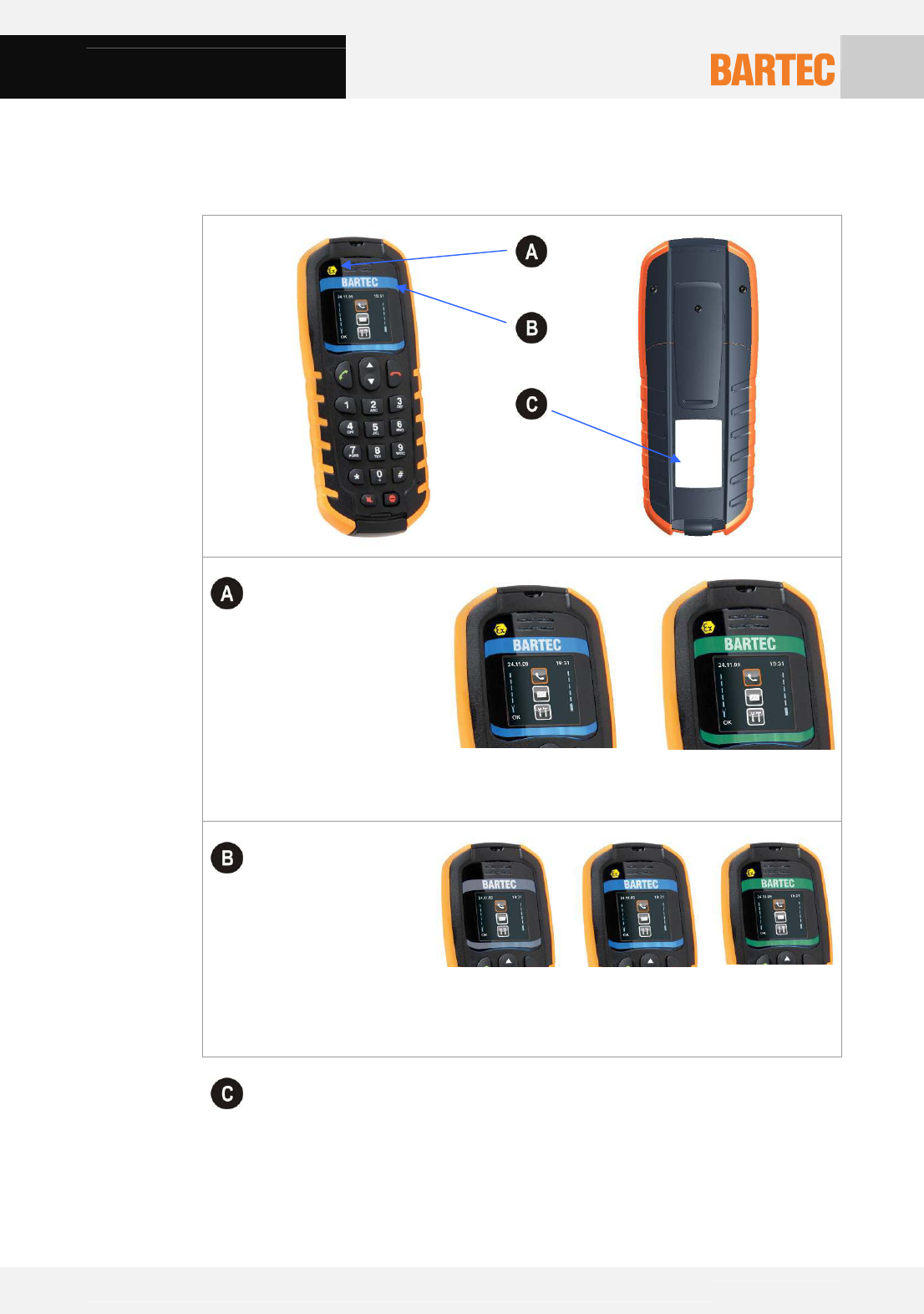
User Manual Pegasus 70xx series
Technical data subject to change without notice.
Issue 01/2010 Page 8 of 44
Ex Logo
Only printed on the
displayed Ex versions
of the Pegasus 70xx
series.
Pegasus 7010ex Pegasus 7020ex
Differentiation of
colors
Pegasus 7000
with grey display
border
Pegasus 7010ex
with blue display
border
Pegasus 7020ex
with green
display border
Type label
2.4 Product Marking
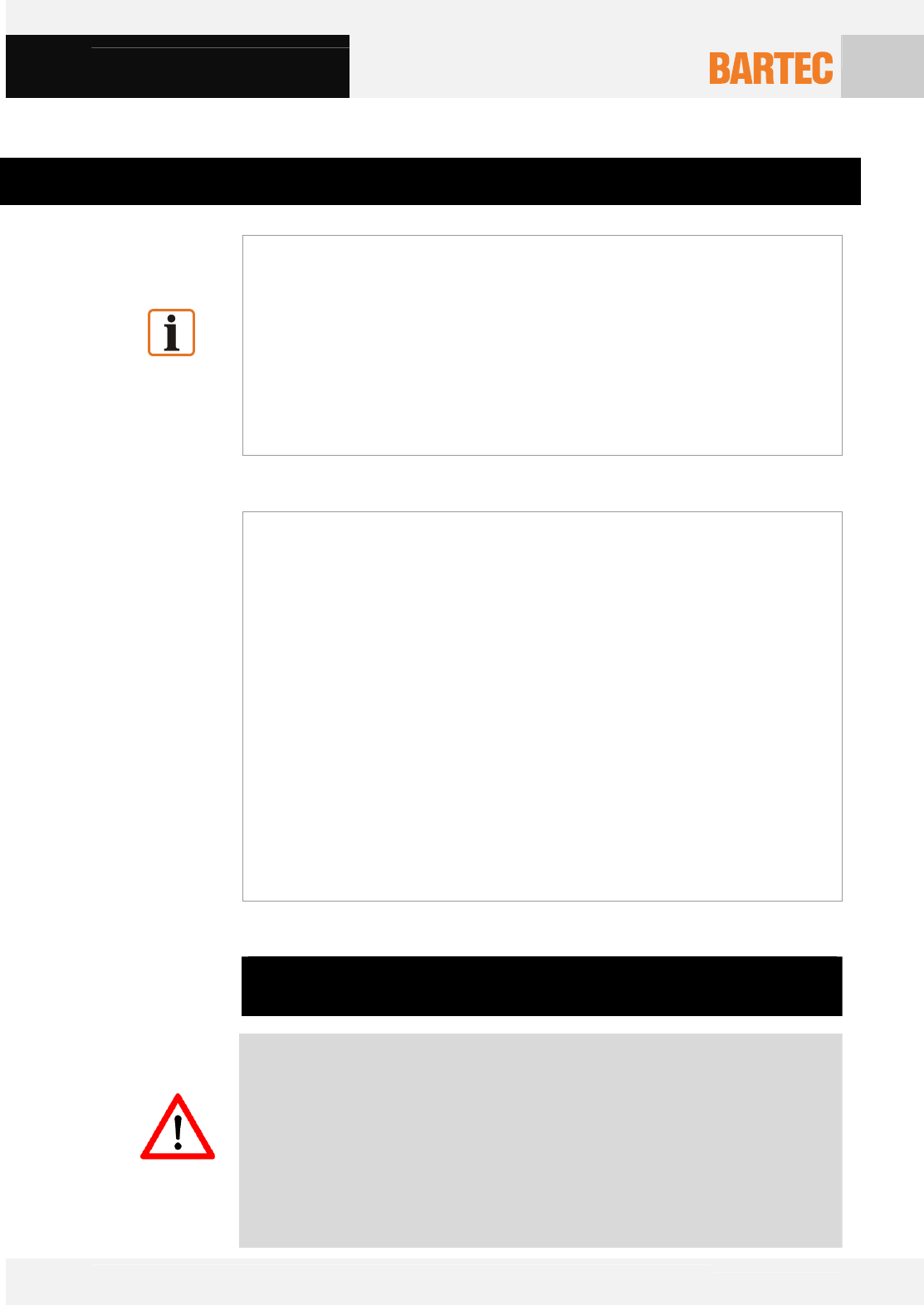
User Manual Pegasus 70xx series
Technical data subject to change without notice.
Issue 01/2010 Page 9 of 44
3 Safety and Security
Note
For an efficient and safe operation of your Pegasus 70xx series, it is important
that you read this information before use!
Your Pegasus 70xx series is one of the most exciting and innovative electronic products
ever developed. With it, you can stay in contact with your office, your home, emergency
services and others, wherever service is provided.
This chapter contains important information on the safe and reliable use of the Pegasus
70xx series device. Please read this chapter carefully before starting to use the Pegasus
70xx cellular engine series.
Your Pegasus 70xx series device utilizes the GSM standard for cellular technology.
GSM is a newer radio frequency („RF“) technology than the current FM technology that
has been used for radio communications for decades. The GSM standard has been
established for use in the European community and elsewhere. Your Pegasus 70xx
series is actually a low power radio transmitter and receiver. It sends out and receives
radio frequency energy. When you use your modem, the cellular system handling your
calls controls both the radio frequency and the power level of your cellular modem.
SIM cards, not included in the scope of delivery of the device, are needed for using the
acquired devices. The SIM cards can be obtained e.g. from specific providers. The use
of the SIM cards can result in additional costs, which must be borne by the purchaser
(customer) of the devices. The seller does not cover the extra costs involved in using the
devices. The seller gives no recommendation on the use of specific SIM cards and does
not give any assurance either that the devices will be usable with all available SIM cards.
The seller will not cover any other costs incurred when this device is used in a
customer’s application.
The device is factory-sealed. Do not open it!
The device may be opened in the factory only!
Danger!
Protect the device from impact effects! Do not expose the equipment to corrosive/
aggressive liquids, vapors or mist! Take the equipment out of the hazardous area
immediately if it malfunctions or if the enclosure is damaged and bring it into the safe
area to put it out of operation!
Put the device out of operation immediately also if you suspect that the operating
equipment can no longer be operated safely after harmful effects or general
irregularities (e.g. penetration of water, fluids, effect of temperatures outside the
specified range etc.).
3.1 General Information
3.2 Notes of Handling
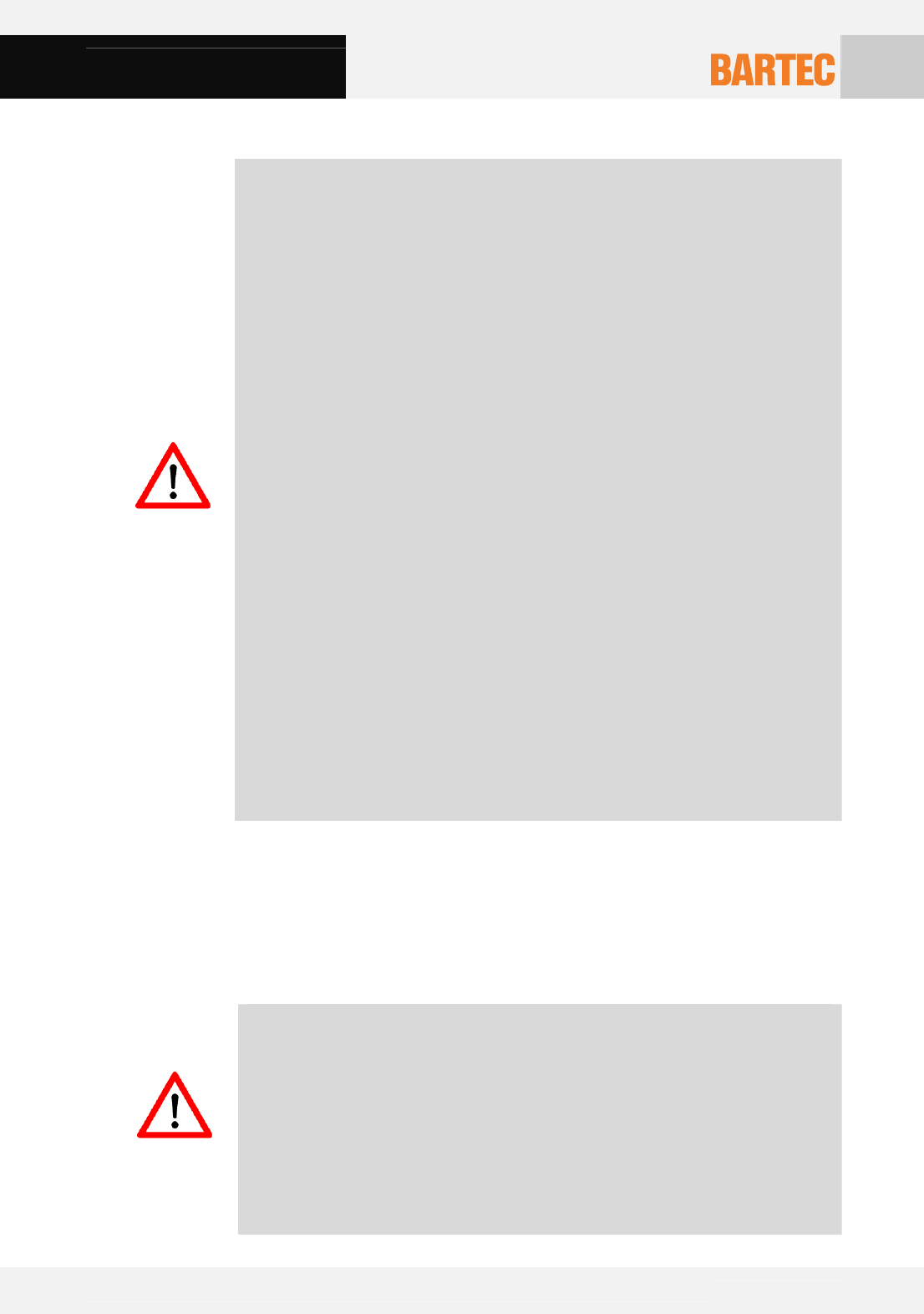
User Manual Pegasus 70xx series
Technical data subject to change without notice.
Issue 01/2010 Page 10 of 44
Caution!
Do not open or charge the devices and do not exchange any data through the listed
equipment in the hazardous area!
The device my not be opened by the user outside the hazardous area either!
The user may not make any alterations to the device. Do not exchange or replace
components and do not retrofit any components on internal plug connectors or slots. If
components other than those specified are used, the protection against explosions can
no longer be assured.
Exception:
SIM card, Micro SD card and battery door (see chapter 4 "Commissioning")
Remove the display protection of the Pegasus before use in hazardous location.
Take the device out of the hazardous areas before wiping it with a dry cloth or cleaning
it!
Avoid the effects of moisture.
Avoid the influence of heat that is higher or lower than the specified temperature range
(see chapter 2 "Technical Data"). Do not place the devices anywhere near sources of
heat, such as for example heaters, air exit openings in air-conditioners, or near cookers
or other devices (including amplifiers) that radiate heat.
The rules for hazardous areas (see directive 99/92/EC) must be observed. In particular,
appropriate clothing and footwear should be worn in view of the risk of dangerous
electrostatic charges. Do not wear rubber gloves or suchlike during operation!
General statutory regulations or directives on safety at work, accident prevention
regulations and environmental protection legislation must be complied with, e.g.
Ordinance on industrial health and safety (BetrSichV) or the national ordinances.
The safety rules below are applied for the internal battery. Mistreating the battery may
cause the battery to get hot, crack, or inflame and cause serious injury. In order to
avoid any damage and extend the life expectancy of the battery, please follow the
safety rules listed below before using the Pegasus 70xx series device:
Danger!
The battery may only be charged with listed chargers outside the hazardous area!
Charge and change battery only in an area known to be non-hazardous. Use only
BARTEC Models what are listed in chapter “3.4 Health and Safety recommendations”
for charging and communication or equivalent.
It must be ensured that only original batteries of the type 17-C1Z0-0001 with
3.7 V/2650 mAh are used in safety-oriented operation. The use of imitation batteries or
batteries from other manufacturers will render the type of ignition protection ineffective
and there will then be a risk of fire or explosion.
3.3 Battery Safety
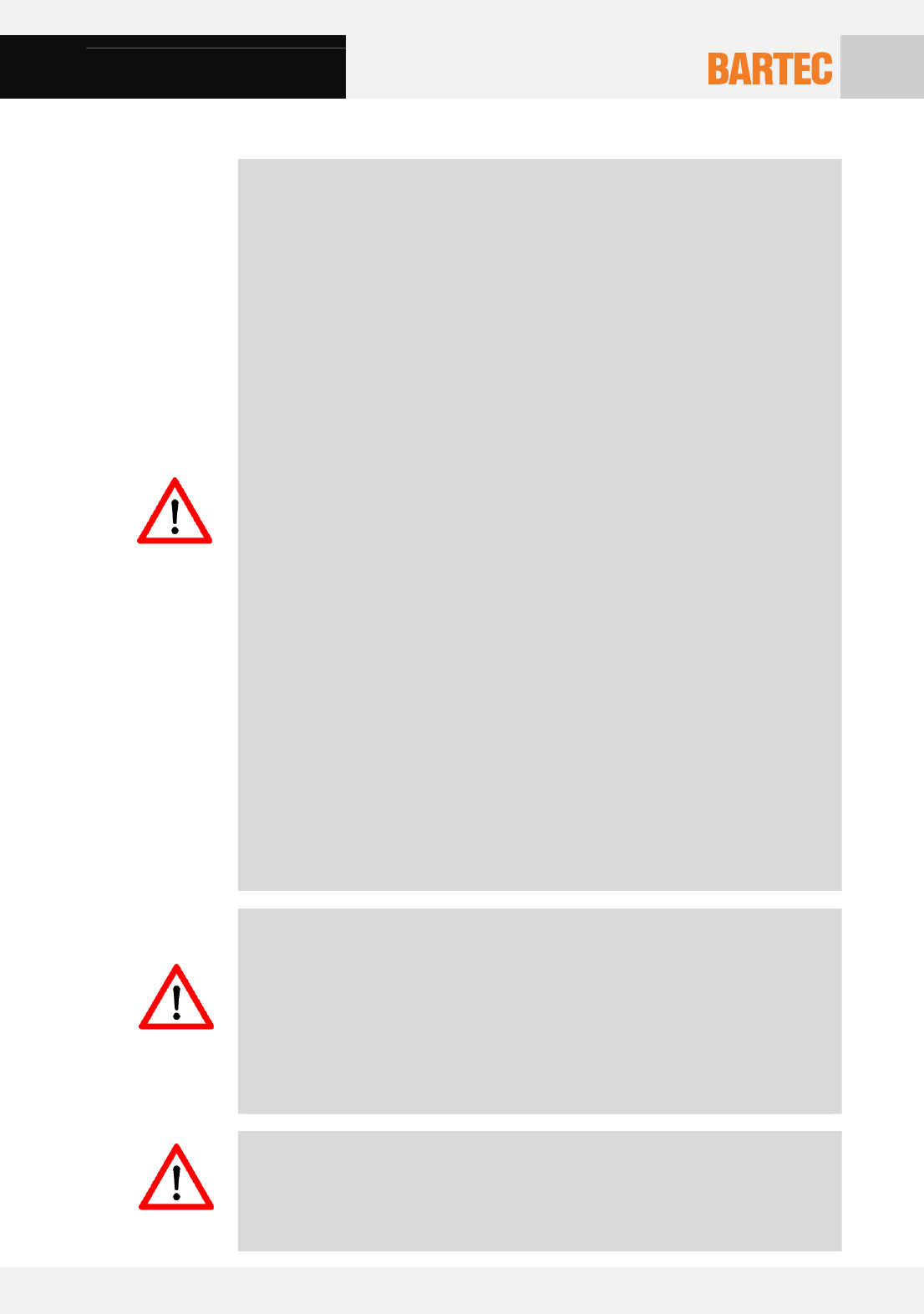
User Manual Pegasus 70xx series
Technical data subject to change without notice.
Issue 01/2010 Page 11 of 44
Caution!
The battery should only be used for the purposes stated in the user manual and is only
suitable for use with Pegasus 70xx series.
The battery should not be exposed to any temperatures higher than +60 °C.
Do not place the battery on, in or near fires, apparatus that provide heat, or other high-
temperature locations.
Do not place the battery in direct sunshine or use or store the battery inside cars in hot
weather. Doing so may cause the battery to generate heat, crack, or inflame. Using the
battery in this manner may also result in a loss of performance.
Do not attach the battery to a power supply plug or directly to a car’s cigarette lighter.
Do not pierce the battery with nails, strike the battery with a hammer, step on the
battery, or otherwise subject it to strong impacts or shocks.
Do not solder onto the battery contacts.
Do not allow the battery to get wet.
Do not disassemble or modify the battery.
Immediately discontinue use of the battery if, while using, charging, or storing the
battery, the battery emits an unusual smell, feels hot, or appears abnormal in any other
way.
Do not place the batteries in microwave ovens, high-pressure containers, or on
induction cookware.
In case the battery drips and the fluid gets into one’s eye, do not rub the eye. Rinse well
with water and immediately look for medical care. If left untreated the battery fluid could
cause damage to the eye.
Defective batteries must be disposed of immediately, whereby the battery disposal
regulations that apply to the respective region must be observed.
Caution!
Safety precautions while charging the battery.
Be sure to follow the rules listed below while charging the battery. Failure to do so may
cause the battery to become hot, rupture, or ignite and cause serious injury.
When charging the battery, make sure to observe the specified battery charging
conditions. The temperature range within which the battery can be charged is 0°C to
+50°C. Charging will be interrupted if the ambient temperature drops below or exceeds
this range.
Caution!
Safety precautions while discharging the battery.
The temperature range for discharging the batteries is -20°C to 60°C. Use of the
battery outside this temperature range may damage the performance of the battery or
reduce its life expectancy.
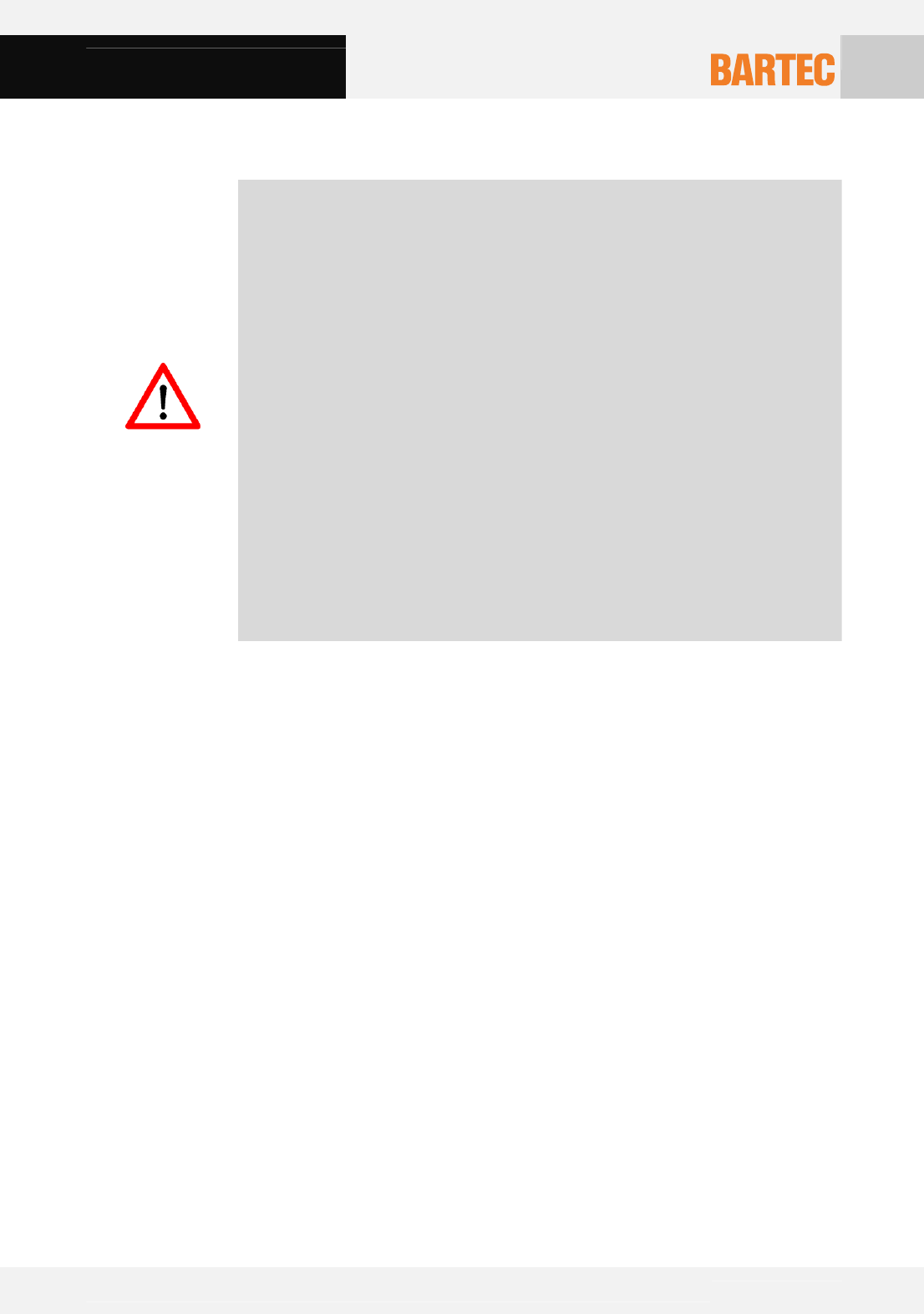
User Manual Pegasus 70xx series
Technical data subject to change without notice.
Issue 01/2010 Page 12 of 44
Danger!
Use only approved accessories.
All components must be dry before they may be connected to an external power
supply.
It is only permitted to use by BARTEC approved accessories for charging or/and data
communication.
17-C1Z0-0001 Battery 3,7 V / 2650 mAh
17-C1Z0-0002 Charging cable
17-C1Z0-0003 USB data communication cable
17-C1Z0-0004 leather holster
17-C1Z0-0005 Desktop charger
17-C1Z0-0006 Car charging cable
17-C1Z0-0007 Micro SD card with 1 GB
17-C1Z0-0008 Micro SD card with 2 GB
These accessories are modified in accordance to the necessary standards.
The use of imitation accessories or accessories from other manufacturers will render
the type of ignition protection ineffective and there will be a risk of fire or explosion.
There has been some public concern about possible health effects of using a GSM
modem. Although research on health effects from RF energy has focused for many
years on the current RF technology, scientists have begun research on newer radio
technologies, such as GSM. After reviewing existing research and testing compliance
with all applicable safety standards, it has been concluded that the product is fit for use.
If you are concerned about exposure to RF energy, there are things you can do to
minimize exposure. Obviously, limiting the duration of your calls will reduce your
exposure to RF energy. In addition, you can reduce RF exposure by operating your
cellular modem efficiently by following the guidelines below.
Check the laws and regulations on the use of cellular devices in the area where you
drive. Always obey them. Also, when using your Pegasus 70xx series while driving,
please pay full attention to driving, pull off the road and park before making or answering
a call if driving conditions so require. When applications are prepared for mobile use,
they should comply with road-safety rules under applicable laws!
3.4 Health and Safety recommendations
3.5 Exposure to RF energy
3.6 Driving

User Manual Pegasus 70xx series
Technical data subject to change without notice.
Issue 01/2010 Page 13 of 44
Most electronic equipment, for example in hospitals and motor vehicles is shielded from
RF energy. However, RF energy may affect some malfunctioning or improperly shielded
electronic equipment.
Check with your vehicle manufacturer’s representative to determine if any on board
electronic equipment is adequately shielded from RF energy.
Consult the manufacturer of any personal medical devices (such as pacemakers,
hearing aids, etc.) to determine if they are adequately shielded from external RF energy.
Turn your Pegasus 70xx series device OFF in health care facilities when any regulations
posted in the area instruct you to do so. Hospitals or health care facilities may be using
RF monitoring equipment
Turn your Pegasus 70xx series OFF before boarding any aircraft. Use it on the ground
only with crew permission. Do not use it in the air. To prevent possible interference with
aircraft systems, Federal Aviation Administration (FAA) regulations require you to have
permission from a crewmember to use your modem while the plane is on the ground. To
prevent interference with cellular systems, local RF regulations prohibit the use of your
modem whilst airborne.
Do not allow children to play with your Pegasus 70xx series device. It is not a toy.
Children could hurt themselves or others (by poking themselves or others in the eye with
the antenna, for example). Children could damage the modem or make calls that
increase your modem bills.
To avoid interfering with blasting operations, turn your device OFF when in a “blasting
area” or in areas posted: „turn off two-way radio“. Construction crew often uses remote
control RF devices to set off explosives.
3.7 Electronic devices
3.8 Vehicle electronic equipment
3.9 Medical electronic equipment
3.10 Aircraft
3.11 Children
3.12 Blasting areas

User Manual Pegasus 70xx series
Technical data subject to change without notice.
Issue 01/2010 Page 14 of 44
Turn your Pegasus 70xx series device OFF when in any area with a potentially explosive
atmosphere. It is rare, but your modems or their accessories could generate sparks. Sparks
in such areas could cause an explosion or fire resulting in bodily injury or even death.
Areas with a potentially explosive atmosphere are often, but not always, clearly marked.
They include fuelling areas such as petrol stations; below decks on boats; fuel or
chemical transfer or storage facilities; and areas where the air contains chemicals or
particles, such as grain, dust or metal powders.
Do not transport or store flammable gas, liquid or explosives, in the compartment of your
vehicle which contains your modem or accessories.
Before using your modem in a vehicle powered by liquefied petroleum gas (such as
propane or butane) ensure that the vehicle complies with the relevant fire and safety
regulations of the country in which the vehicle is to be used.
¨ Pegasus 7000 is intended for use in industrial environment
¨ Pegasus 7010ex is intended for use in hazardous locations (Zone 1/21 or
IECEx Zone 1/21 or Class I, II, III Division 1 or Zone 2/22 or IECEx Zone
2/22 or Class I, II, III Division 2)
¨ Pegasus 7020ex is intended for use in hazardous locations (Zone 2/22 or
IECEx Zone 2/22 or Class I, II, III Division 2)
Your GSM/GPRS/GPS device complies with all applicable RF safety standards.
Pegasus 70xx series meets the safety standards for RF receivers and the standards and
recommendations for the protection of public exposure to RF electromagnetic energy
established by government bodies and professional organizations, such as directives of
the European Community, Directorate General V in matters of radio frequency
electromagnetic energy.
This device contains 850/900/1800/1900 MHz GSM/GPRS functions that are operational
in these frequencies respectively. The Pegasus 70xx series device contains 1800 MHz
GSM functions that are not operational (must not be used) in U.S. Territories. Filing is
only applicable for 850MHz GSM/1900 MHz PCS operations, whereby only these
frequencies (850MHz GSM/1900 MHz PCS) may be used in U.S. Territories.
3.13 Potentially explosive atmospheres
3.14 Safety Standards
3.15 RF Exposures

User Manual Pegasus 70xx series
Technical data subject to change without notice.
Issue 01/2010 Page 15 of 44
Statement according to FCC part 15.19:
This device complies with Part 15 of the FCC Rules. Operation is subject to the following
two conditions:
■ this device may not cause harmful interference, and
■ this device must accept any interference received, including interference that may
cause undesired operation.
Statement according to FCC part 15.21:
Modifications not expressly approved by this company could void the user's authority to
operate the equipment.
Statement according to FCC part 15.105:
NOTE: This equipment has been tested and found to comply with the limits for a Class B
digital device, pursuant to Part 15 of the FCC Rules. These limits are designed to
provide reasonable protection against harmful interference in a residential installation.
This equipment generates uses and can radiate radio frequency energy and, if not
installed and used in accordance with the instructions, may cause harmful interference
to radio communications. However, there is no guarantee that interference will not occur
in a particular installation. If this equipment does cause harmful interference to radio or
television reception, which can be determined by turning the equipment off and on, the
user is encouraged to try to correct the interference by one or more of the following
measures:
Reorient or relocate the receiving antenna.
Increase the distance between the equipment and receiver.
Plug the equipment into an outlet on a circuit different from that to which
the receiver is connected.
Consult the dealer or an experienced radio/TV technician for help.
The statement “Underwriters Laboratories Inc. (UL) has not tested the performance or
reliability of the Global Positioning System (GPS) hardware, GPS operating software or
other GPS-related aspects of this product. UL has only tested for the explosion, fire,
shock and casualty hazards required by the applicable hazardous locations standards.
UL certification does not cover the performance or reliability of the GPS hardware, GPS
operating software or other GPS-related aspects of this product. UL MAKES NO
REPRESENTATIONS, WARRANTIES OR CERTIFICATIONS WHATSOEVER
REGARDING THE PERFORMANCE OR RELIABILITY OF ANY GPS RELATED
FUNCTIONS OF THIS PRODUCT.”
3.16 Statement of the UL
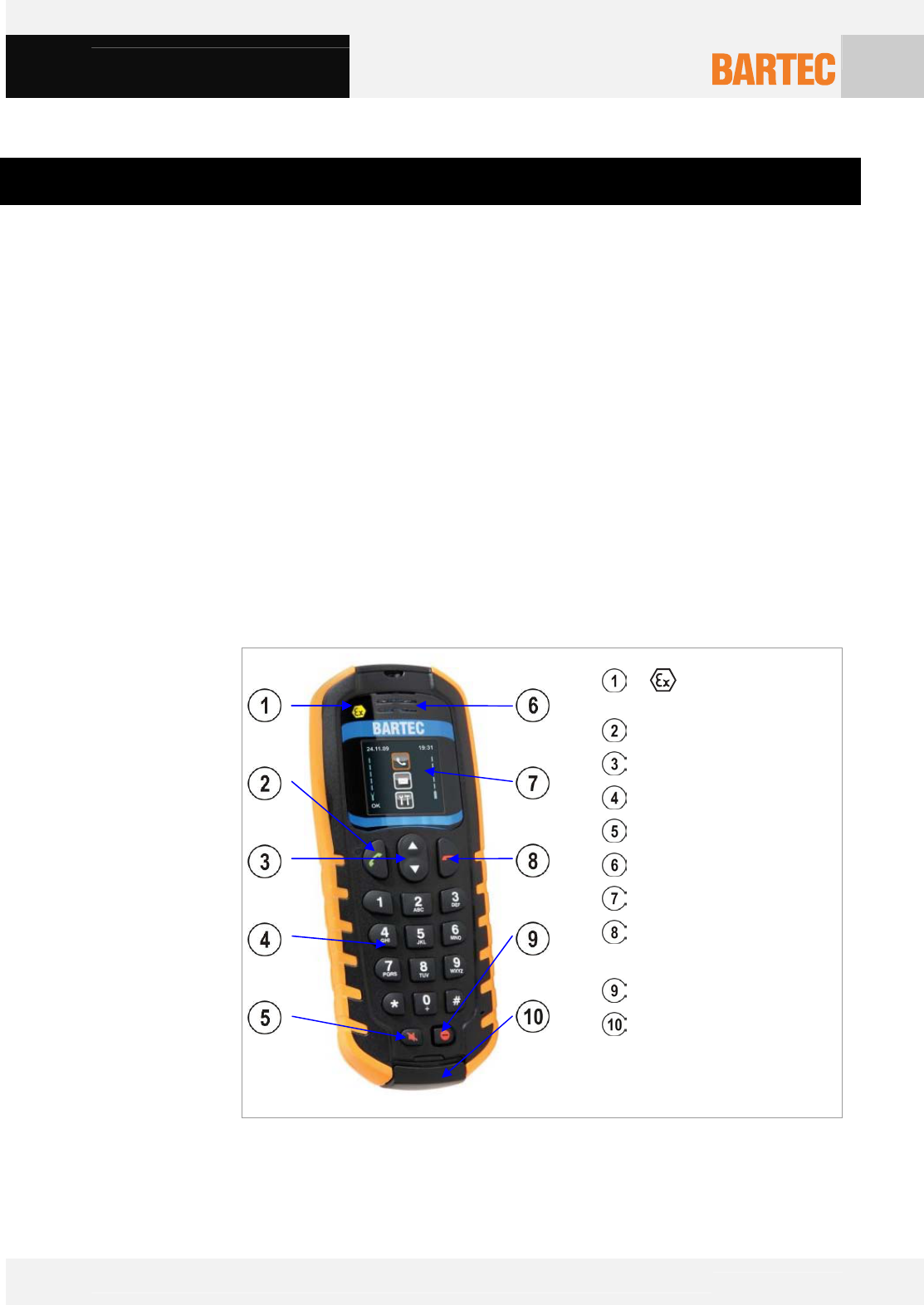
User Manual Pegasus 70xx series
Technical data subject to change without notice.
Issue 01/2010 Page 16 of 44
4 Commissioning
Before commissioning the devices, check that all components and documents are there.
■ Pegasus 70xx Mobile Phone
■ Battery
■ Charger cable
■ USB-Data cable
■ CD-ROM (User Manual, Phonebook software, Tracking software)
■ Safety instructions
Logo only on Pegasus
7010 ex and 7020ex
Left soft key (to call or OK)
2-Way navigation key
Keypad
Emergency call
Speaker
Screen
Right soft key
(to hang up or Back)
Power On / Off
Cover
(Mini USB interface,
SIM card slot, Micro SD
card slot, Hard shutdown)
Figure 5: Pegasus 7010ex front side
4.1 Purchased parts in packages
4.2 Functional Parts of the device
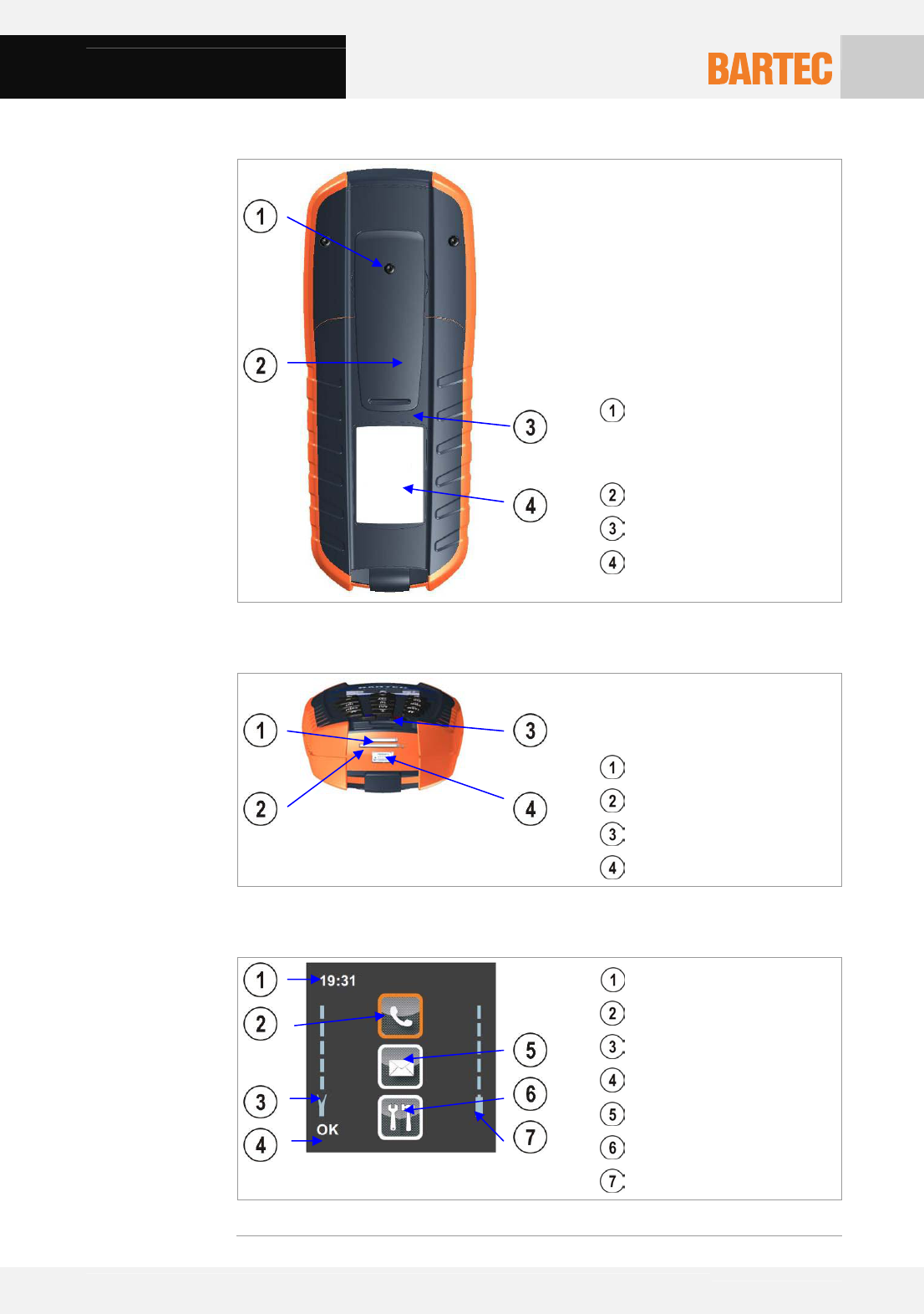
User Manual Pegasus 70xx series
Technical data subject to change without notice.
Issue 01/2010 Page 17 of 44
Screw for fastening the belt
clip
(type K20x8 WN5452-Torx-1)
Belt clip
Battery cover
Type label
Figure 6: Pegasus 7010ex rear side
Micro SD card slot
SIM card slot
Hard shutdown
Mini USB interface
Figure 7: Pegasus 70xx cover
Clock
Phone settings
Signal strength level (5 bars)
OK for the left soft key
SMS settings
General settings
Battery
Figure 8: Pegasus 70xx start screen
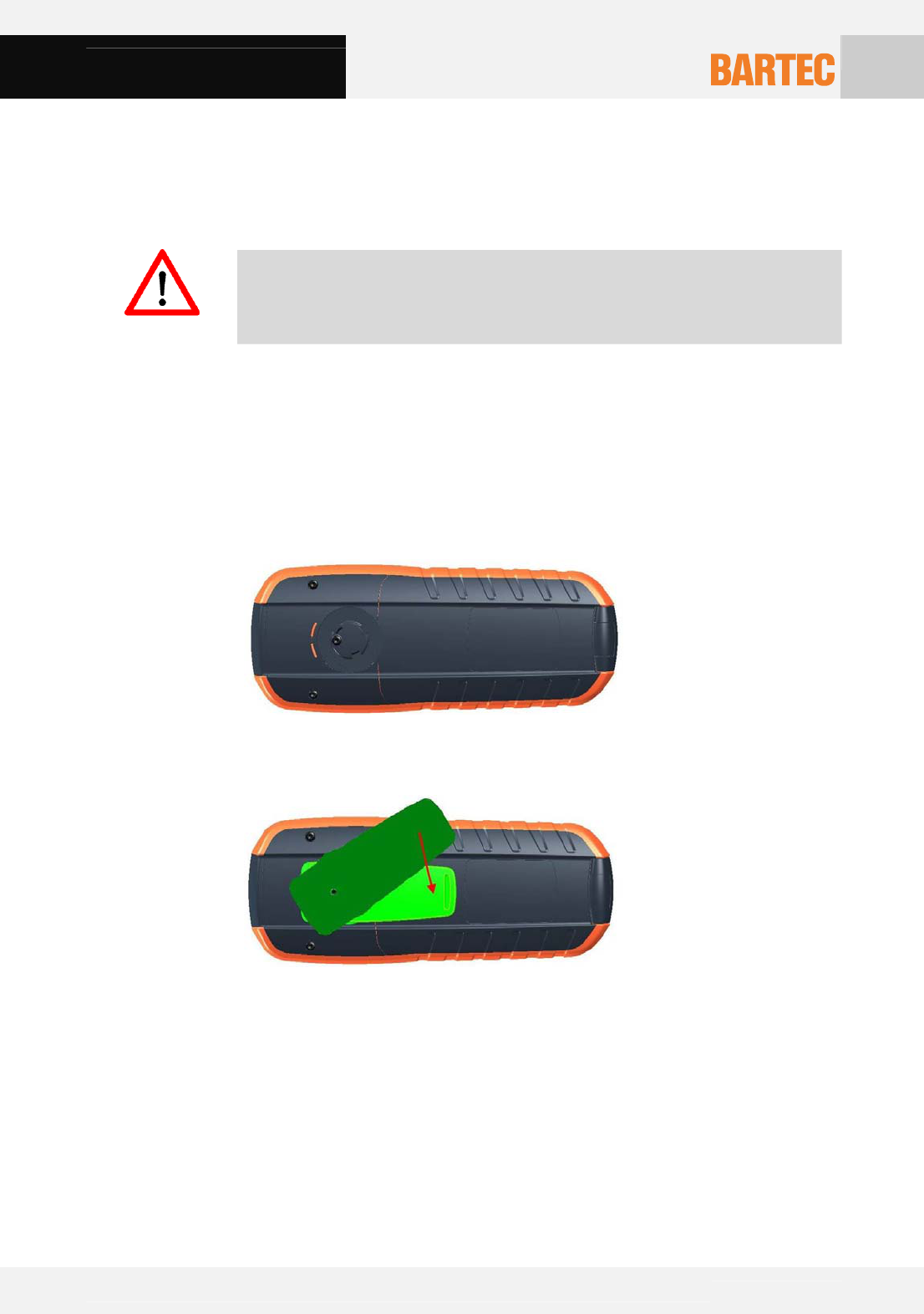
User Manual Pegasus 70xx series
Technical data subject to change without notice.
Issue 01/2010 Page 18 of 44
Danger!
The belt clip may only be fastened or changed outside the hazardous area!
¨ Put the belt clip into the slot of the back of the Pegasus 70xx
¨ Turn the belt clip in position as shown in figure 10
¨ Tighten the screw (type K20x8 WN5452-Torx-1) to fix the belt clip on the
Pegasus 70xx.
Figure 9: Pegasus 70xx without belt clip
Figure 10: Pegasus 70xx fastening belt clip
4.3 Fastening and Changing the belt clip
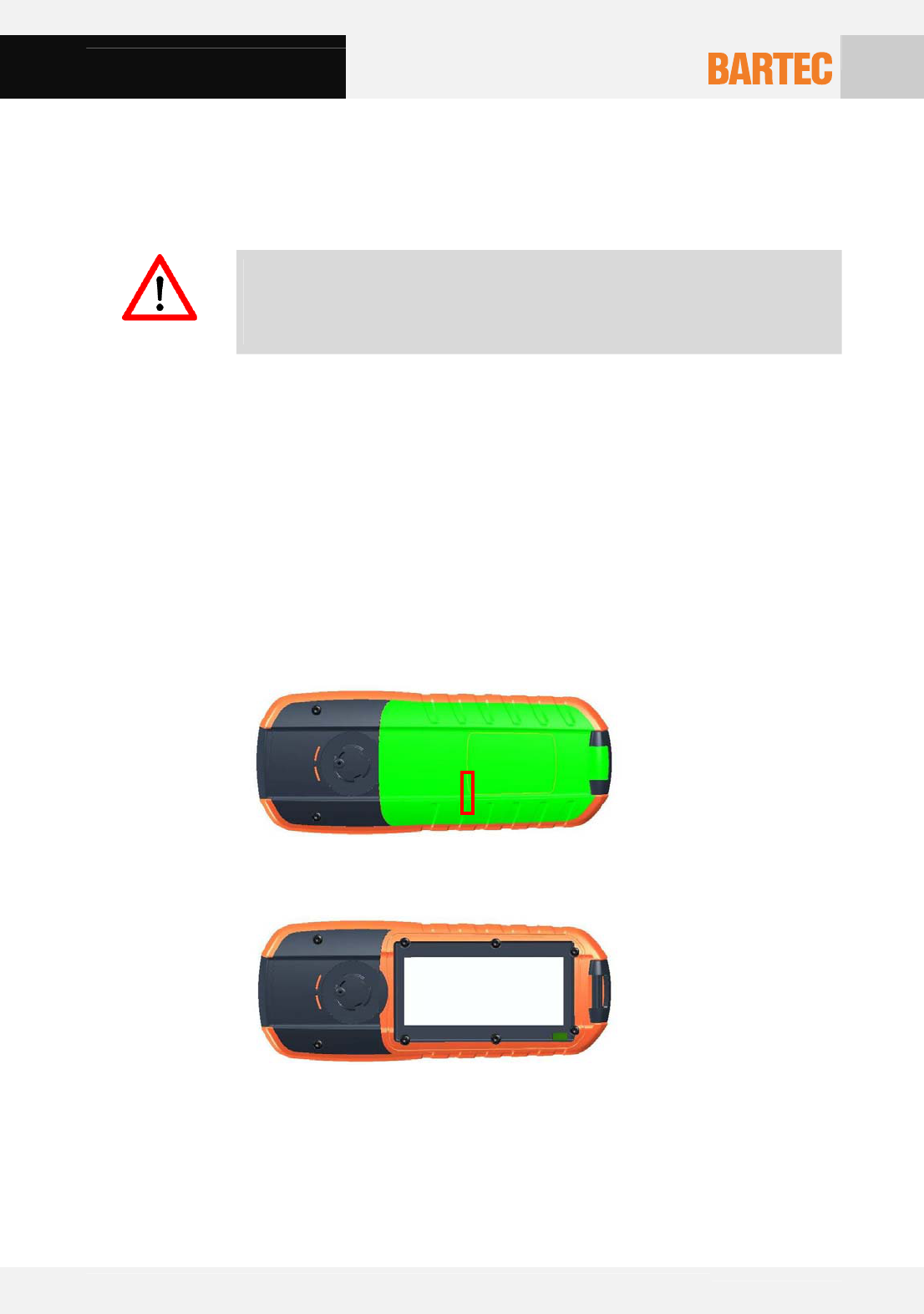
User Manual Pegasus 70xx series
Technical data subject to change without notice.
Issue 01/2010 Page 19 of 44
Danger!
Charge and change battery only in an area known to be non-hazardous. Use only
BARTEC Models what are listed in chapter “3.4 Health and Safety recommendations”
for charging and communication or equivalent.
¨ Turn your Pegasus Off before you change the battery
¨ Loosen the screw (type K20x8 WN5452-Torx-1) on the belt clip
¨ Remove the belt clip as described in chapter 4.3.
¨ Lift the battery cover off the position marked red in figure 11.
¨ Insert or remove the battery from the battery door.
¨ Close the battery door
¨ Fasten the belt clip as described in chapter 4.3.
Figure 11: Pegasus 70xx battery cover
Figure 12: Pegasus 70xx without battery cover
4.4 Inserting and changing the battery
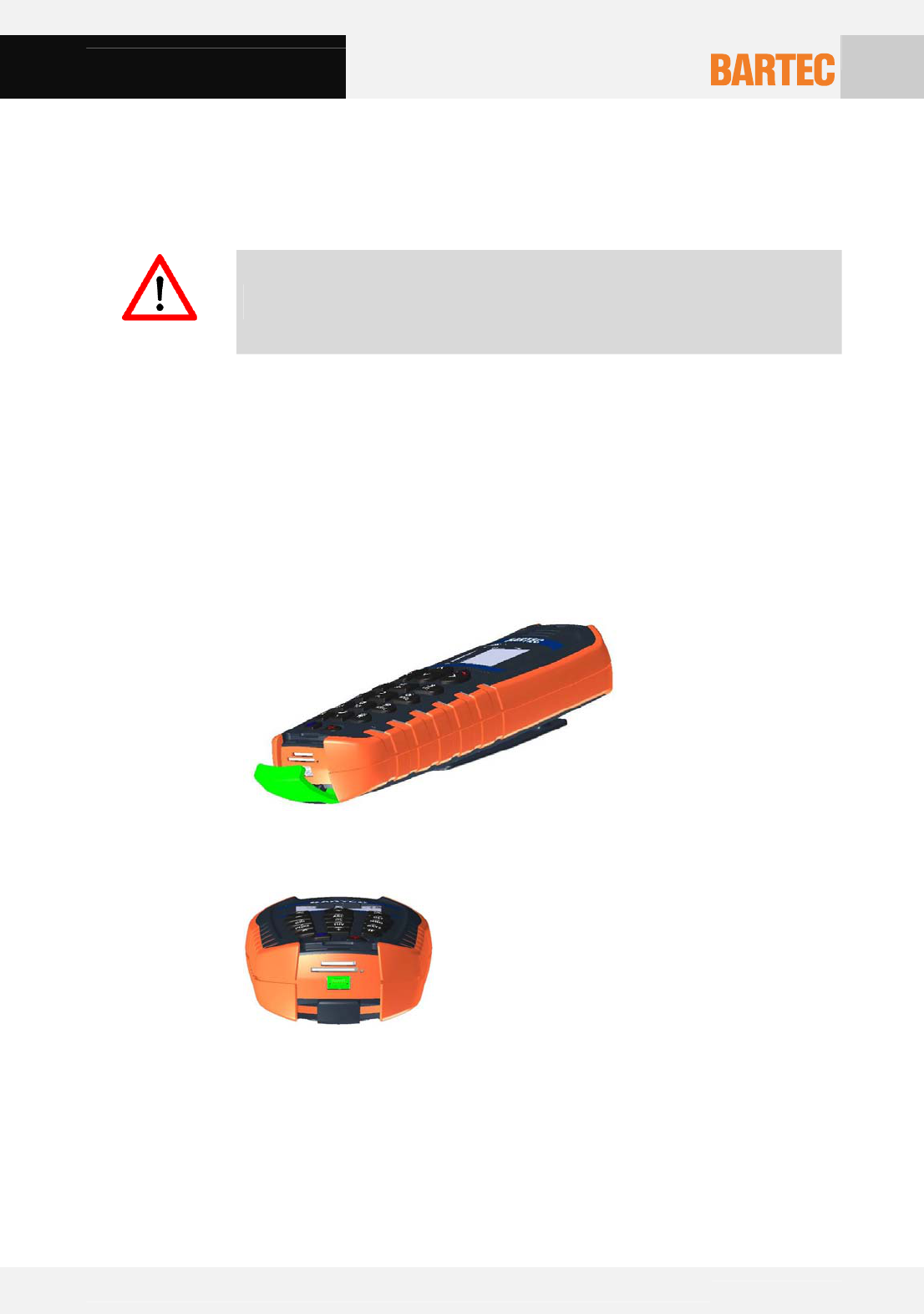
User Manual Pegasus 70xx series
Technical data subject to change without notice.
Issue 01/2010 Page 20 of 44
Danger!
The battery may only be charged with listed chargers outside the hazardous area!
¨ Open the cover to access the connections.
¨ Connect the charger cable to the mini USB slot as shown on figure 14.
¨ The charging status of the battery is shown on the right side of the
screen.
¨ After charging, remove the mini USB cable and close the cover.
Figure 13: Pegasus 70xx open cover
Figure 14: Pegasus 70xx open cover
4.5 Charging the battery
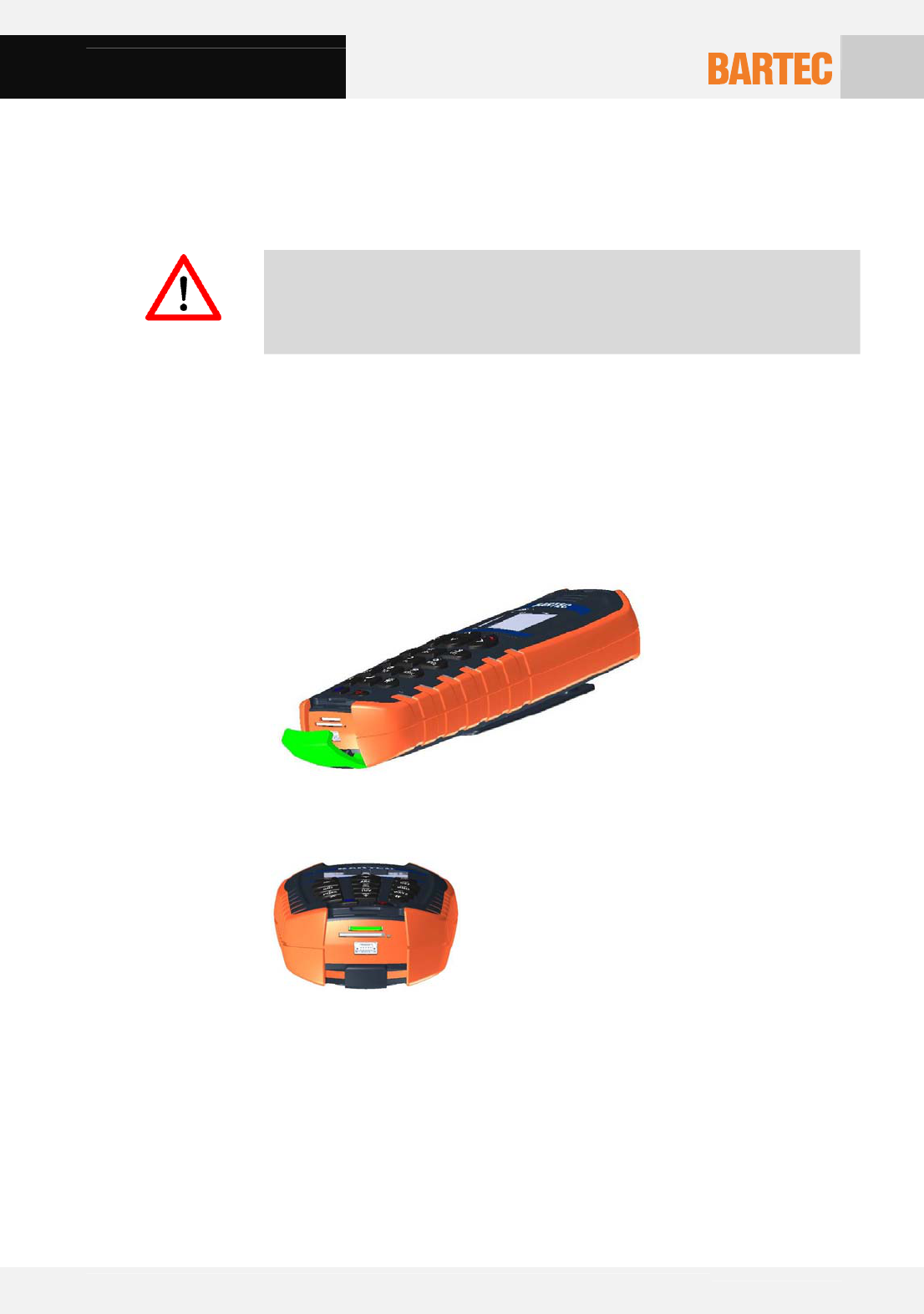
User Manual Pegasus 70xx series
Technical data subject to change without notice.
Issue 01/2010 Page 21 of 44
Danger!
The Micro SD-card may only be inserted or changed outside the hazardous area!
¨ Turn your Pegasus Off
¨ Open the cover to access the connections.
¨ Insert the micro SD-card into the slot as shown in figure 16.
¨ Close the cover.
Figure 15: Pegasus 70xx open cover
Figure 16: Pegasus 70xx micro SD card slot
4.6 Inserting the Micro SD-card
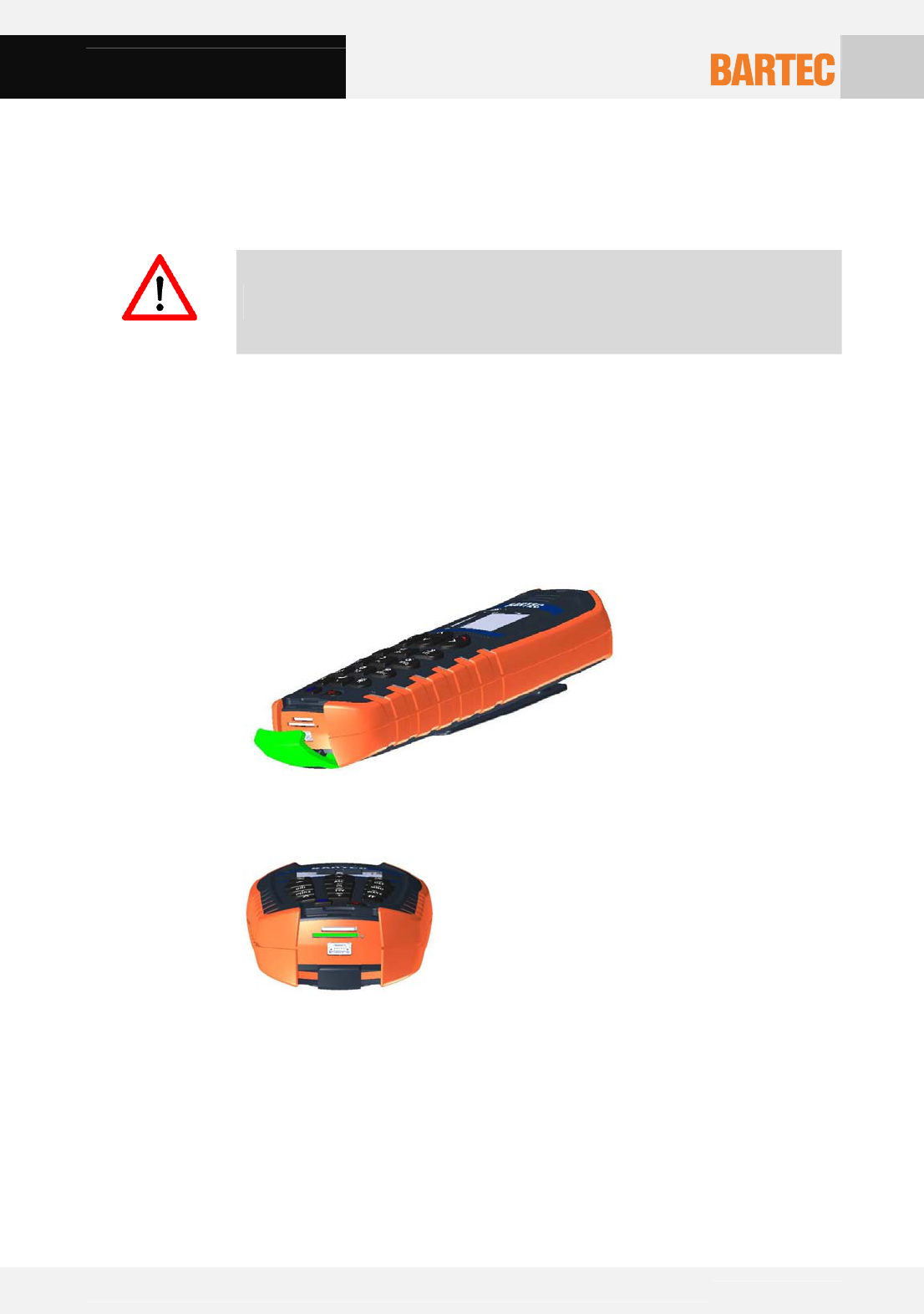
User Manual Pegasus 70xx series
Technical data subject to change without notice.
Issue 01/2010 Page 22 of 44
Danger!
The Micro SD-card may only be inserted or changed outside the hazardous area!
¨ Turn your Pegasus Off
¨ Open the cover to access the connections.
¨ Insert the SIM card into the slot as shown in figure 18.
¨ Close the cover.
Figure 17: Pegasus 70xx open cover
Figure 18: Pegasus 70xx SIM card slot
4.7 SIM card
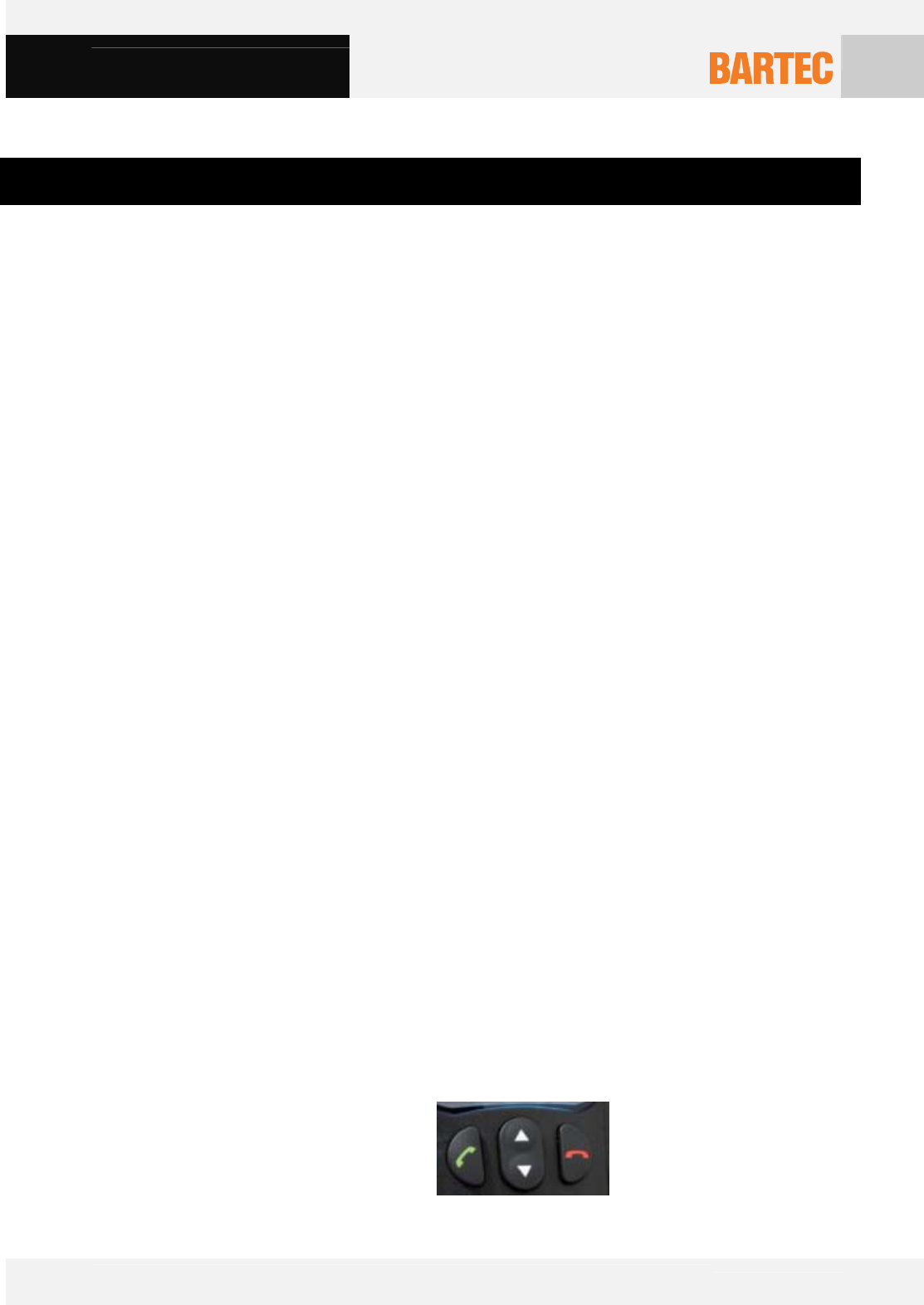
User Manual Pegasus 70xx series
Technical data subject to change without notice.
Issue 01/2010 Page 23 of 44
5 Operation
You are now ready to use your Pegasus 70xx for the first time.
Switch on the Pegasus by pressing the Power ON/OFF key. A start screen appears.
When you switch on your phone for the first time, you must configure it with various
settings that will remain by default until you choose to modify them.
After entering your PIN code, make your choice for the following settings: ring tone,
sound volume, hands-free, vibration, clock/date, man down function, tracking, etc.
If there are contacts saved in your SIM card, you can copy them into the phonebook
memory.
5.1.1 PIN number
This is a secret code for the SIM card. If access to the SIM card is protected, the device
prompts you to enter the PIN number. Enter the 4-digit PIN or customized code and
confirm it with OK.
For security reasons these digits will not appear on the screen.
If the SIM code is not accepted or the card is not recognised, turn the Pegasus Off and
check that the SIM card is inserted correctly in your Pegasus.
If an incorrect PIN number is entered three times in succession, your SIM card will be
blocked. In this case you must do the following:
■ Enter the PUK code provided by your operator.
■ Enter your PIN number and validate the entry.
■ Enter your PIN number again and validate the entry.
After 5 or 10 failed attempts, depending of the type of your SIM card, the SIM card will
be irrevocably locked. In this case you must contact your operator or provider to obtain a
new card.
5.2.1 Navigation Principle
Only 3 keys are needed to navigate through the different menus.
In the menus, a title bar reminds you of the previous level.
Left soft key Right soft key
(to call or OK) (to hang up or Back)
2-way navigation key
5.1 Getting started
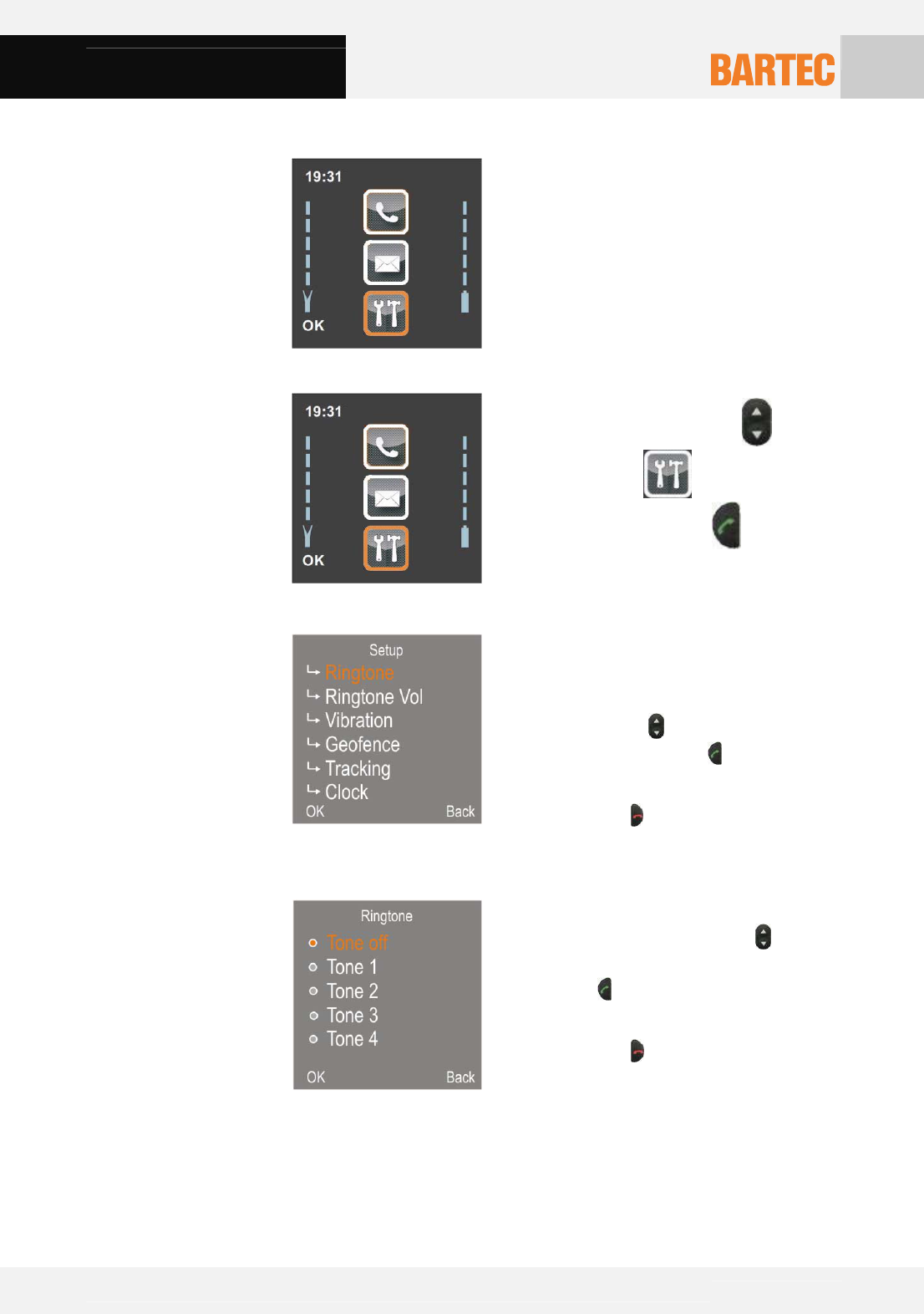
User Manual Pegasus 70xx series
Technical data subject to change without notice.
Issue 01/2010 Page 24 of 44
■ The 2-way navigation key is for the
selection of a menu entry.
■ The left soft key is used to go from a
menu to a sub-menu.
■ The right soft key is used to go from a
sub-menu to a higher-level menu.
5.3.1 General Settings
Use the 2-way navigation key
to select the settings menu and
press the left soft key to enter the
menu for customising your Pegasus 70xx.
Different menus are available for
customising your Pegasus 70xx.
You can select a menu with the 2-way
navigation key and enter the menu by
pressing the left soft key .
You can exit the sub-menu by pressing the
right soft key .
5.1.3.1 Ringtone
Use the 2-way navigation key to select
your ring tone and confirm it with the left
soft key .
You can exit the sub-menu by pressing the
right soft key .
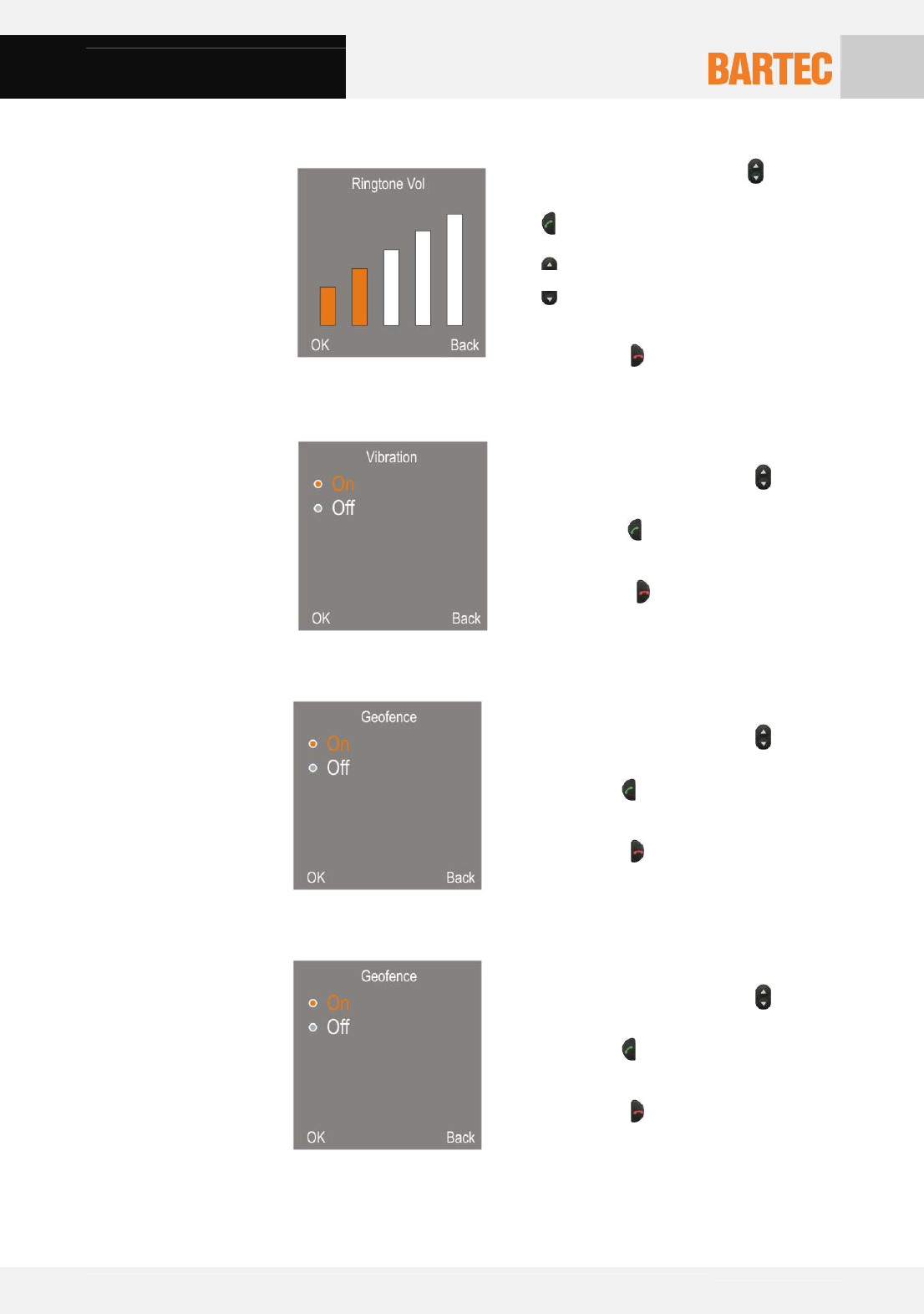
User Manual Pegasus 70xx series
Technical data subject to change without notice.
Issue 01/2010 Page 25 of 44
5.1.3.2 Sound volume
5
Use the 2-way navigation key to change
the volume and confirm with the left soft key
.
loud
low
You can exit the sub-menu by pressing the
right soft key .
5.1.3.3 Vibration
Use the 2-way navigation key to select
Vibration On or Off and confirm it with the
left soft key .
You can exit the sub-menu by pressing the
right soft key .
5.1.3.4 Geofence
Use the 2-way navigation key to select
Geofence On or Off and confirm it with the
left soft key .
You can exit the sub-menu by pressing the
right soft key .
5.1.3.5 Tracking
Use the 2-way navigation key to select
Tracking On or Off and confirm it with the
left soft key .
You can exit the sub-menu by pressing the
right soft key .
5.1.3.6 Clock setting
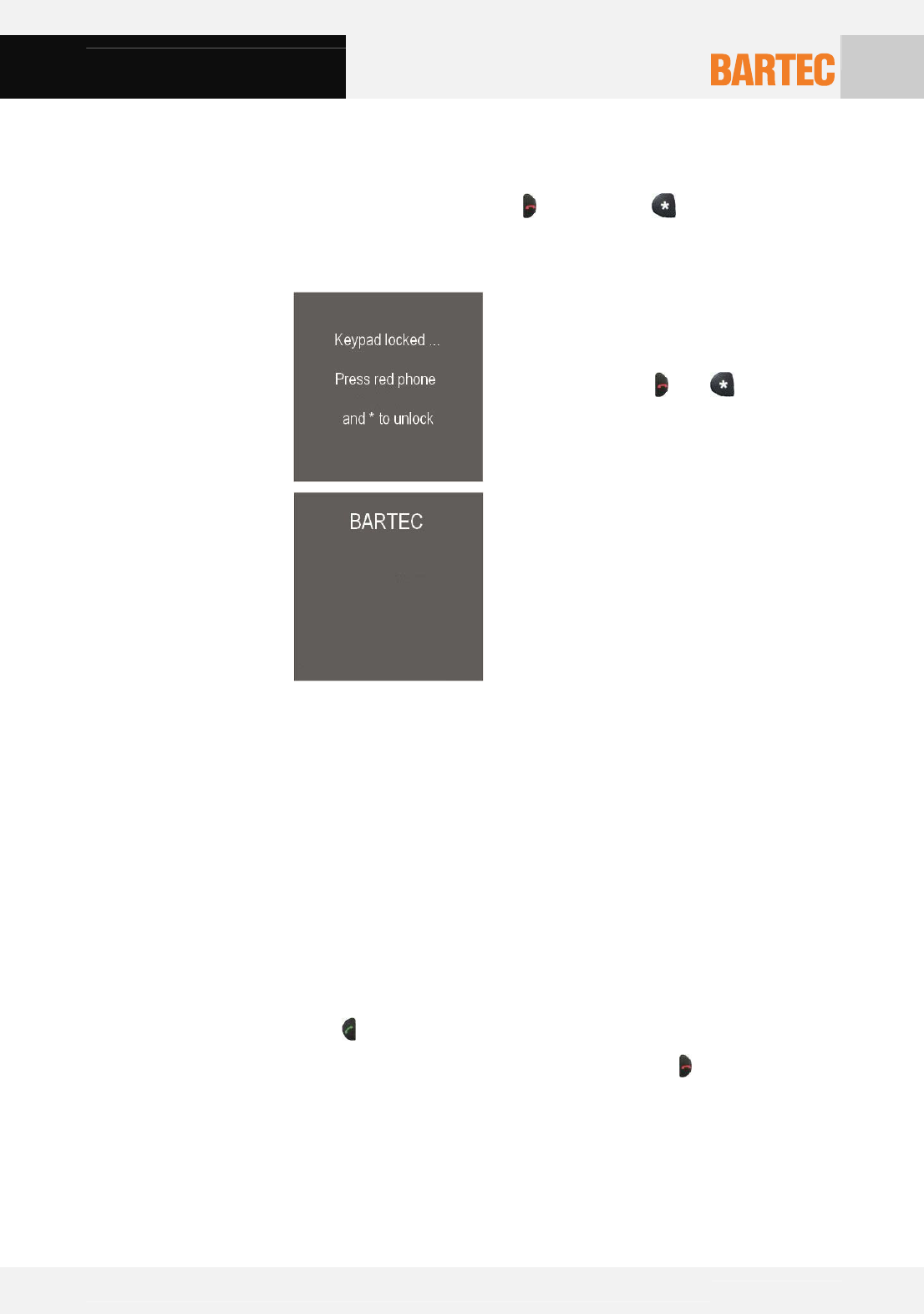
User Manual Pegasus 70xx series
Technical data subject to change without notice.
Issue 01/2010 Page 26 of 44
5.4.1 Key lock
You can lock and unlock the keypad with keypad shortcuts.
To lock or unlock, press the right soft key and the star key .
If the Pegasus 70xx is not in use for longer than 1 minute, the device will switch to
screen saving mode and lock the keys.
When the device is locked and you press a
key, the Press and key message
appears.
Locked keys:
You will see the screensaver.
5.1.2 Making a call
You have different options to establish a call:
¨ Start dial from the start screen.
¨ Start dial from the menu dialpad.
¨ Dial a number from the Phonebook or the SIM card.
5.2.2 Starting dialing from the start screen
¨ Begin to dial the number when you are in the start screen.
Press the left soft key to start the dialling process.
¨ You can cancel or stop the call by pressing the right soft key .
5.2 Phone settings
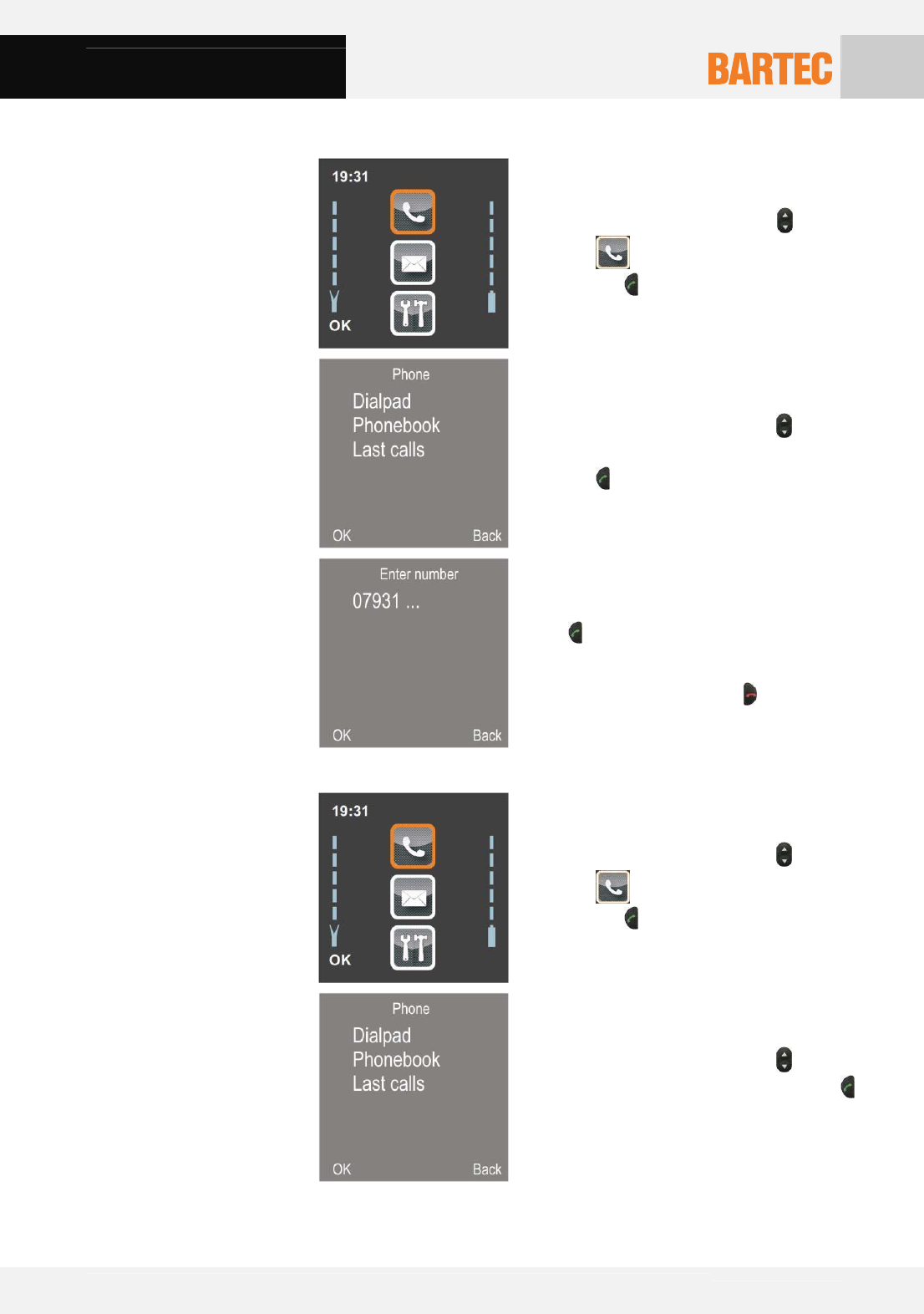
User Manual Pegasus 70xx series
Technical data subject to change without notice.
Issue 01/2010 Page 27 of 44
5.3.2 Starting dialing from the menu
Use the 2-way navigation key to select
the phone menu and press the left
soft key to enter the menu.
Use the 2-way navigation key to select
the “Dialpad” menu and press the left soft
key to enter the sub-menu.
Dial a number and press the left soft key
to start the dialling process.
You can cancel or stop the call by
pressing the right soft key .
5.4.2 Dialing a number from the Phonebook
Use the 2-way navigation key to select
the phone menu and press the left
soft key to enter the menu.
Use the 2-way navigation key to select
the “Phonebook” menu and press the
left soft key to enter the sub-menu.
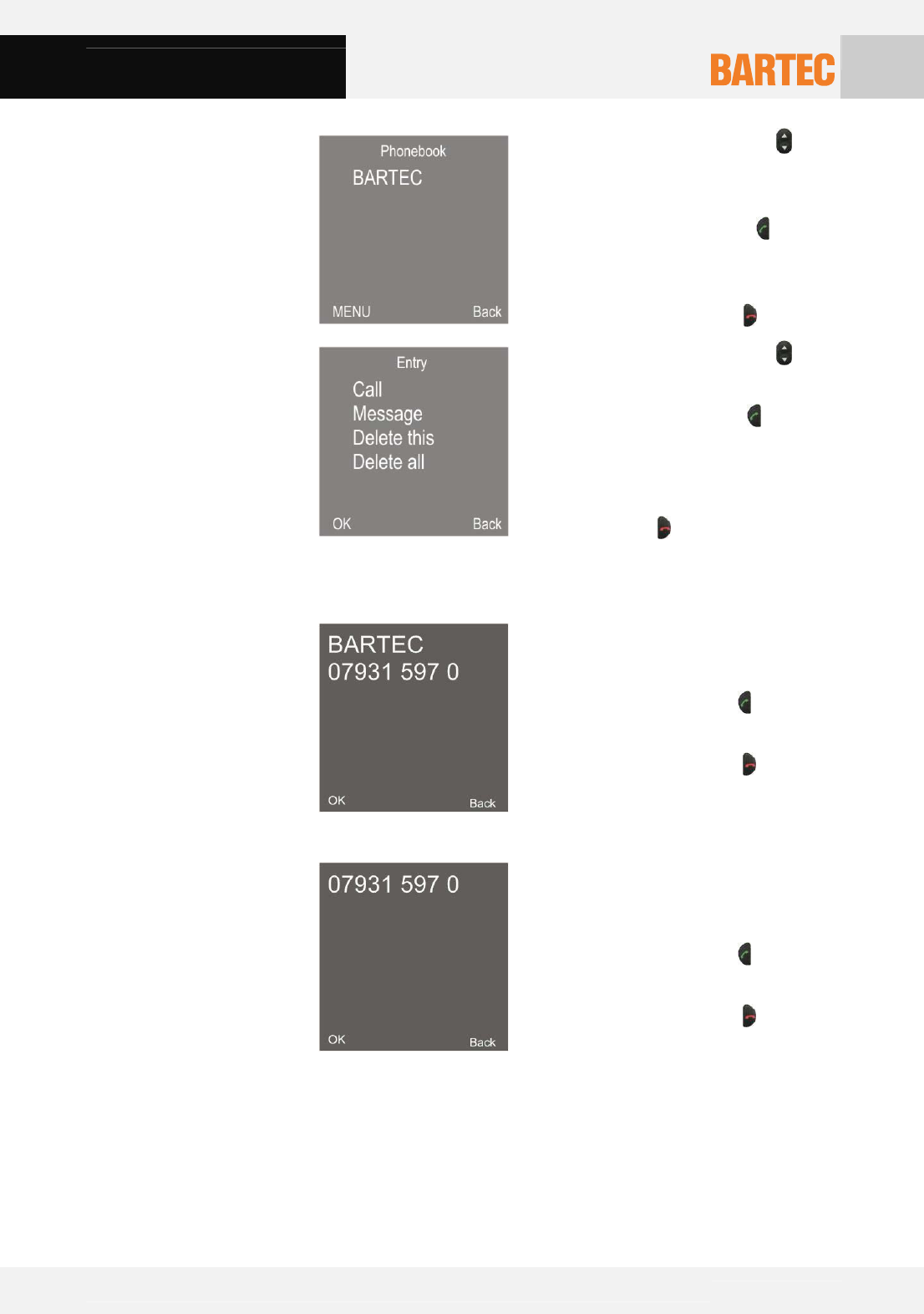
User Manual Pegasus 70xx series
Technical data subject to change without notice.
Issue 01/2010 Page 28 of 44
Use the 2-way navigation key to select
a contact in your “Phonebook” or the “SIM
card”.
First press the left soft key to show the
sub menu of the contact.
You can cancel or stop the call by
pressing the right soft key .
Use the 2-way navigation key to select
a option in your “Phonebook”
Press the left soft key to start the
dialling process, write a message or delete
the Phonebook entry.
You can exit the sub-menu by pressing the
right soft key .
5.5.2 Receiving call
5.6.2 Known call
The name and the number of the incoming
call appear on the screen.
Press the left soft key to accept the
incoming call.
Press the right soft key to refuse the
incoming call.
5.7.2 Unknown call
Only the number of the incoming call
appears on the screen. Only this function
is supported by the network.
Press the left soft key to accept the
incoming call.
Press the right soft key to refuse the
incoming call.
5.8.2 Last call
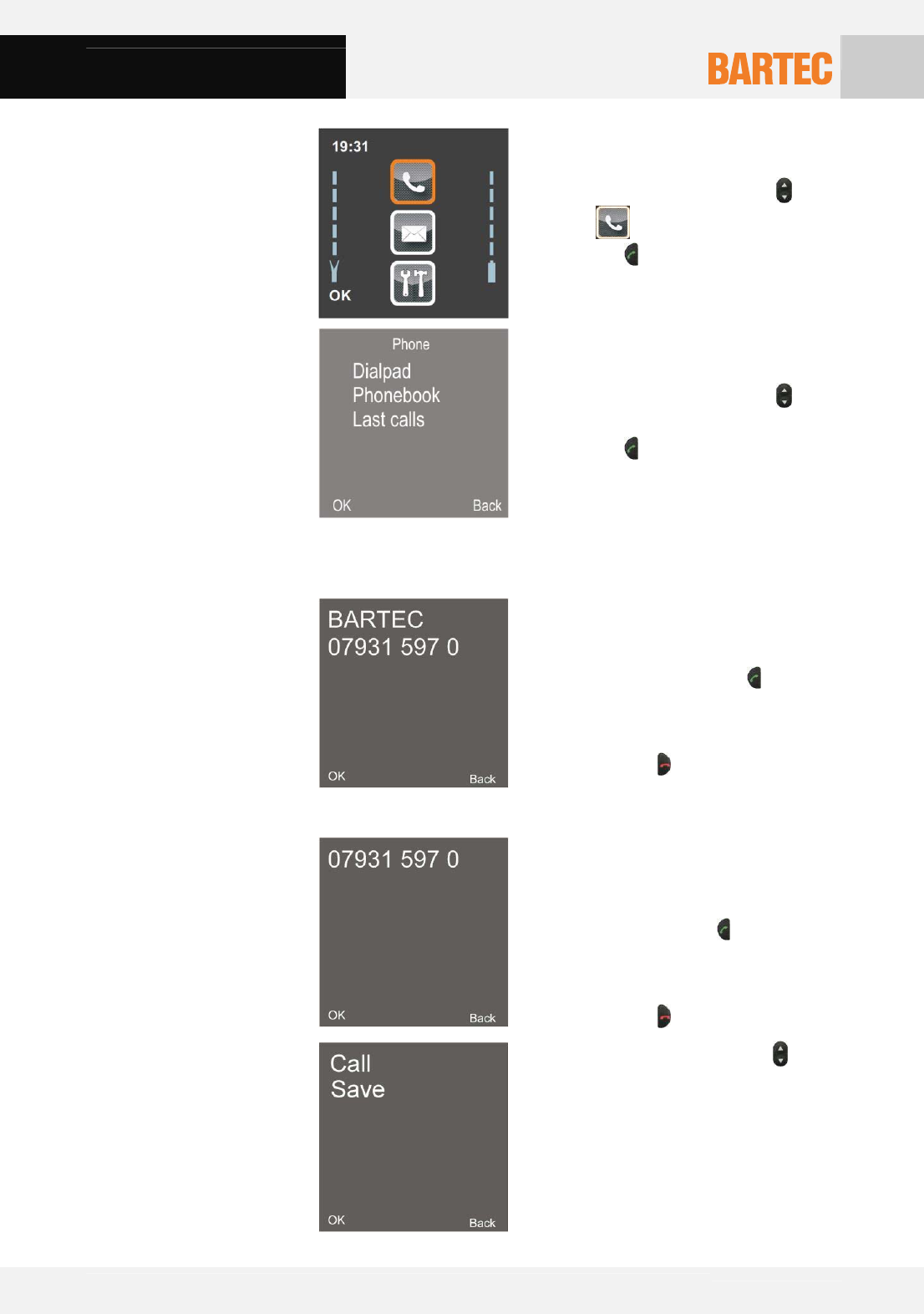
User Manual Pegasus 70xx series
Technical data subject to change without notice.
Issue 01/2010 Page 29 of 44
Use the 2-way navigation key to select
the phone menu and press the left
soft key to enter the menu.
Use the 2-way navigation key to select
the “Last caller” menu and press the left
soft key to enter the sub-menu.
5.9.2 Known call
The name and the number of the incoming
call appear on the screen.
Press the left soft key to start the
dialling process.
You can exit the sub-menu by pressing the
right soft key .
5.10.2 Unknown call
Only the number of the incoming call
appears on the screen. Only this function
is supported by the network.
Press the left soft key to go into the next
sub-menu.
You can exit the sub-menu by pressing the
right soft key .
Use the 2-way navigation key to select
an option.
■ Call start to dial the number.
■ Save save the contact in the
“Phonebook”
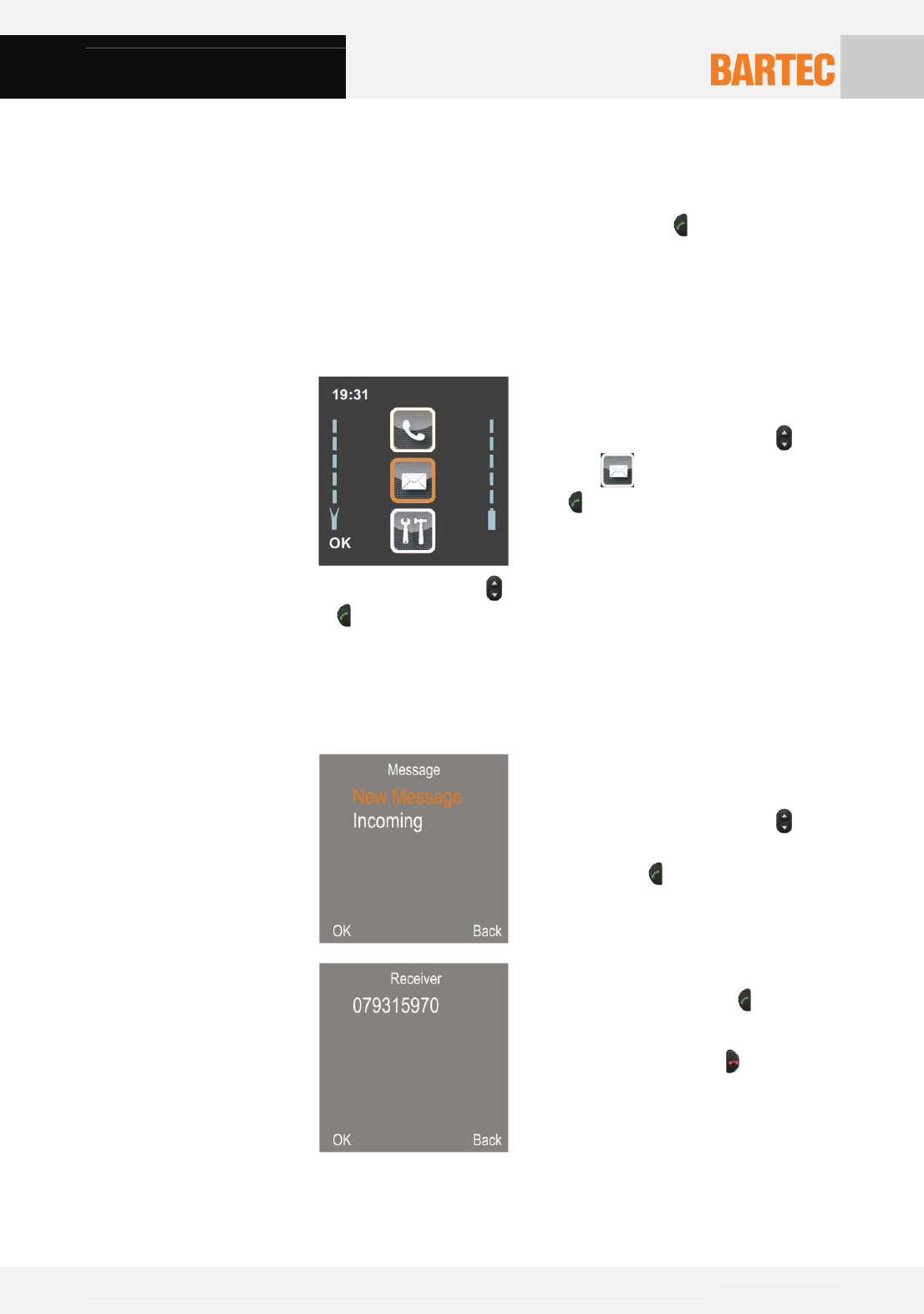
User Manual Pegasus 70xx series
Technical data subject to change without notice.
Issue 01/2010 Page 30 of 44
Save:
Type the name of the contact and save the
contact in your “Phonebook” by pressing
the left soft key .
5.1.3 SMS Options
Use the 2-way navigation key to select
the “Message” menu and press the
left soft key to enter the menu.
Use the 2-way navigation key to select your option in the “Message” menu and
press the left soft key to enter the sub-menu.
■ New message Write a new message and send to a contact/s.
■ Incoming Received SMS are stored in the Inbox.
5.2.3 Creating a new message
Use the 2-way navigation key to select
the “New message” menu and press the
left soft key to enter the menu.
Enter the number of the Receiver.
Press the left soft key to accept the
number.
Press the right soft key to delete the last
character entered and to exit the sub-
menu
5.3 SMS (Short Message Service) Settings
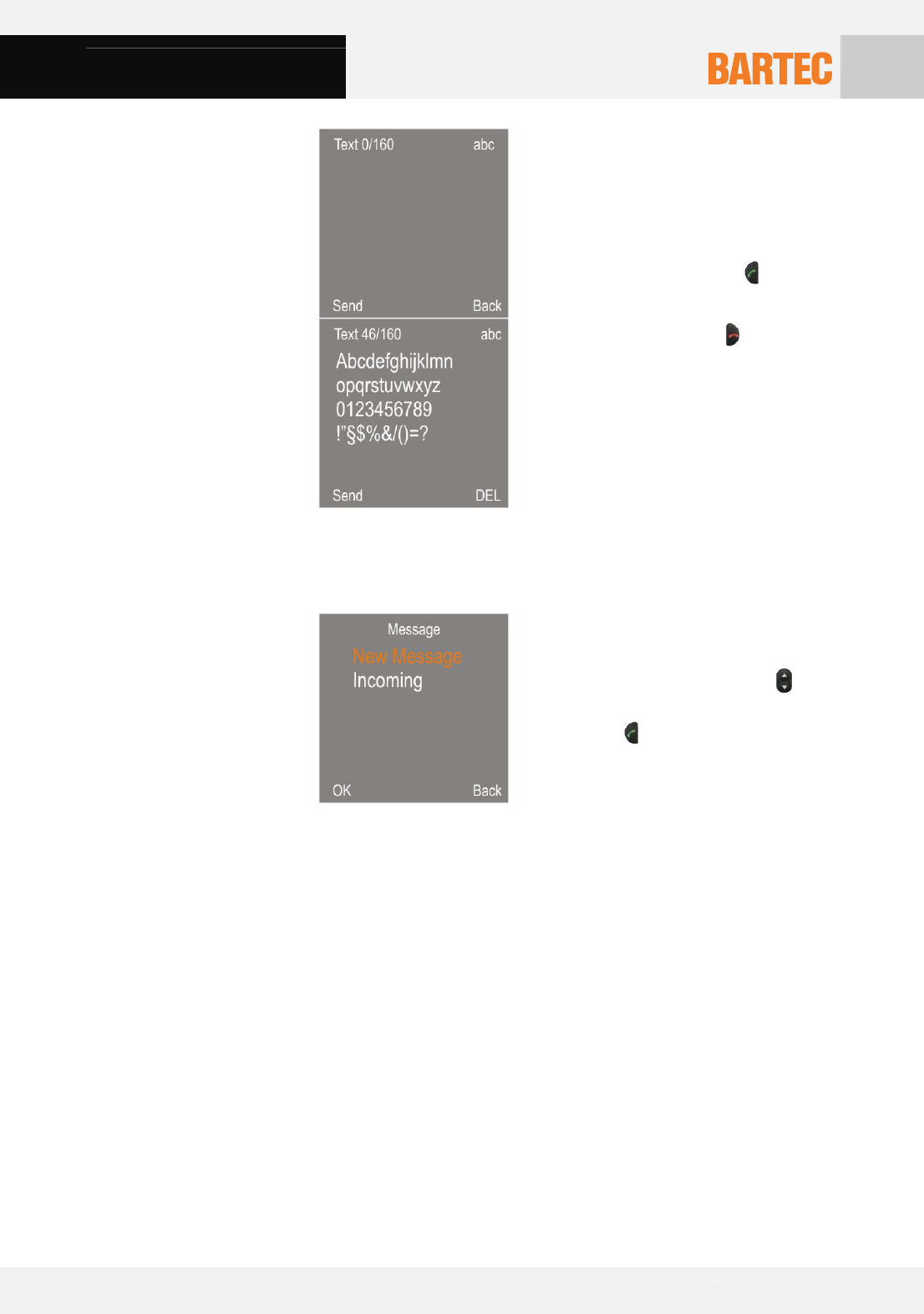
User Manual Pegasus 70xx series
Technical data subject to change without notice.
Issue 01/2010 Page 31 of 44
Enter the text in the field.
Press the left soft key to send the
message
Press the right soft key to delete the last
character entered.
5.3.3 Incoming
All messages received are stored in this
menu.
Use the 2-way navigation key to select
the “Incoming” menu and press the left
soft key to enter the menu.
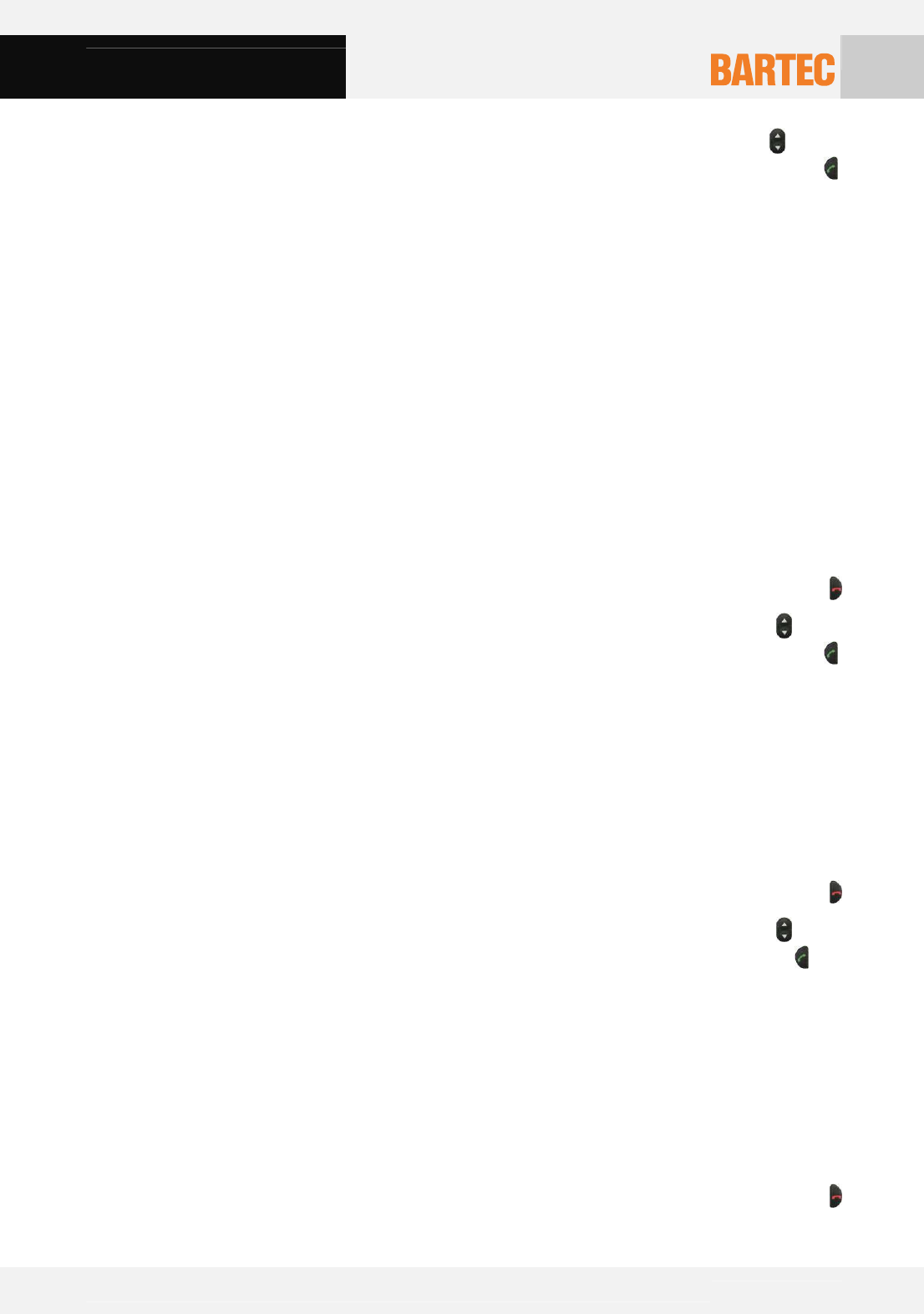
User Manual Pegasus 70xx series
Technical data subject to change without notice.
Issue 01/2010 Page 32 of 44
Use the 2-way navigation key to choose
a message and press the left soft key to
read it.
■ Messages are listed chronologically.
■ The newest message is listed first.
■ Unread messages are highlighted
with a bold font.
Options:
■ Read the message.
■ Delete the message.
■ Forward the message.
■ Answer the message.
You can exit the sub-menu or the
message by pressing the right soft key .
Use the 2-way navigation key to select
a message and press the left soft key to
read it.
Options:
■ Send the message again
■ Forward the message
■ Delete the message.
You can exit the sub-menu or the
message by pressing the right soft key .
Use the 2-way navigation key to select
a draft and press the left soft key to edit
it.
Options:
■ Send the message
■ Edit the message
■ Delete the message.
You can exit the sub-menu or the
message by pressing the right soft key .

User Manual Pegasus 70xx series
Technical data subject to change without notice.
Issue 01/2010 Page 33 of 44
6 Maintenance, Inspection, Repair
Caution!
Only trained and qualified personnel may commission and do maintenance work on the
Pegasus 70xx series! Trained qualified personnel are people who are familiar with the
installation, assembly, commissioning and operation of the Pegasus 70xx series, have
been instructed about the risks and have the appropriate qualifications by virtue of the
work they do.
Maintenance intervals
The mechanical status of the devices should be checked at regular intervals. The length
of the maintenance intervals depends on the ambient conditions. We recommend
checking at least once a year. Regular maintenance is not necessary if operated
appropriately in conformance with the installation instructions and with due consideration
to the ambient conditions.
Inspection
Under IEC 60079-19 and EN 60079-17, the owner/managing operator of electrical
installations in hazardous areas is obliged to have these installations checked by a
qualified electrician to ensure that they are in a proper condition.
Servicing
Adhere to the applicable regulations under Directive 99/92/EC, IEC 60079-19 and IEC
60079-17 when servicing, doing maintenance work on and testing associated operating
equipment!
Assembly/disassembly, operating and maintenance work may be done only by trained
specialists. The statutory rules and other binding directives on workplace safety,
accident prevention and environmental protection must be observed.
Observe the national waste disposal regulations when disposing of the equipment.
Instructions for Repairs
If you wish to send in a defective device for repair, please read the RMA procedure
guidance first. Then fill in and sign the RMA (Return Merchandise Authorization) form
and send it to our "Retouren Center".
Email: services@bartec.de Fax: +49 7931 597-119
We cannot guarantee any contractually agreed processing times for devices that are
sent in without an RMA number.
The RMA guide and the RMA form are available on our homepage for downloading.
http://www.bartec-group.de Quality and culture RMA form
Have you any questions? Write us an e-mail or call us.
E-mail: services@bartec.de Phone: +49 7931 597-444
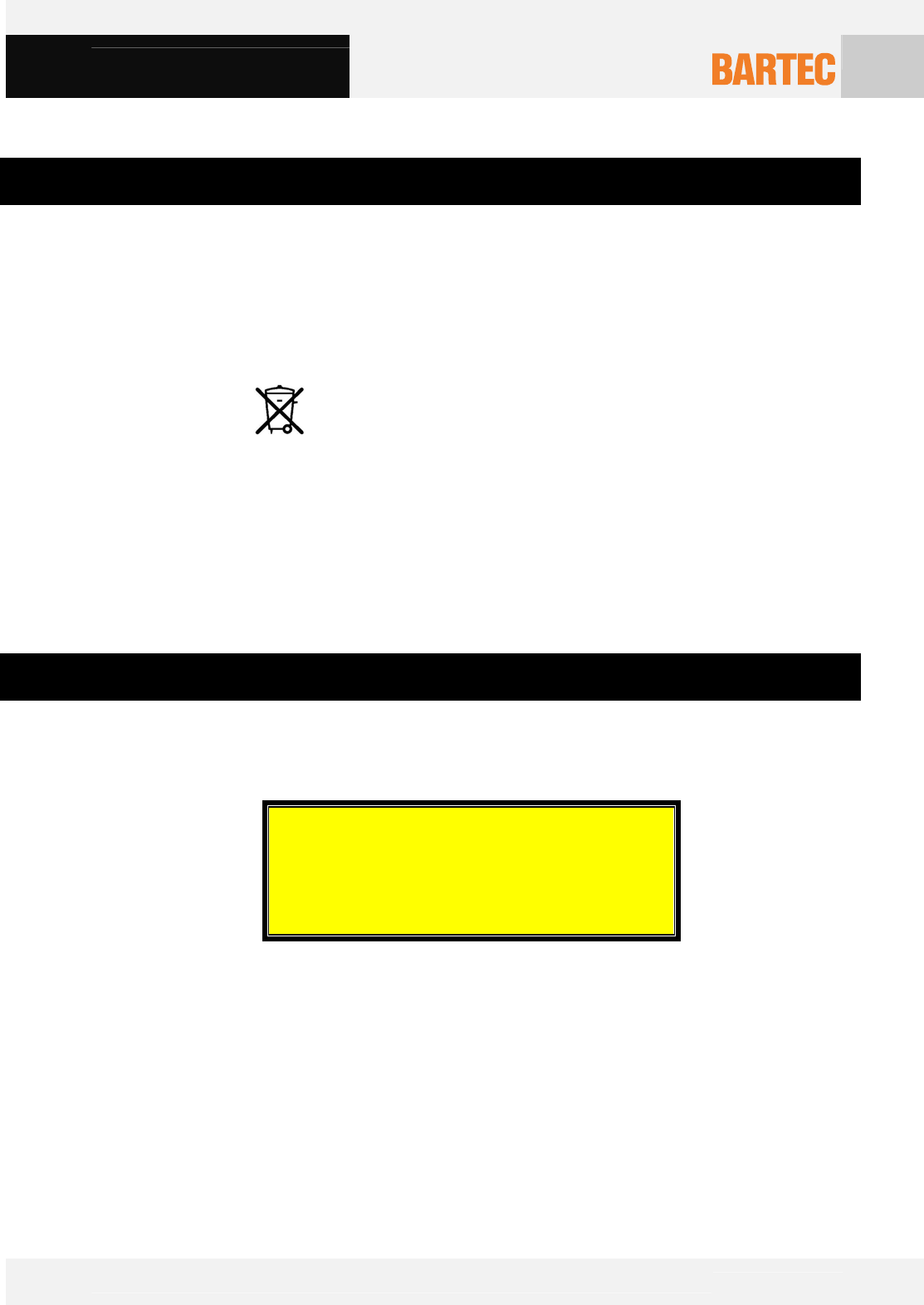
User Manual Pegasus 70xx series
Technical data subject to change without notice.
Issue 01/2010 Page 34 of 44
7 Disposal
Battery packs should not be disposed of in general household waste. Observe the local
waste disposal regulations, which you can find out about contacting your local authority.
All electrical and electronic products should be disposed of separately from the
municipal waste stream via designated collection facilities appointed by the government
or the local authorities.
This crossed-out wheeled bin symbol on the product means the product is
covered by the European Directive 2002/96/EC
The correct disposal and separate collection of your old appliance will help prevent
potential negative consequences for the environment and human health. It is a
precondition for reuse and recycling of used electrical and electronic equipment.
For more detailed information about disposal of your old appliance, please contact your
local council refuse centre or the original supplier of the product.
8 Dispatch and Packaging Instructions
Important information regarding transport and dispatch
! Sensitive Devices!
It is essential to send in the device in the
original packaging to prevent damage to
the device.

EC-Declaration of
Conformity Pegasus 70xx series
Technical data subject to change without notice.
Issue 01/2010

Technical data subject to change without notice.
Issue 01/2010 Page 36 of 44
PEGASUS_UserMan

GmbH
Max-Eyth-Straße 16 Phone: +49 7931 597-0 Contact:
97980 Bad Mergentheim Fax: +49 7931 597-119 info@bartec.de
Germany
User Manual
Pegasus 70xx Series
Pegasus 7000 Type G7-C010-*Q*1/0000
Pegasus 7010ex Type 17-C110-*Q*1/0000
Pegasus 7020ex Type B7-C210-*Q*1/0000
Document No. 11-C110-7D0001
Status: 17. February 2010
Technical subject to change!
Contents Page
English 1 - 44
Appendix EC-Declaration of Conformity
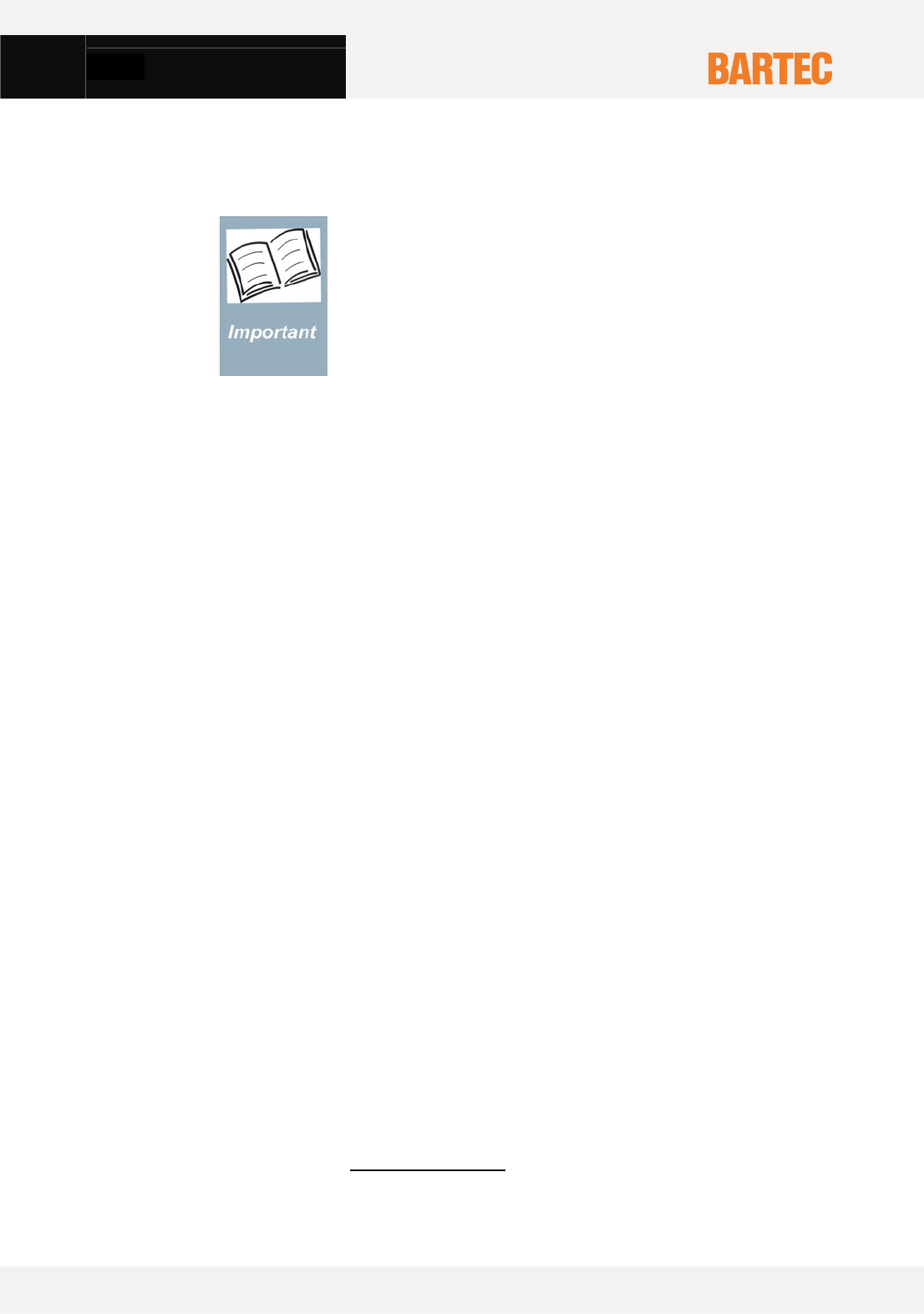
Safety
Technical data subject to change without notice.
Issue 01/2010
The user manual is a constituent part of the product and must be kept in
the direct vicinity of the device and accessible at all times to installation,
operating and maintenance personnel.
It contains important notes, safety instructions and test certificates which
are necessary for perfect functioning when the devices are being
operated and handled. It is written for technically qualified personnel.
Familiarity with and the technically perfect implementation of the safety
instructions and warnings described in this manual are preconditions for
safe installation and commissioning. The safety notes and warnings
given in this documentation are given in a general way and only qualified
personnel will have the necessary specialized know-how to interpret and
implement them correctly in specific cases.
Qualifications of the personnel working with the devices
The user manual is written for all people who carry out assembly,
installation, commissioning and service work on the product, whereby
the directives and standards must be observed.
For Europe:
99/92/EC, EN 60079-17, EN 60079-19 for the gas area
EN 61241-17 and EN 61241-19 for the dust area
For North America:
NEC 500.
For other countries or regions:
National directives and standards must be observed.
Changes to the document
BARTEC reserves the right to alter the contents of this document without
notice. No guarantee is given for the correctness of the information. In
case of doubt the German safety instructions shall apply because it is
not possible to rule out errors in translation or in printing. In the event of
a legal dispute, the “General Terms and Conditions” of the BARTEC
group shall apply in addition.
The respective up-to-date versions of data sheets, manuals, certificates,
EC Declaration of Conformity may be downloaded from the “Ex
Visualization and Communication Systems” product page at
www.bartec-group.com or ordered directly from BARTEC GmbH.
Notes on this manual
Read carefully
before putting
the devices
into operation.

Safety
Technical data subject to change without notice.
Issue 01/2010
The documents are currently available in German and English.
The product described in this manual has been tested and left the
factory in perfect condition as regards meeting safety requirements.
To maintain this condition and ensure that this product operates
perfectly and safely, it may be used only in the manner described by the
manufacturer. Appropriate transportation, suitable storage and careful
operation are also essential for the perfect and safe operation of this
product.
The Pegasus 70xx series has been constructed in conformance to the
latest technical developments and the recognized safety regulations.
Nevertheless, its use can still cause danger to life and limb of the user
or damage the device and other property.
The Pegasus 70xx series is available in three versions:
Pegasus 7000 Type G7-C010-*Q*1/0000
was developed for use in non Ex environment.
Pegasus 7010ex Type 17-C110-*Q*1/0000
was developed specially for use in hazardous areas in ATEX Zone 1 /
21, IECEx and UL Class I, II, III Division 1.
Pegasus 7020ex Type B7-C210-*Q*1/0000
was developed specially for use in hazardous areas in ATEX Zone 2 /
22 and UL Class I, II, III Division 2.
The manufacturer will not be liable for any ensuing damage. The risk
shall be borne by the user alone. Use for the intended purpose requires
also the observation of the operating instructions. Only people who are
familiar with the Pegasus 70xx series and instructed about the risks it
poses may use it or do any maintenance work on it.
Handing the Product
Use for the Intended Purpose
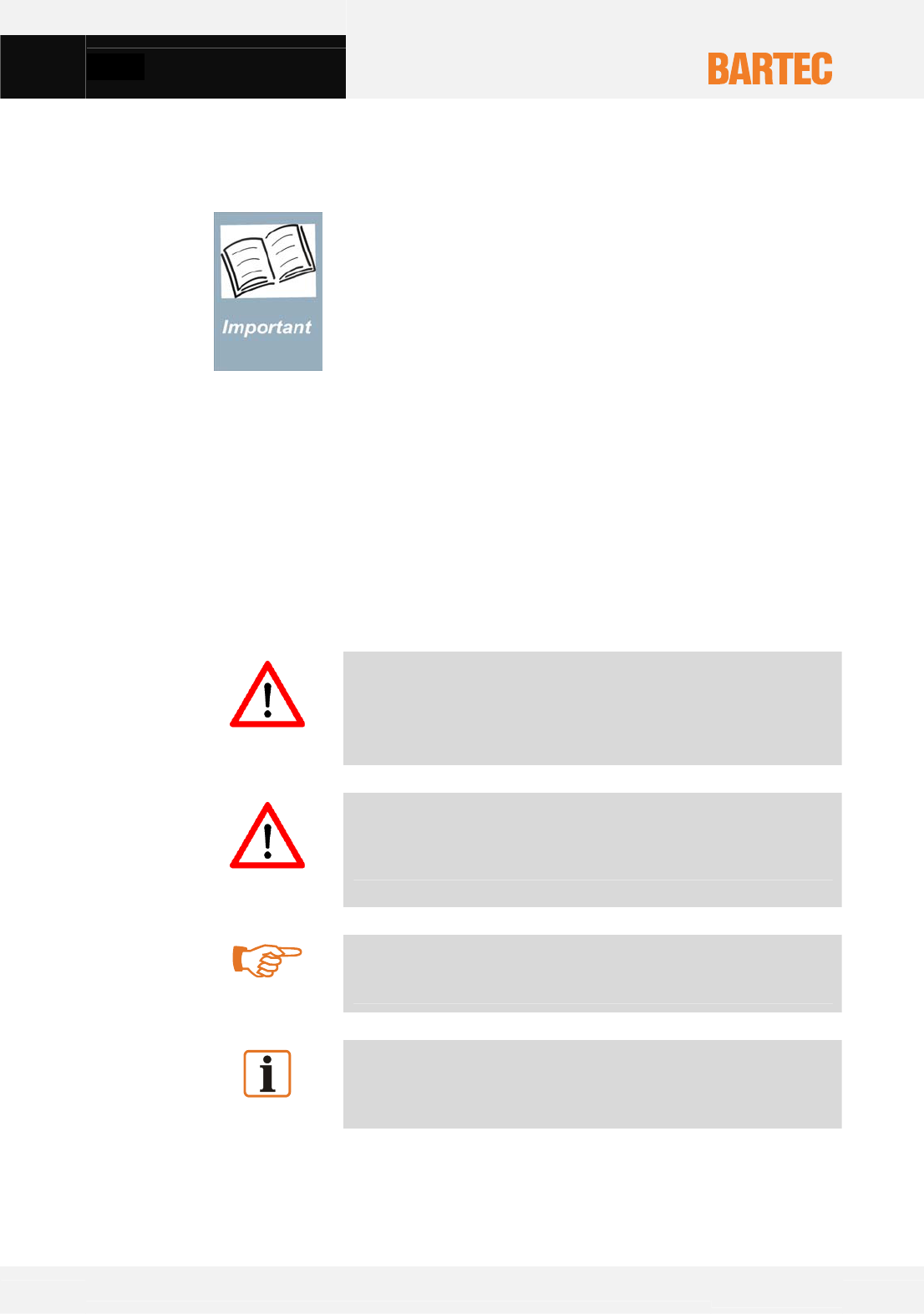
Safety
Technical data subject to change without notice.
Issue 01/2010
Safety instructions and warnings are specially highlighted in this manual
and marked by symbols.
The safety instructions and warnings are assigned to the individual work
steps. Careful handling and consistent observation of the instructions will
prevent accidents, personal injuries and damage to property.
The adherence to all directions and safety instructions in this manual is a
precondition for safe working and the correct handling of the device.
The graphic representations in these instructions serve to show the
information being described and are not necessarily true to scale and
they may deviate slightly from the actual construction of the device.
Particularly important points in these instructions are marked with a
symbol:
Danger!
Non-observance leads to death or serious physical injury. The
necessary safety measures must be taken.
Caution!
Warning of damage to property and financial and penal
disadvantages (e.g. loss of guarantee rights, liability etc.).
Attention
Important instructions and information on preventing
disadvantageous behavior.
Note
Important instructions and information on effective, economical
and environmentally compatible handling.
Safety Instructions
Marking
Read carefully
before putting
the devices
into operation.

Contents
Technical data subject to change without notice.
Issue 01/2010
1 Product Description....................................................................................................................................3
1.1 Definition .........................................................................................................................................3
2 Specification Pegasus 70xx series............................................................................................................5
2.1 Specification Pegasus 7000, type G7-C010-*Q*1/0000..................................................................5
2.1.1 Marking ...........................................................................................................................................5
2.2.1 Technical data.................................................................................................................................5
2.2 Specification Pegasus 7010ex, type 17-C110-*Q*1/0000...............................................................6
2.1.2 Ex protection marking .....................................................................................................................6
2.2.2 Technical data.................................................................................................................................6
2.3 Specification Pegasus 7020ex, type B7-C210-*Q*1/0000 ..............................................................7
2.1.3 Ex protection marking .....................................................................................................................7
2.2.3 Technical data.................................................................................................................................7
2.4 Product Marking..............................................................................................................................8
3 Safety and Security.....................................................................................................................................9
3.1 General Information ........................................................................................................................9
3.2 Notes of Handling............................................................................................................................9
3.3 Battery Safety................................................................................................................................10
3.4 Health and Safety recommendations ............................................................................................12
3.5 Exposure to RF energy .................................................................................................................12
3.6 Driving...........................................................................................................................................12
3.7 Electronic devices .........................................................................................................................12
3.8 Vehicle electronic equipment ........................................................................................................13
3.9 Medical electronic equipment........................................................................................................13
3.10 Aircraft...........................................................................................................................................13
3.11 Children.........................................................................................................................................13
3.12 Blasting areas ...............................................................................................................................13
3.13 Potentially explosive atmospheres................................................................................................13
3.14 Safety Standards...........................................................................................................................14
3.15 RF Exposures ...............................................................................................................................14
3.16 Statement of the UL ......................................................................................................................15

Safety
Technical data subject to change without notice.
Issue 01/2010
4 Commissioning .........................................................................................................................................16
4.1 Purchased parts in packages........................................................................................................16
4.2 Functional Parts of the device.......................................................................................................16
4.3 Fastening and Changing the belt clip............................................................................................18
4.4 Inserting and Changing the battery ...............................................................................................19
4.5 Charging the battery......................................................................................................................20
4.6 Inserting the Micro SD-card ..........................................................................................................21
4.7 SIM card........................................................................................................................................22
5 Operation ...................................................................................................................................................23
5.1 Getting started...............................................................................................................................23
5.1.1 PIN number...................................................................................................................................23
5.2.1 Navigation Principle ......................................................................................................................23
5.3.1 General Settings ...........................................................................................................................24
5.4.1 Key lock.........................................................................................................................................26
5.2 Phone settings ..............................................................................................................................26
5.1.2 Making a call .................................................................................................................................26
5.2.2 Receiving call................................................................................................................................28
5.3.2 Last call.........................................................................................................................................28
5.3 SMS (Short Message Service) Settings........................................................................................30
5.1.3 SMS Options.................................................................................................................................30
5.2.3 Creating a new message ..............................................................................................................30
5.3.3 Incoming........................................................................................................................................31
6 Maintenance, Inspection, Repair .............................................................................................................33
7 Disposal .....................................................................................................................................................34
8 Dispatch and Packaging Instructions .....................................................................................................34
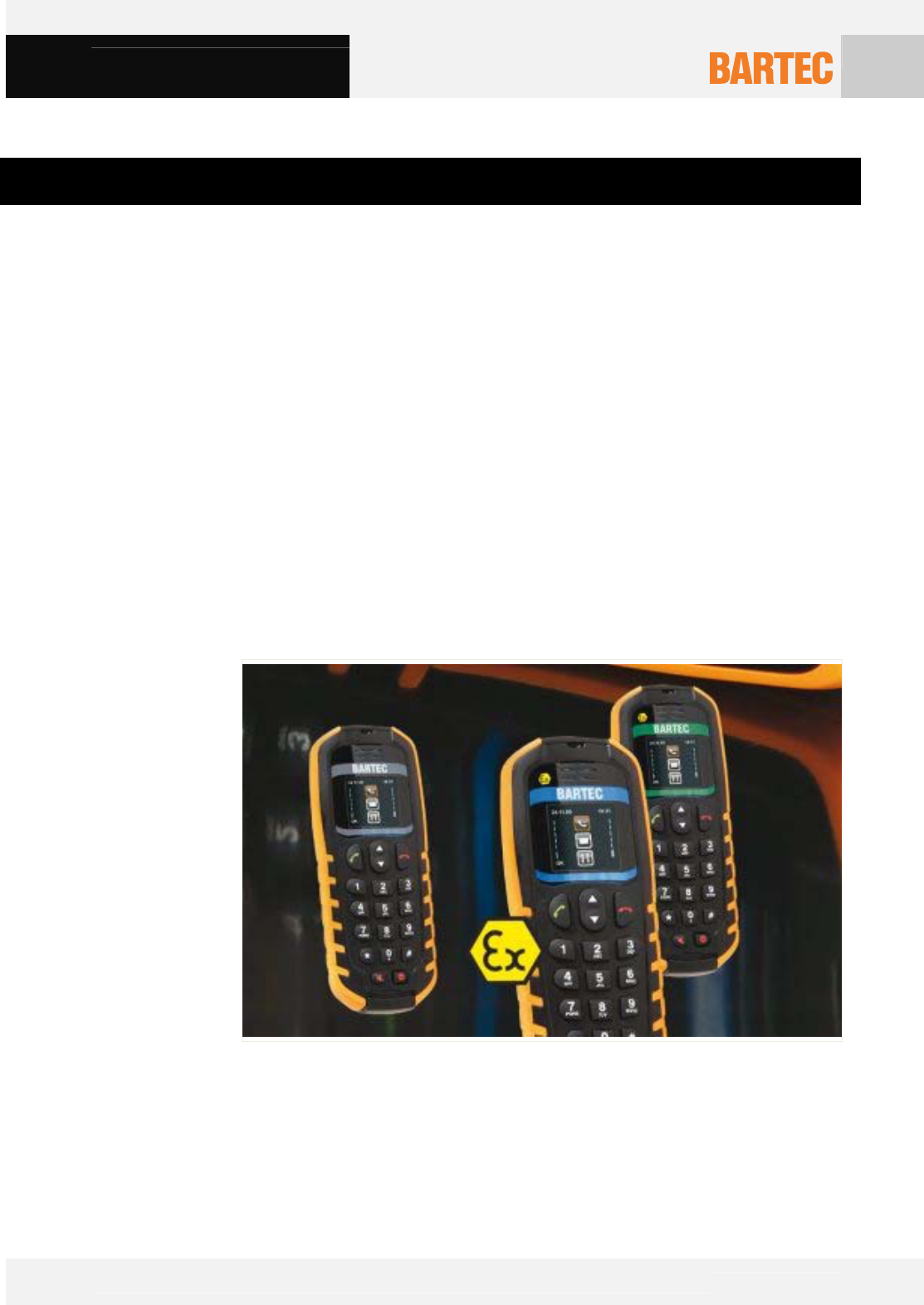
User Manual Pegasus 70xx series
Technical data subject to change without notice.
Issue 01/2010 Page 3 of 44
1 Product Description
PEGASUS 70xx series - the All in One Solution
PEGASUS is the new mobile phone/online tracking system for industry. It is perfect for
utilization in extreme conditions in the chemicals and pharmaceuticals industries and
also in the oil and gas industry. PEGASUS is robust, simple to use and comes in an
attractive distinctive design. „Made by BARTEC“ stands for top quality, long product
availability and excellent service.
PEGASUS 70xx series is available in different models and is the optimal mobile phone
for every region and every field of application:
- PEGASUS 7000 (industrial version)
- PEGASUS 7010ex (ATEX Zone 1,2, 21,22, IEC Ex ; UL Class I, II, III, Div 1, Div 2)
- PEGASUS 7020ex (ATEX Zone 2, 22 ; UL Class I, II, III Div 2)
Figure 1: Pegasus 70xx series
1.1 Definition

User Manual Pegasus 70xx series
Technical data subject to change without notice.
Issue 01/2010 Page 4 of 44
User-friendly keyboard
The keyboard is generously dimensioned and offers enough space for steady operation,
even with gloves. To prevent operating errors, all keys give tactile feedback in the form
of a click.
Quad Band GSM Module
PEGASUS knows no boundaries. With the Quad Band GSM module
(850/900/1800/1900 MHz) the device is ideally equipped for utilization on all continents.
Hands-free function
Workplace safety is the keyword where simultaneous working and phoning are
concerned. PEGASUS has a convenient hands-free function and emits a vibration alarm
at the same time as the ring tone.
Professional Online Tracking System
GPS receivers and special software make PEGASUS an efficient online tracking system.
The „history“ function provides a map showing movement along a route. This opens up
new possibilities for transporters of hazardous goods and other logistical tasks. You can
choose to store and evaluate the PEGASUS data on your own server or use the server
BARTEC has set up especially for it.
Man down function
PEGASUS is the perfect mobile phone for protecting individuals in extreme areas. The
fitted sensor (motion detection) reacts to the absence of movement and triggers an
online alarm after a defined period of time. The device is located by means of GPS. A
flag on a scalable map shows the location detected. The alarm including the GPS
position data can also be forwarded as a text message or as a voice message on a
phone.
Bright display
The OLED Full Color Display promises good legibility at all times, even in bad lighting
conditions.
Long talk time
The unusually long talk time is based on a high performance, rechargeable lithium
polymer battery.
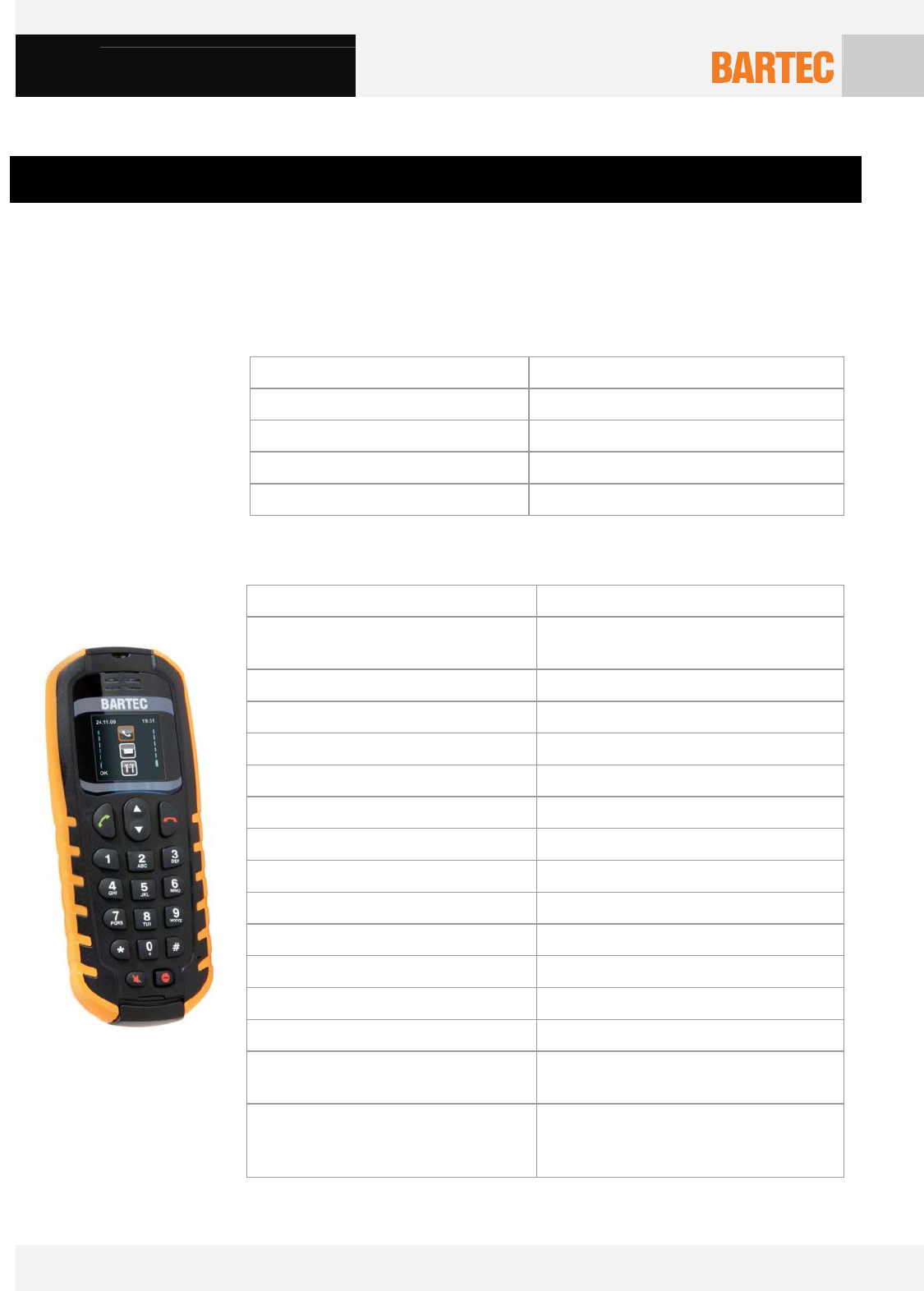
User Manual Pegasus 70xx series
Technical data subject to change without notice.
Issue 01/2010 Page 5 of 44
2 Specification Pegasus 70xx series
2.1 Specification Pegasus 7000, type G7-C010-*Q*1/0000
2.1.1 Marking
Type G7-C010-*Q*1/0000
Marking CE marking
Standards EN 60950-1
Directives -
2.2.1 Technical data
Display OLED color display
Networks Quad Band GSM
850/900/1800/1900 MHz
Dimensions (Height x Width x Depth) 155 mm x 59 mm x 27 mm
Weight approx. 240 g
IP rating IP 65
Ambient temperature -20 °C to +60 °C
Storage and transport temperature -20 °C to +60 °C
Charging temperature 0 °C to +50 °C
Air humidity 5 % up to 95 % (non-condensing)
GSM module Telit GE864
Power supply lithium polymer battery 3,7 V/2650 mAh
Interfaces mini USB
Audio system microphone and speaker integrated
Antennas integrated in the device (GPS and GSM)
Scope of supply includes battery, charger and USB
transmission cable
Accessories – Desktop charger
– Holster
– Micro SD card 1 GB or 2 GB
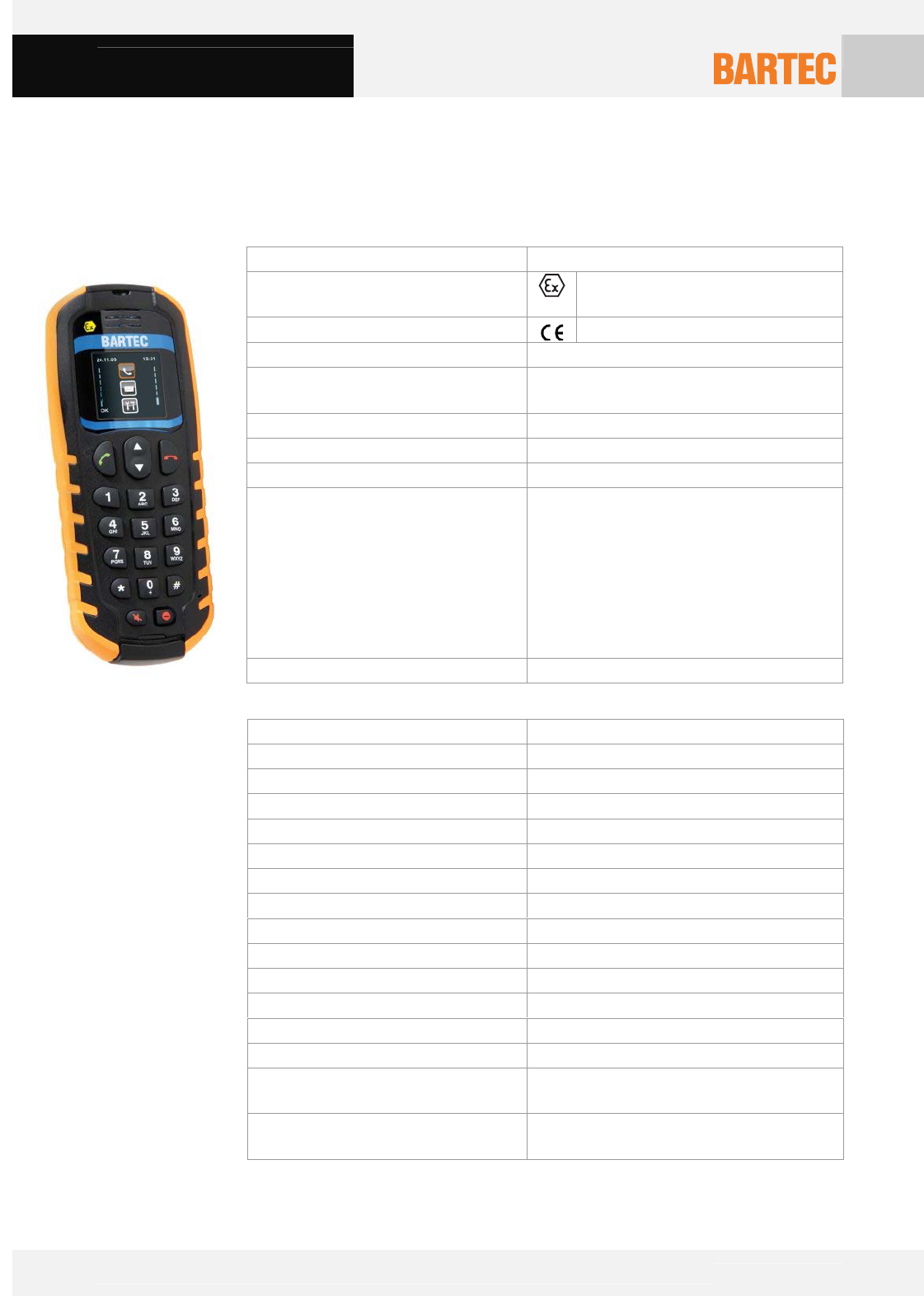
User Manual Pegasus 70xx series
Technical data subject to change without notice.
Issue 01/2010 Page 6 of 44
2.1.2 Ex protection marking
Type 17-C110-*Q*1/0000
Ex protection type (ATEX Zone 1 / 21) II 2G Ex ib IIB T4
II 2D Ex ibD21 T130°
Product marking
Certification Demko 10 ATEX 0911055X
Ex protection type (IECEx) Ex ib IIB T4 Gb
II 2D Ex ibD21 T130°
Certification IECEx UL 10.0003X
Ex protection type (UL) Class I, II, III Div 1, Groups C-D and F-G, T4
Certification E 321557
Standards UL 913, Seventh Edition (referencing UL 60079-
0, Fourth Edition and UL 60079-11, First Edition)
CAN/CSA C22.2 No. 157-92
UL 60950-1, First Edition
CSA C22.2 60950-1, First Edition
EN 60079-0:2009 EC 60079-0:2007
EN 60079-11:2007 IEC 60079-11:2006
DE 0825-1:2004 VDE 0825-11:2007
Directives 94/9/EC
2.2 Specification Pegasus 7010ex, type 17-C110-*Q*1/0000
2.2.2 Technical data
Display OLED color display
Networks Quad Band GSM 850/900/1800/1900 MHz
Dimensions (Height x Width x Depth) 155 mm x 59 mm x 27 mm
Weight approx. 240 g
IP rating IP 65
Ambient temperature -20 °C to +60 °C
Storage and transport temperature -20 °C to +60 °C
Charging temperature 0 °C to +50 °C
Air humidity 5 % up to 95 % (non-condensing)
GSM module Telit GE864
Power supply lithium polymer battery 3,7 V/2650 mAh
Interfaces mini USB
Audio system microphone and speaker integrated
Antennas integrated in the device (GPS and GSM)
Scope of supply includes battery, charger and USB
transmission cable
Accessories Desktop charger, Holster, Micro SD card 1
GB or 2 GB
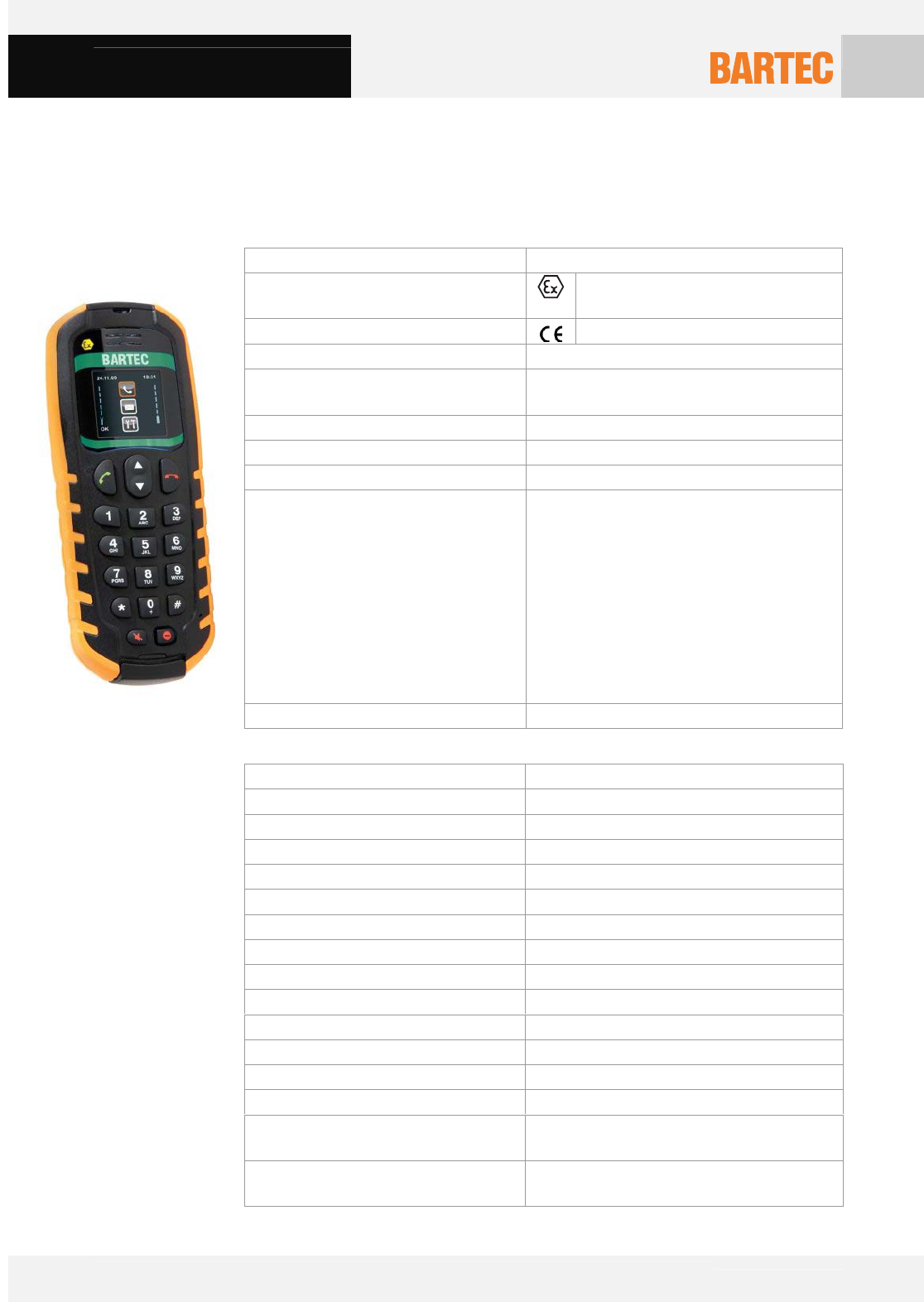
User Manual Pegasus 70xx series
Technical data subject to change without notice.
Issue 01/2010 Page 7 of 44
2.1.3 Ex protection marking
Type B7-C210-*Q*1/0000
Ex protection type (ATEX Zone 2 / 22) II 3G Ex ib IIC T4
II 3D Ex ibD22 T130°
Product marking
Certification Demko 10 ATEX 147282X
Ex protection type (IECEx) II 3G Ex ic IIC T4 Gc
II 3D Ex icD22 T130°
Certification IECEx UL 10.0004X
Ex protection type (UL) Class I, II, III Div 2, Groups C-D and F-G, T4
Certification E 321557
Standards UL 913, Seventh Edition (referencing UL
60079-0, Fourth Edition and UL 60079-11,
First Edition)
CAN/CSA C22.2 No. 157-92
UL 60950-1, First Edition
CSA C22.2 60950-1, First Edition
EN 60079-0:2009 IEC 60079-0:2007
EN 60079-11:2007 IEC 60079-11:2006
DE 0825-1:2004
VDE 0825-11:2007
Directives 94/9/EC
2.3 Specification Pegasus 7020ex, type B7-C210-*Q*1/0000
2.2.3 Technical data
Display OLED color display
Networks Quad Band GSM 850/900/1800/1900 MHz
Dimensions (Height x Width x Depth) 155 mm x 59 mm x 27 mm
Weight approx. 240 g
IP rating IP 65
Ambient temperature -20 °C to +60 °C
Storage and transport temperature -20 °C to +60 °C
Charging temperature 0 °C to +50 °C
Air humidity 5 % up to 95 % (non-condensing)
GSM module Telit GE864
Power supply lithium polymer battery 3,7 V/2650 mAh
Interfaces mini USB
Audio system microphone and speaker integrated
Antennas integrated in the device (GPS and GSM)
Scope of supply includes battery, charger and USB
transmission cable
Accessories Desktop charger, Holster, Micro SD card 1
GB or 2 GB
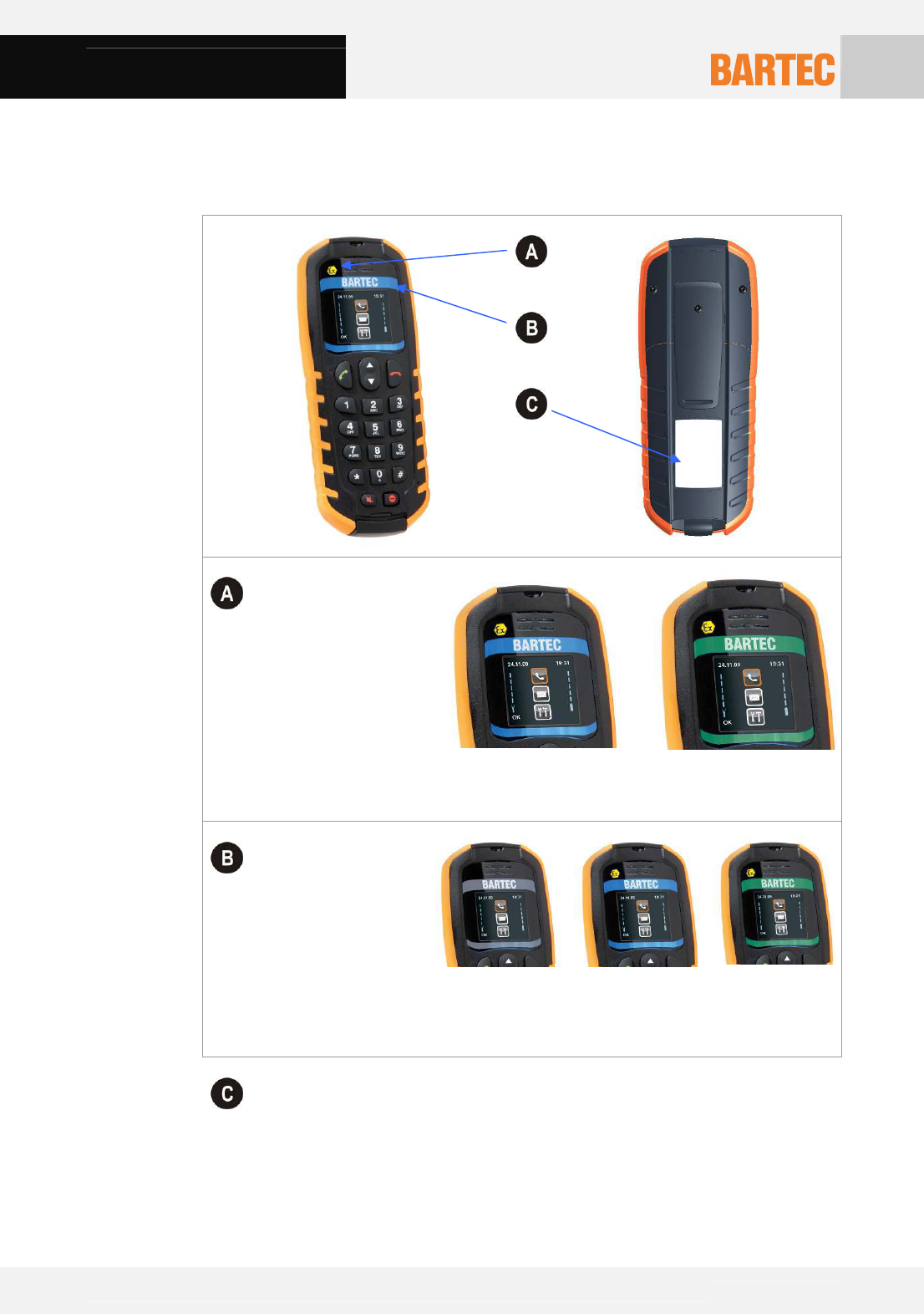
User Manual Pegasus 70xx series
Technical data subject to change without notice.
Issue 01/2010 Page 8 of 44
Ex Logo
Only printed on the
displayed Ex versions
of the Pegasus 70xx
series.
Pegasus 7010ex Pegasus 7020ex
Differentiation of
colors
Pegasus 7000
with grey display
border
Pegasus 7010ex
with blue display
border
Pegasus 7020ex
with green
display border
Type label
2.4 Product Marking
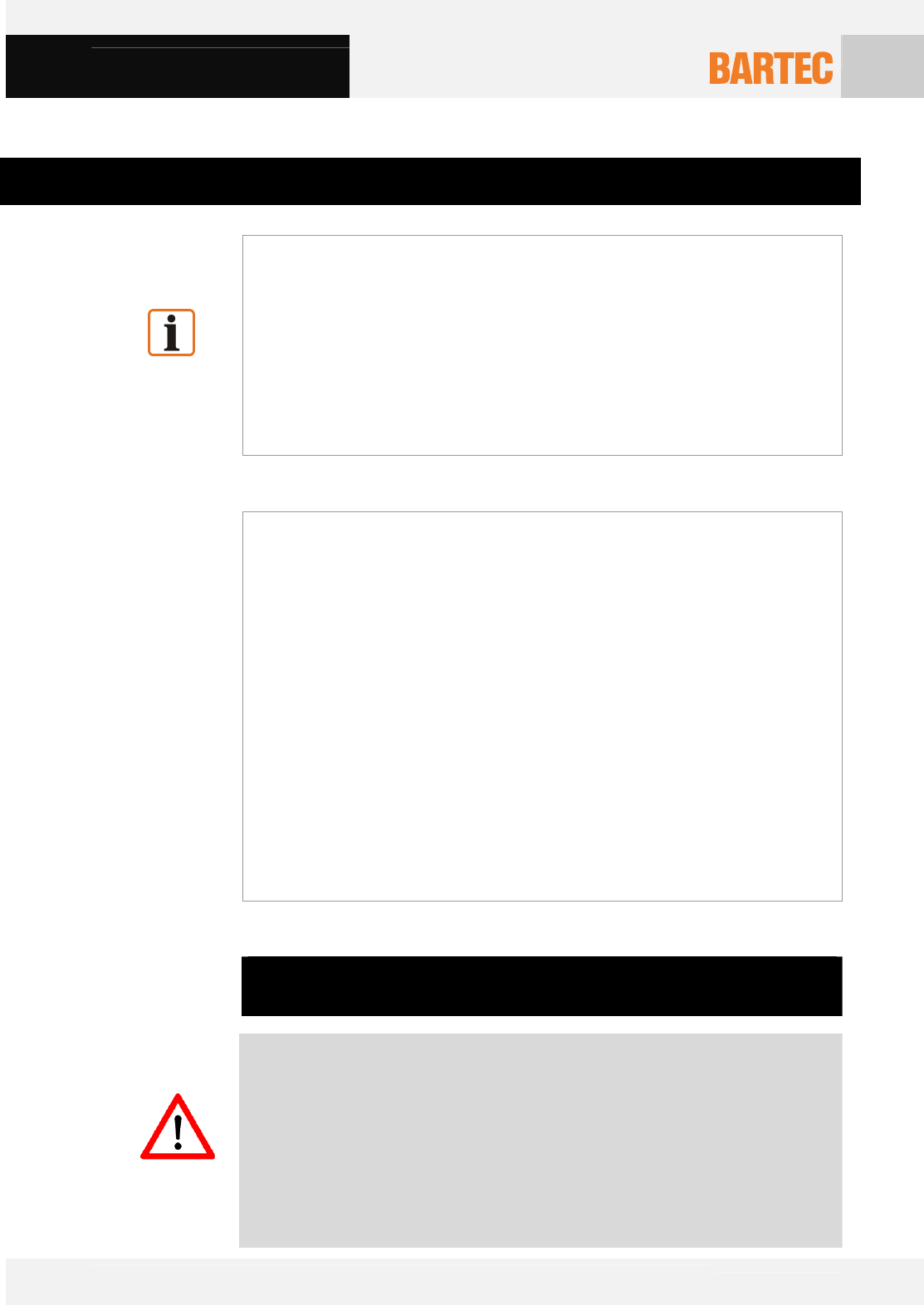
User Manual Pegasus 70xx series
Technical data subject to change without notice.
Issue 01/2010 Page 9 of 44
3 Safety and Security
Note
For an efficient and safe operation of your Pegasus 70xx series, it is important
that you read this information before use!
Your Pegasus 70xx series is one of the most exciting and innovative electronic products
ever developed. With it, you can stay in contact with your office, your home, emergency
services and others, wherever service is provided.
This chapter contains important information on the safe and reliable use of the Pegasus
70xx series device. Please read this chapter carefully before starting to use the Pegasus
70xx cellular engine series.
Your Pegasus 70xx series device utilizes the GSM standard for cellular technology.
GSM is a newer radio frequency („RF“) technology than the current FM technology that
has been used for radio communications for decades. The GSM standard has been
established for use in the European community and elsewhere. Your Pegasus 70xx
series is actually a low power radio transmitter and receiver. It sends out and receives
radio frequency energy. When you use your modem, the cellular system handling your
calls controls both the radio frequency and the power level of your cellular modem.
SIM cards, not included in the scope of delivery of the device, are needed for using the
acquired devices. The SIM cards can be obtained e.g. from specific providers. The use
of the SIM cards can result in additional costs, which must be borne by the purchaser
(customer) of the devices. The seller does not cover the extra costs involved in using the
devices. The seller gives no recommendation on the use of specific SIM cards and does
not give any assurance either that the devices will be usable with all available SIM cards.
The seller will not cover any other costs incurred when this device is used in a
customer’s application.
The device is factory-sealed. Do not open it!
The device may be opened in the factory only!
Danger!
Protect the device from impact effects! Do not expose the equipment to corrosive/
aggressive liquids, vapors or mist! Take the equipment out of the hazardous area
immediately if it malfunctions or if the enclosure is damaged and bring it into the safe
area to put it out of operation!
Put the device out of operation immediately also if you suspect that the operating
equipment can no longer be operated safely after harmful effects or general
irregularities (e.g. penetration of water, fluids, effect of temperatures outside the
specified range etc.).
3.1 General Information
3.2 Notes of Handling
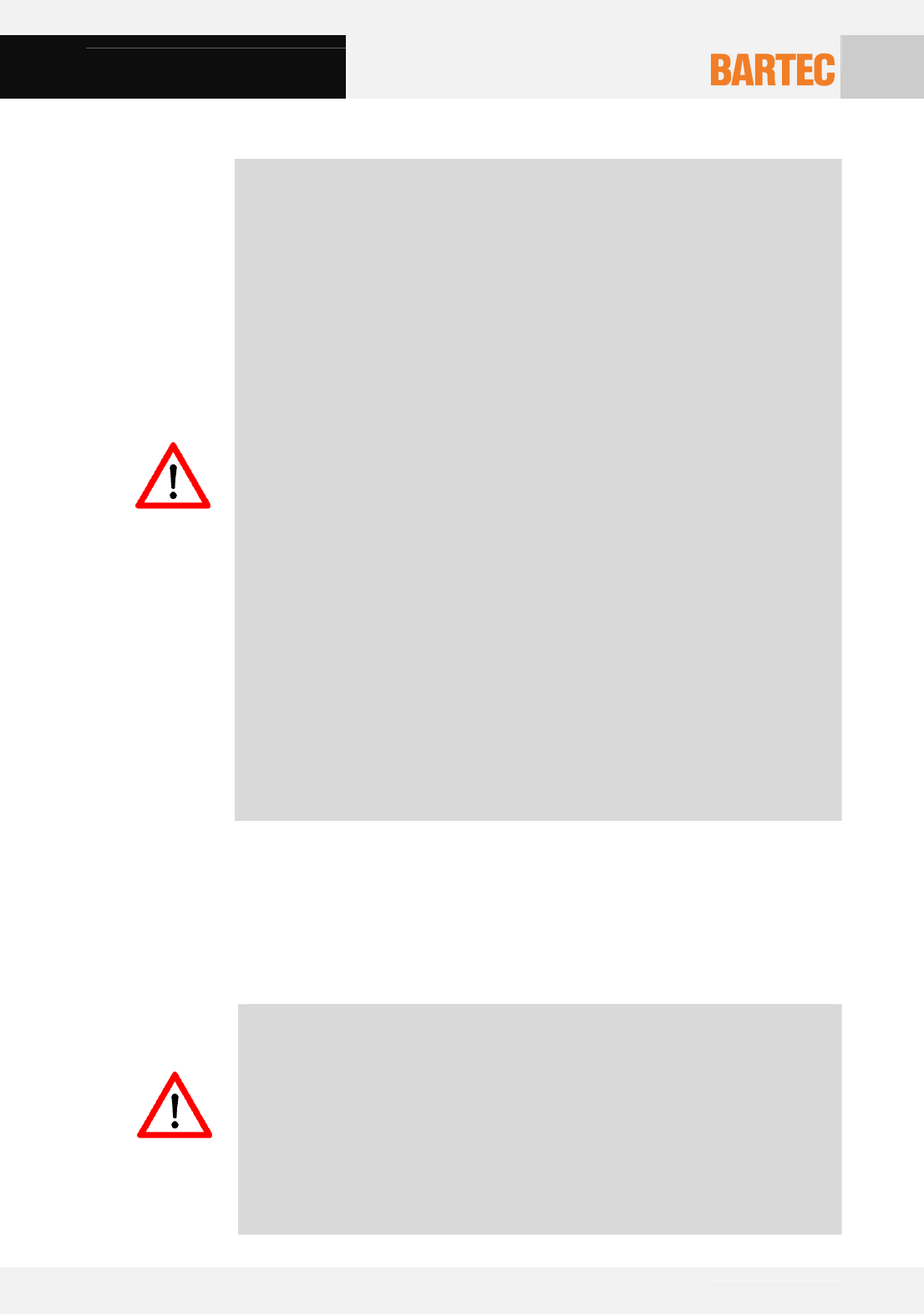
User Manual Pegasus 70xx series
Technical data subject to change without notice.
Issue 01/2010 Page 10 of 44
Caution!
Do not open or charge the devices and do not exchange any data through the listed
equipment in the hazardous area!
The device my not be opened by the user outside the hazardous area either!
The user may not make any alterations to the device. Do not exchange or replace
components and do not retrofit any components on internal plug connectors or slots. If
components other than those specified are used, the protection against explosions can
no longer be assured.
Exception:
SIM card, Micro SD card and battery door (see chapter 4 "Commissioning")
Remove the display protection of the Pegasus before use in hazardous location.
Take the device out of the hazardous areas before wiping it with a dry cloth or cleaning
it!
Avoid the effects of moisture.
Avoid the influence of heat that is higher or lower than the specified temperature range
(see chapter 2 "Technical Data"). Do not place the devices anywhere near sources of
heat, such as for example heaters, air exit openings in air-conditioners, or near cookers
or other devices (including amplifiers) that radiate heat.
The rules for hazardous areas (see directive 99/92/EC) must be observed. In particular,
appropriate clothing and footwear should be worn in view of the risk of dangerous
electrostatic charges. Do not wear rubber gloves or suchlike during operation!
General statutory regulations or directives on safety at work, accident prevention
regulations and environmental protection legislation must be complied with, e.g.
Ordinance on industrial health and safety (BetrSichV) or the national ordinances.
The safety rules below are applied for the internal battery. Mistreating the battery may
cause the battery to get hot, crack, or inflame and cause serious injury. In order to
avoid any damage and extend the life expectancy of the battery, please follow the
safety rules listed below before using the Pegasus 70xx series device:
Danger!
The battery may only be charged with listed chargers outside the hazardous area!
Charge and change battery only in an area known to be non-hazardous. Use only
BARTEC Models what are listed in chapter “3.4 Health and Safety recommendations”
for charging and communication or equivalent.
It must be ensured that only original batteries of the type 17-C1Z0-0001 with
3.7 V/2650 mAh are used in safety-oriented operation. The use of imitation batteries or
batteries from other manufacturers will render the type of ignition protection ineffective
and there will then be a risk of fire or explosion.
3.3 Battery Safety
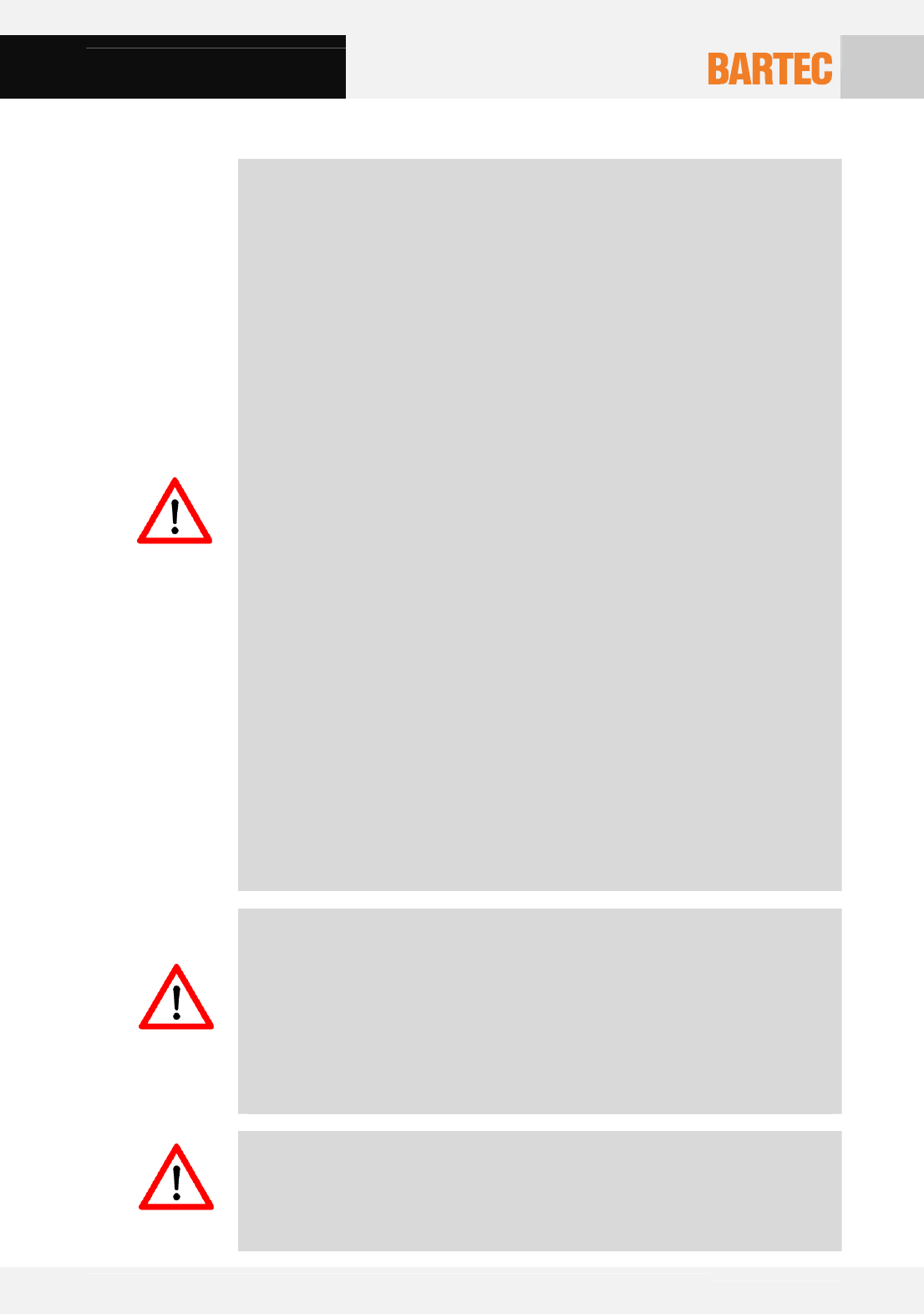
User Manual Pegasus 70xx series
Technical data subject to change without notice.
Issue 01/2010 Page 11 of 44
Caution!
The battery should only be used for the purposes stated in the user manual and is only
suitable for use with Pegasus 70xx series.
The battery should not be exposed to any temperatures higher than +60 °C.
Do not place the battery on, in or near fires, apparatus that provide heat, or other high-
temperature locations.
Do not place the battery in direct sunshine or use or store the battery inside cars in hot
weather. Doing so may cause the battery to generate heat, crack, or inflame. Using the
battery in this manner may also result in a loss of performance.
Do not attach the battery to a power supply plug or directly to a car’s cigarette lighter.
Do not pierce the battery with nails, strike the battery with a hammer, step on the
battery, or otherwise subject it to strong impacts or shocks.
Do not solder onto the battery contacts.
Do not allow the battery to get wet.
Do not disassemble or modify the battery.
Immediately discontinue use of the battery if, while using, charging, or storing the
battery, the battery emits an unusual smell, feels hot, or appears abnormal in any other
way.
Do not place the batteries in microwave ovens, high-pressure containers, or on
induction cookware.
In case the battery drips and the fluid gets into one’s eye, do not rub the eye. Rinse well
with water and immediately look for medical care. If left untreated the battery fluid could
cause damage to the eye.
Defective batteries must be disposed of immediately, whereby the battery disposal
regulations that apply to the respective region must be observed.
Caution!
Safety precautions while charging the battery.
Be sure to follow the rules listed below while charging the battery. Failure to do so may
cause the battery to become hot, rupture, or ignite and cause serious injury.
When charging the battery, make sure to observe the specified battery charging
conditions. The temperature range within which the battery can be charged is 0°C to
+50°C. Charging will be interrupted if the ambient temperature drops below or exceeds
this range.
Caution!
Safety precautions while discharging the battery.
The temperature range for discharging the batteries is -20°C to 60°C. Use of the
battery outside this temperature range may damage the performance of the battery or
reduce its life expectancy.
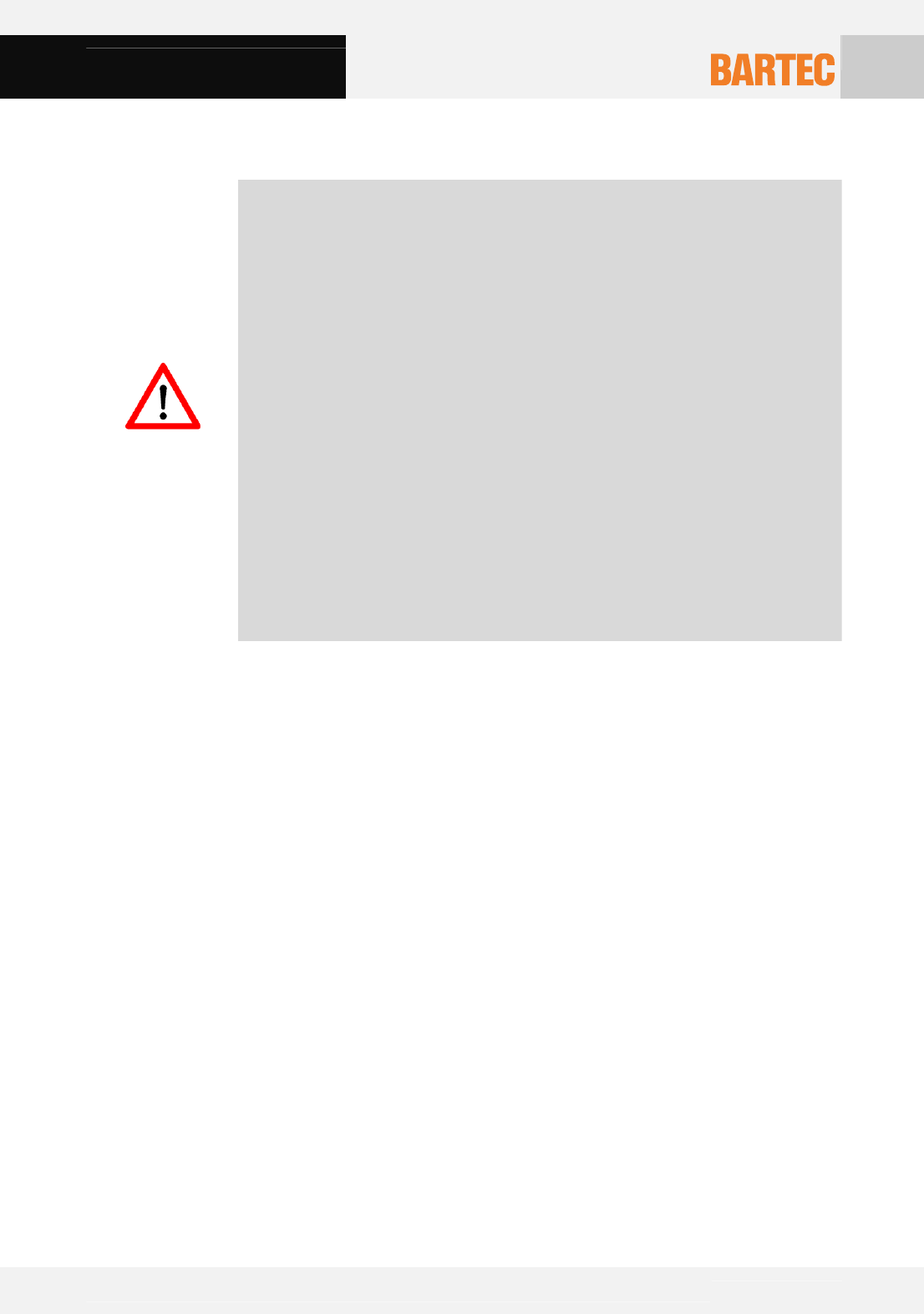
User Manual Pegasus 70xx series
Technical data subject to change without notice.
Issue 01/2010 Page 12 of 44
Danger!
Use only approved accessories.
All components must be dry before they may be connected to an external power
supply.
It is only permitted to use by BARTEC approved accessories for charging or/and data
communication.
17-C1Z0-0001 Battery 3,7 V / 2650 mAh
17-C1Z0-0002 Charging cable
17-C1Z0-0003 USB data communication cable
17-C1Z0-0004 leather holster
17-C1Z0-0005 Desktop charger
17-C1Z0-0006 Car charging cable
17-C1Z0-0007 Micro SD card with 1 GB
17-C1Z0-0008 Micro SD card with 2 GB
These accessories are modified in accordance to the necessary standards.
The use of imitation accessories or accessories from other manufacturers will render
the type of ignition protection ineffective and there will be a risk of fire or explosion.
There has been some public concern about possible health effects of using a GSM
modem. Although research on health effects from RF energy has focused for many
years on the current RF technology, scientists have begun research on newer radio
technologies, such as GSM. After reviewing existing research and testing compliance
with all applicable safety standards, it has been concluded that the product is fit for use.
If you are concerned about exposure to RF energy, there are things you can do to
minimize exposure. Obviously, limiting the duration of your calls will reduce your
exposure to RF energy. In addition, you can reduce RF exposure by operating your
cellular modem efficiently by following the guidelines below.
Check the laws and regulations on the use of cellular devices in the area where you
drive. Always obey them. Also, when using your Pegasus 70xx series while driving,
please pay full attention to driving, pull off the road and park before making or answering
a call if driving conditions so require. When applications are prepared for mobile use,
they should comply with road-safety rules under applicable laws!
3.4 Health and Safety recommendations
3.5 Exposure to RF energy
3.6 Driving

User Manual Pegasus 70xx series
Technical data subject to change without notice.
Issue 01/2010 Page 13 of 44
Most electronic equipment, for example in hospitals and motor vehicles is shielded from
RF energy. However, RF energy may affect some malfunctioning or improperly shielded
electronic equipment.
Check with your vehicle manufacturer’s representative to determine if any on board
electronic equipment is adequately shielded from RF energy.
Consult the manufacturer of any personal medical devices (such as pacemakers,
hearing aids, etc.) to determine if they are adequately shielded from external RF energy.
Turn your Pegasus 70xx series device OFF in health care facilities when any regulations
posted in the area instruct you to do so. Hospitals or health care facilities may be using
RF monitoring equipment
Turn your Pegasus 70xx series OFF before boarding any aircraft. Use it on the ground
only with crew permission. Do not use it in the air. To prevent possible interference with
aircraft systems, Federal Aviation Administration (FAA) regulations require you to have
permission from a crewmember to use your modem while the plane is on the ground. To
prevent interference with cellular systems, local RF regulations prohibit the use of your
modem whilst airborne.
Do not allow children to play with your Pegasus 70xx series device. It is not a toy.
Children could hurt themselves or others (by poking themselves or others in the eye with
the antenna, for example). Children could damage the modem or make calls that
increase your modem bills.
To avoid interfering with blasting operations, turn your device OFF when in a “blasting
area” or in areas posted: „turn off two-way radio“. Construction crew often uses remote
control RF devices to set off explosives.
3.7 Electronic devices
3.8 Vehicle electronic equipment
3.9 Medical electronic equipment
3.10 Aircraft
3.11 Children
3.12 Blasting areas

User Manual Pegasus 70xx series
Technical data subject to change without notice.
Issue 01/2010 Page 14 of 44
Turn your Pegasus 70xx series device OFF when in any area with a potentially explosive
atmosphere. It is rare, but your modems or their accessories could generate sparks. Sparks
in such areas could cause an explosion or fire resulting in bodily injury or even death.
Areas with a potentially explosive atmosphere are often, but not always, clearly marked.
They include fuelling areas such as petrol stations; below decks on boats; fuel or
chemical transfer or storage facilities; and areas where the air contains chemicals or
particles, such as grain, dust or metal powders.
Do not transport or store flammable gas, liquid or explosives, in the compartment of your
vehicle which contains your modem or accessories.
Before using your modem in a vehicle powered by liquefied petroleum gas (such as
propane or butane) ensure that the vehicle complies with the relevant fire and safety
regulations of the country in which the vehicle is to be used.
¨ Pegasus 7000 is intended for use in industrial environment
¨ Pegasus 7010ex is intended for use in hazardous locations (Zone 1/21 or
IECEx Zone 1/21 or Class I, II, III Division 1 or Zone 2/22 or IECEx Zone
2/22 or Class I, II, III Division 2)
¨ Pegasus 7020ex is intended for use in hazardous locations (Zone 2/22 or
IECEx Zone 2/22 or Class I, II, III Division 2)
Your GSM/GPRS/GPS device complies with all applicable RF safety standards.
Pegasus 70xx series meets the safety standards for RF receivers and the standards and
recommendations for the protection of public exposure to RF electromagnetic energy
established by government bodies and professional organizations, such as directives of
the European Community, Directorate General V in matters of radio frequency
electromagnetic energy.
This device contains 850/900/1800/1900 MHz GSM/GPRS functions that are operational
in these frequencies respectively. The Pegasus 70xx series device contains 1800 MHz
GSM functions that are not operational (must not be used) in U.S. Territories. Filing is
only applicable for 850MHz GSM/1900 MHz PCS operations, whereby only these
frequencies (850MHz GSM/1900 MHz PCS) may be used in U.S. Territories.
3.13 Potentially explosive atmospheres
3.14 Safety Standards
3.15 RF Exposures

User Manual Pegasus 70xx series
Technical data subject to change without notice.
Issue 01/2010 Page 15 of 44
Statement according to FCC part 15.19:
This device complies with Part 15 of the FCC Rules. Operation is subject to the following
two conditions:
■ this device may not cause harmful interference, and
■ this device must accept any interference received, including interference that may
cause undesired operation.
Statement according to FCC part 15.21:
Modifications not expressly approved by this company could void the user's authority to
operate the equipment.
Statement according to FCC part 15.105:
NOTE: This equipment has been tested and found to comply with the limits for a Class B
digital device, pursuant to Part 15 of the FCC Rules. These limits are designed to
provide reasonable protection against harmful interference in a residential installation.
This equipment generates uses and can radiate radio frequency energy and, if not
installed and used in accordance with the instructions, may cause harmful interference
to radio communications. However, there is no guarantee that interference will not occur
in a particular installation. If this equipment does cause harmful interference to radio or
television reception, which can be determined by turning the equipment off and on, the
user is encouraged to try to correct the interference by one or more of the following
measures:
Reorient or relocate the receiving antenna.
Increase the distance between the equipment and receiver.
Plug the equipment into an outlet on a circuit different from that to which
the receiver is connected.
Consult the dealer or an experienced radio/TV technician for help.
The statement “Underwriters Laboratories Inc. (UL) has not tested the performance or
reliability of the Global Positioning System (GPS) hardware, GPS operating software or
other GPS-related aspects of this product. UL has only tested for the explosion, fire,
shock and casualty hazards required by the applicable hazardous locations standards.
UL certification does not cover the performance or reliability of the GPS hardware, GPS
operating software or other GPS-related aspects of this product. UL MAKES NO
REPRESENTATIONS, WARRANTIES OR CERTIFICATIONS WHATSOEVER
REGARDING THE PERFORMANCE OR RELIABILITY OF ANY GPS RELATED
FUNCTIONS OF THIS PRODUCT.”
3.16 Statement of the UL
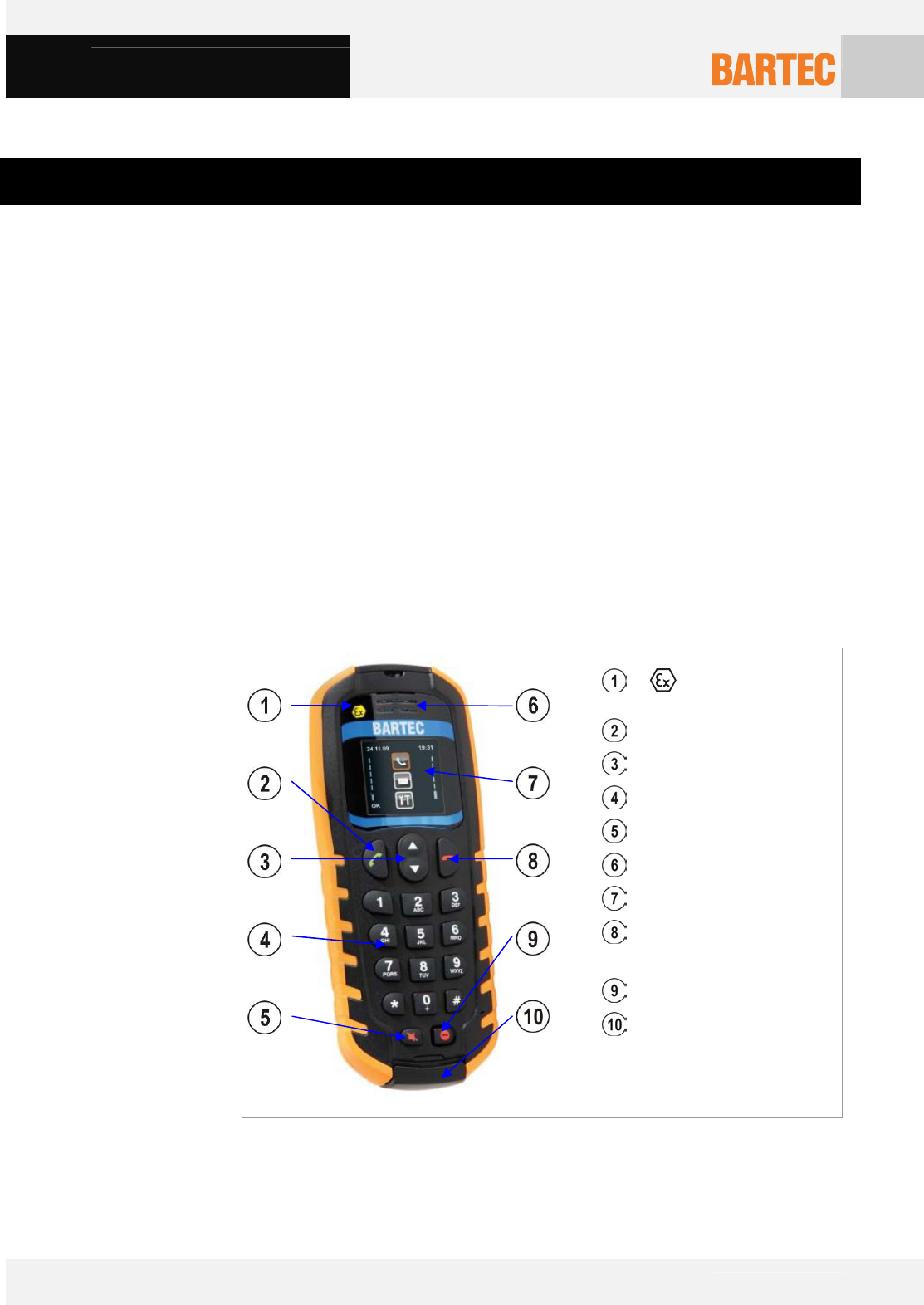
User Manual Pegasus 70xx series
Technical data subject to change without notice.
Issue 01/2010 Page 16 of 44
4 Commissioning
Before commissioning the devices, check that all components and documents are there.
■ Pegasus 70xx Mobile Phone
■ Battery
■ Charger cable
■ USB-Data cable
■ CD-ROM (User Manual, Phonebook software, Tracking software)
■ Safety instructions
Logo only on Pegasus
7010 ex and 7020ex
Left soft key (to call or OK)
2-Way navigation key
Keypad
Emergency call
Speaker
Screen
Right soft key
(to hang up or Back)
Power On / Off
Cover
(Mini USB interface,
SIM card slot, Micro SD
card slot, Hard shutdown)
Figure 5: Pegasus 7010ex front side
4.1 Purchased parts in packages
4.2 Functional Parts of the device
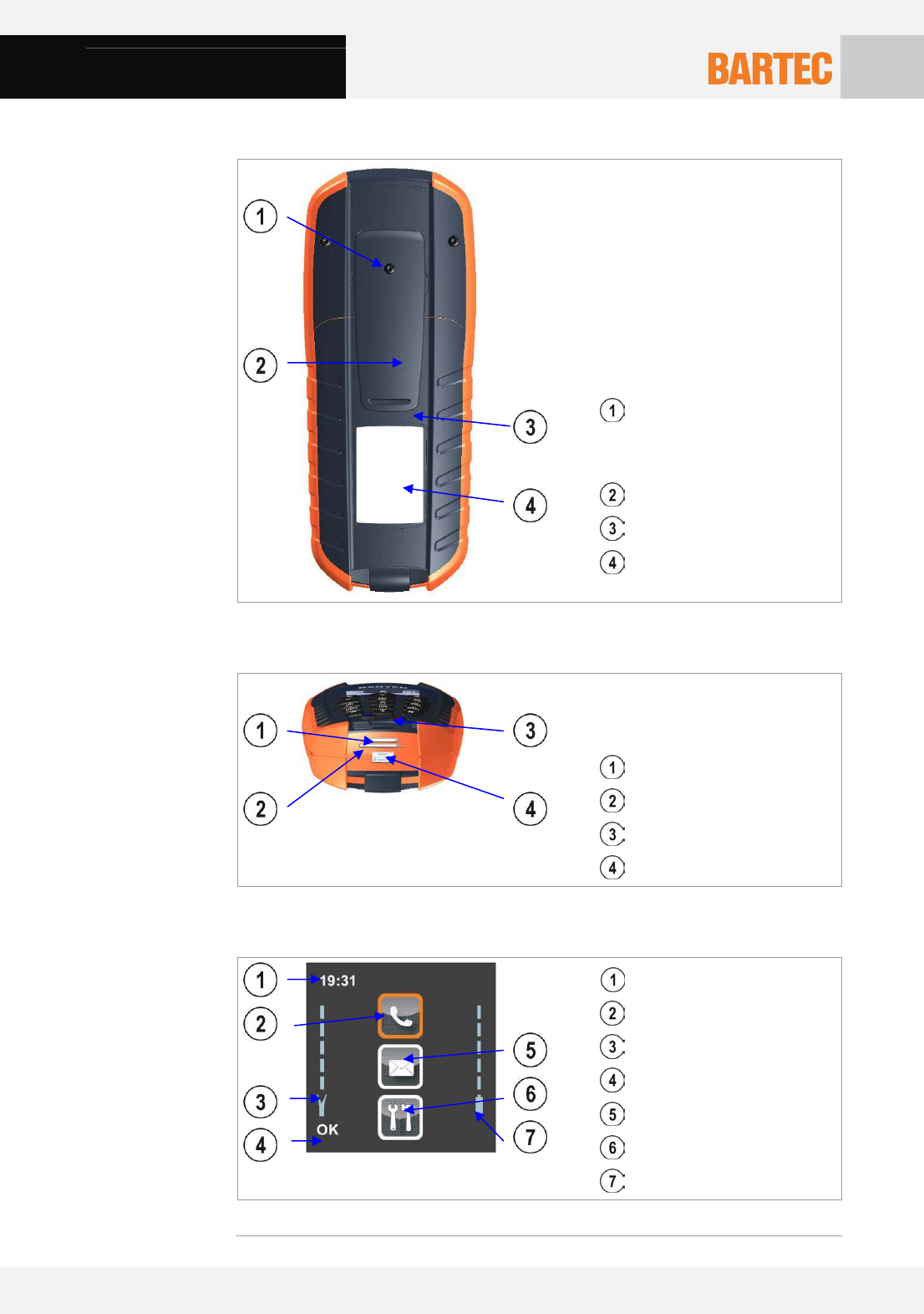
User Manual Pegasus 70xx series
Technical data subject to change without notice.
Issue 01/2010 Page 17 of 44
Screw for fastening the belt
clip
(type K20x8 WN5452-Torx-1)
Belt clip
Battery cover
Type label
Figure 6: Pegasus 7010ex rear side
Micro SD card slot
SIM card slot
Hard shutdown
Mini USB interface
Figure 7: Pegasus 70xx cover
Clock
Phone settings
Signal strength level (5 bars)
OK for the left soft key
SMS settings
General settings
Battery
Figure 8: Pegasus 70xx start screen
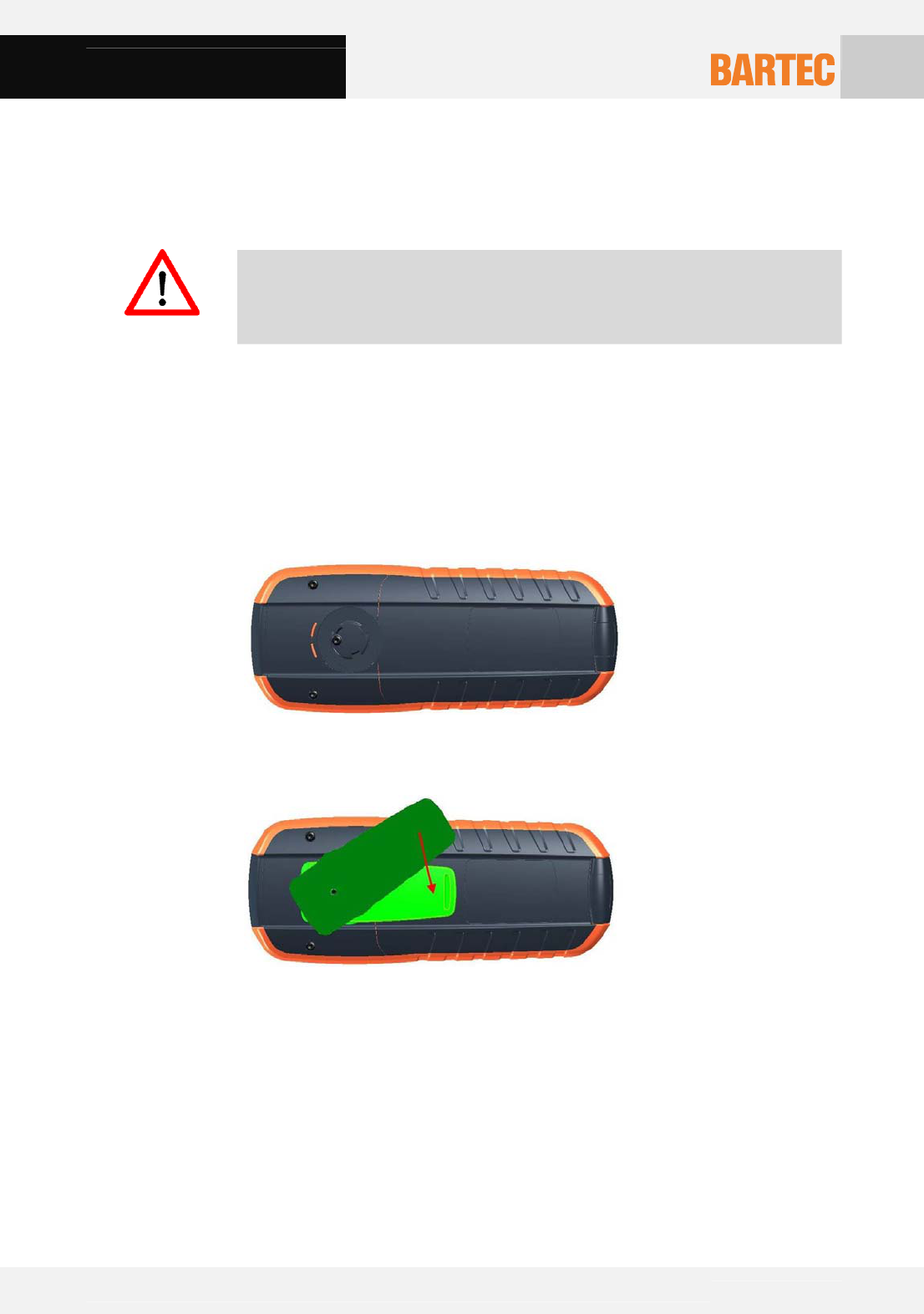
User Manual Pegasus 70xx series
Technical data subject to change without notice.
Issue 01/2010 Page 18 of 44
Danger!
The belt clip may only be fastened or changed outside the hazardous area!
¨ Put the belt clip into the slot of the back of the Pegasus 70xx
¨ Turn the belt clip in position as shown in figure 10
¨ Tighten the screw (type K20x8 WN5452-Torx-1) to fix the belt clip on the
Pegasus 70xx.
Figure 9: Pegasus 70xx without belt clip
Figure 10: Pegasus 70xx fastening belt clip
4.3 Fastening and Changing the belt clip
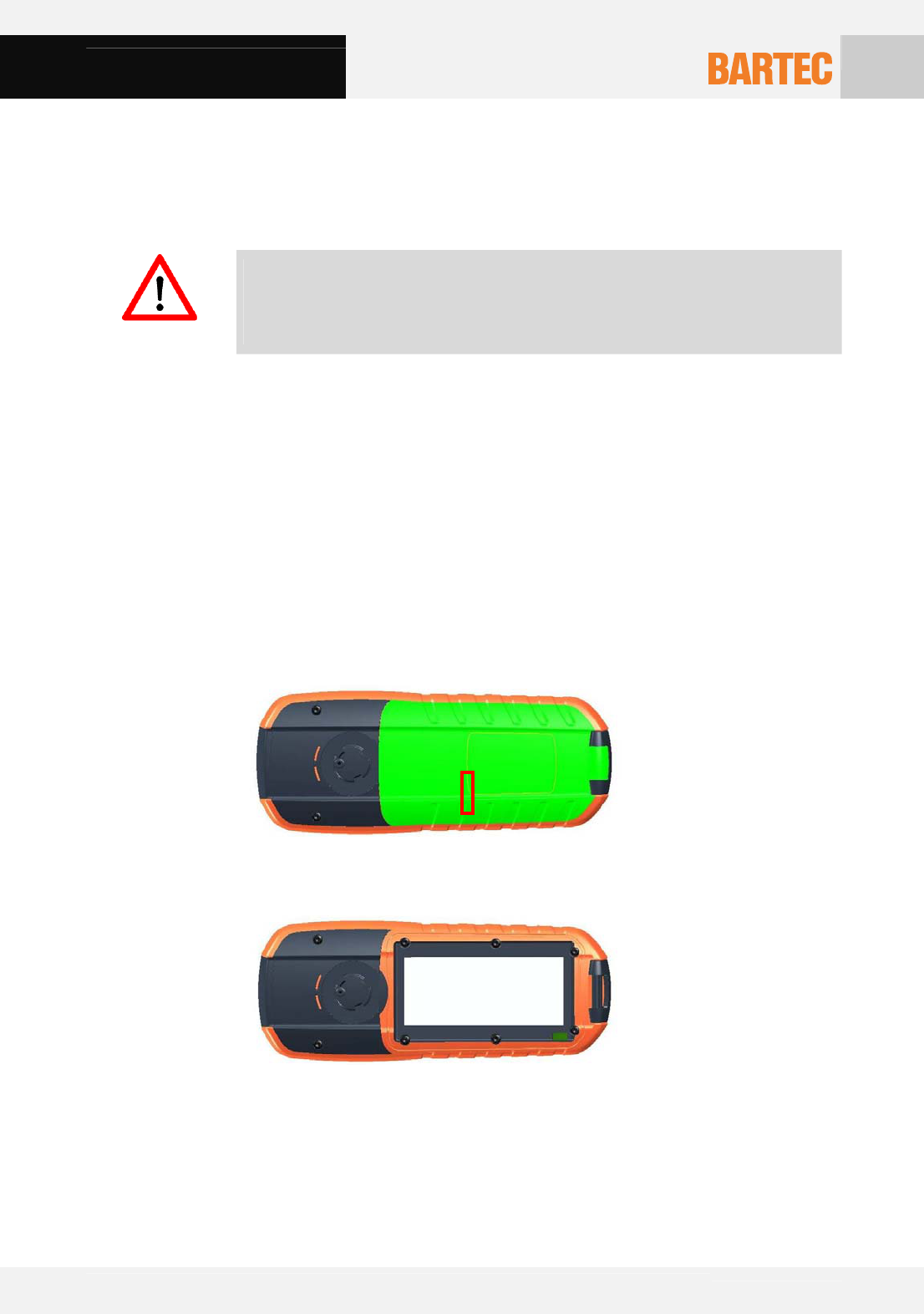
User Manual Pegasus 70xx series
Technical data subject to change without notice.
Issue 01/2010 Page 19 of 44
Danger!
Charge and change battery only in an area known to be non-hazardous. Use only
BARTEC Models what are listed in chapter “3.4 Health and Safety recommendations”
for charging and communication or equivalent.
¨ Turn your Pegasus Off before you change the battery
¨ Loosen the screw (type K20x8 WN5452-Torx-1) on the belt clip
¨ Remove the belt clip as described in chapter 4.3.
¨ Lift the battery cover off the position marked red in figure 11.
¨ Insert or remove the battery from the battery door.
¨ Close the battery door
¨ Fasten the belt clip as described in chapter 4.3.
Figure 11: Pegasus 70xx battery cover
Figure 12: Pegasus 70xx without battery cover
4.4 Inserting and changing the battery
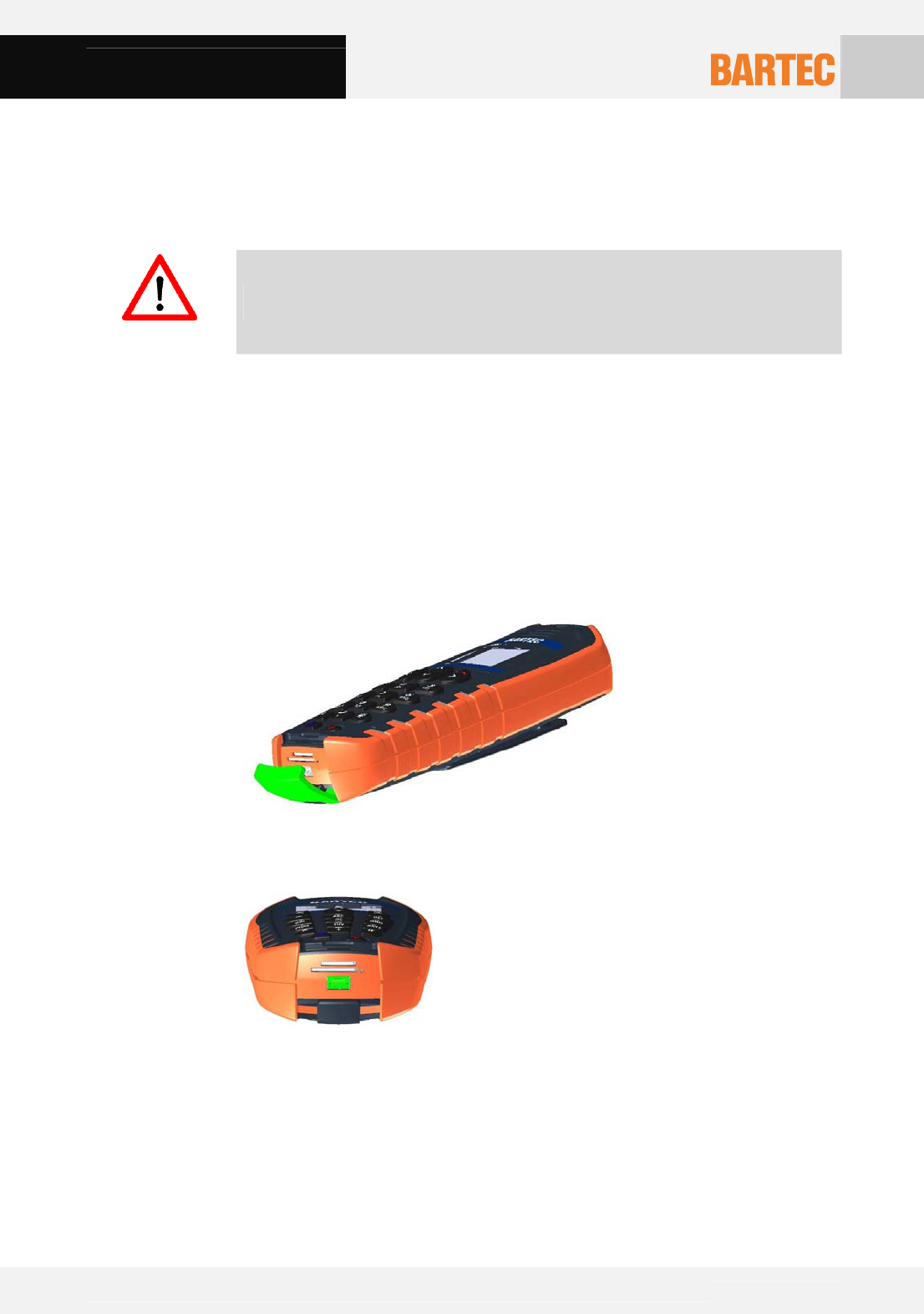
User Manual Pegasus 70xx series
Technical data subject to change without notice.
Issue 01/2010 Page 20 of 44
Danger!
The battery may only be charged with listed chargers outside the hazardous area!
¨ Open the cover to access the connections.
¨ Connect the charger cable to the mini USB slot as shown on figure 14.
¨ The charging status of the battery is shown on the right side of the
screen.
¨ After charging, remove the mini USB cable and close the cover.
Figure 13: Pegasus 70xx open cover
Figure 14: Pegasus 70xx open cover
4.5 Charging the battery
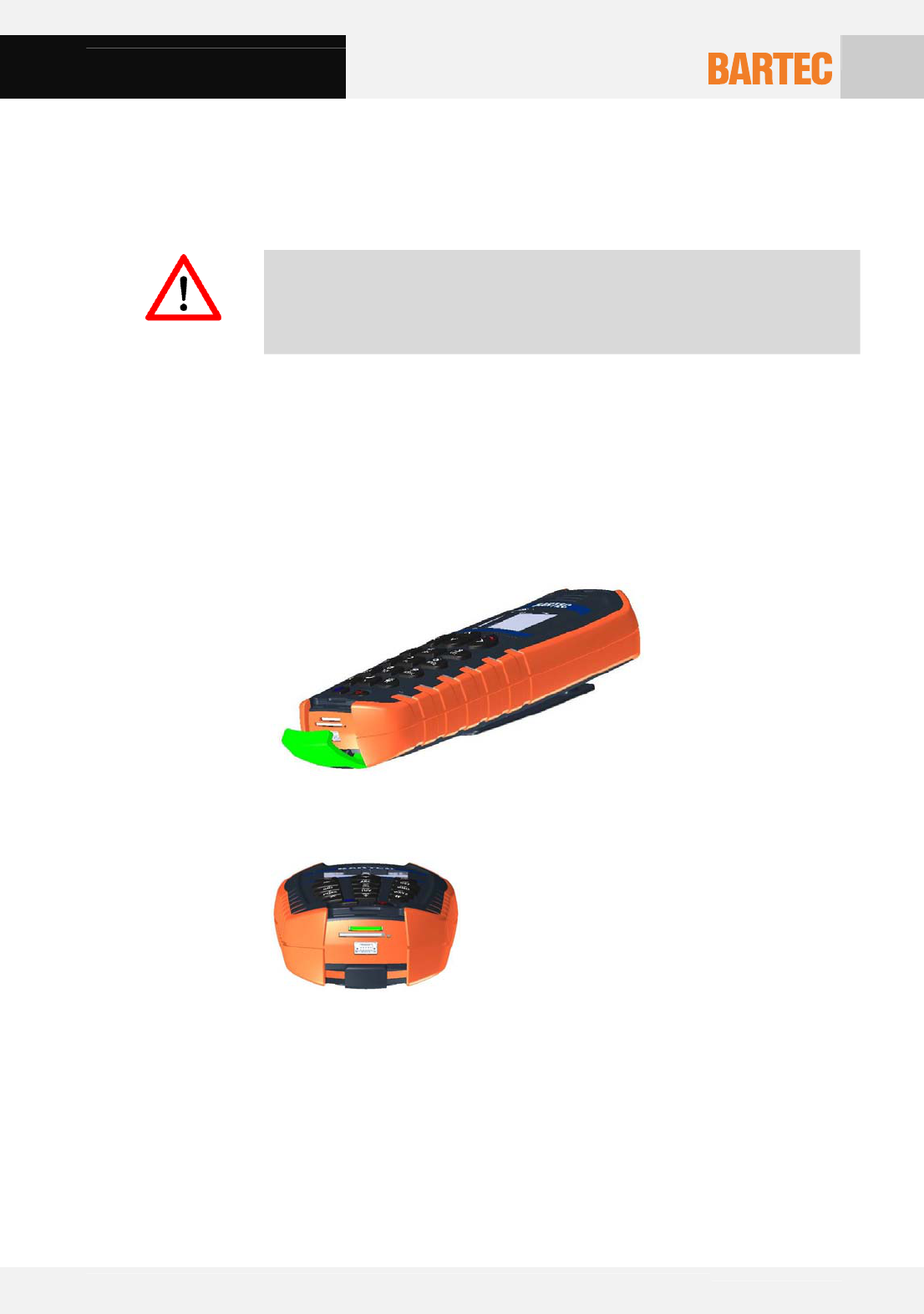
User Manual Pegasus 70xx series
Technical data subject to change without notice.
Issue 01/2010 Page 21 of 44
Danger!
The Micro SD-card may only be inserted or changed outside the hazardous area!
¨ Turn your Pegasus Off
¨ Open the cover to access the connections.
¨ Insert the micro SD-card into the slot as shown in figure 16.
¨ Close the cover.
Figure 15: Pegasus 70xx open cover
Figure 16: Pegasus 70xx micro SD card slot
4.6 Inserting the Micro SD-card
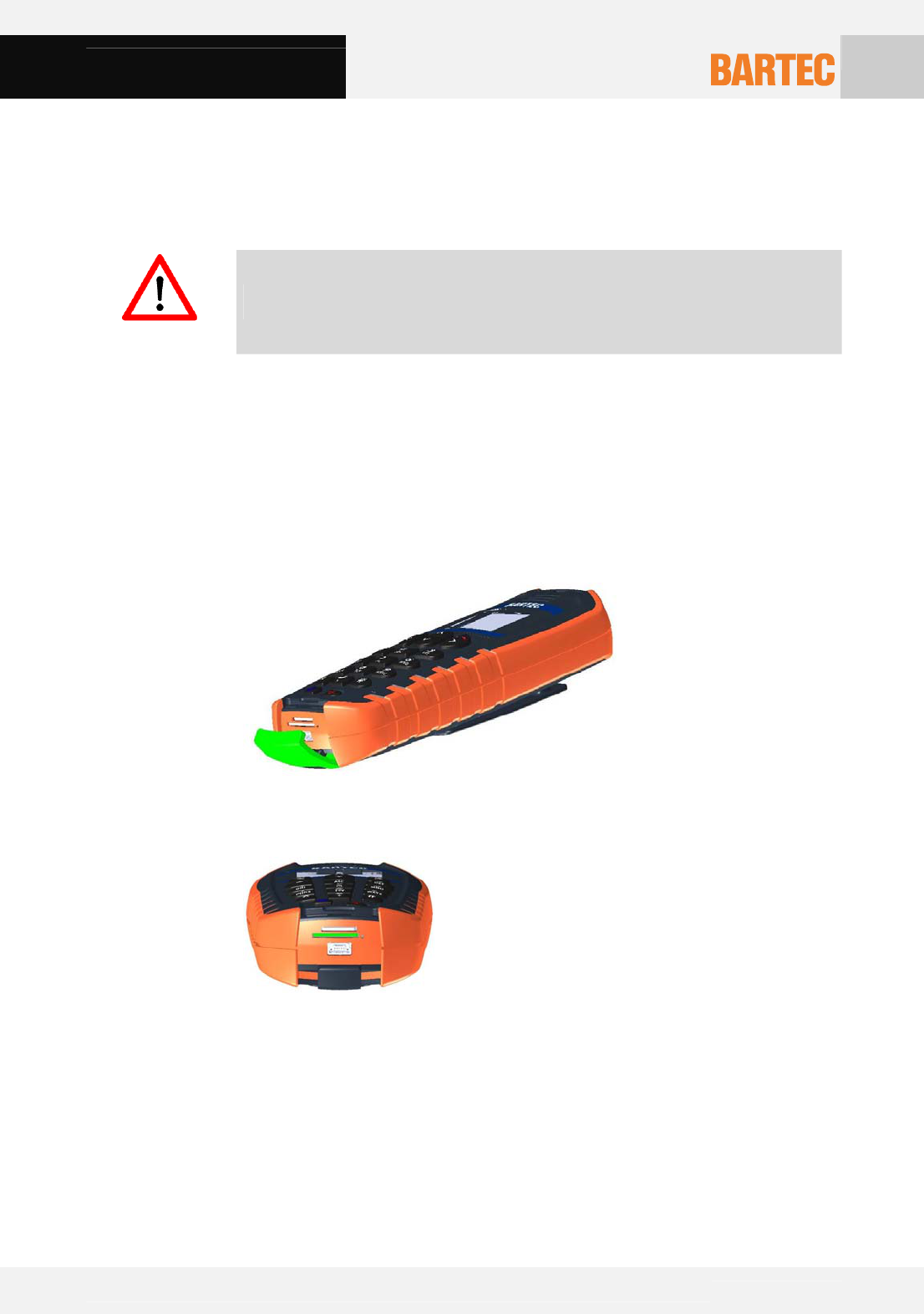
User Manual Pegasus 70xx series
Technical data subject to change without notice.
Issue 01/2010 Page 22 of 44
Danger!
The Micro SD-card may only be inserted or changed outside the hazardous area!
¨ Turn your Pegasus Off
¨ Open the cover to access the connections.
¨ Insert the SIM card into the slot as shown in figure 18.
¨ Close the cover.
Figure 17: Pegasus 70xx open cover
Figure 18: Pegasus 70xx SIM card slot
4.7 SIM card
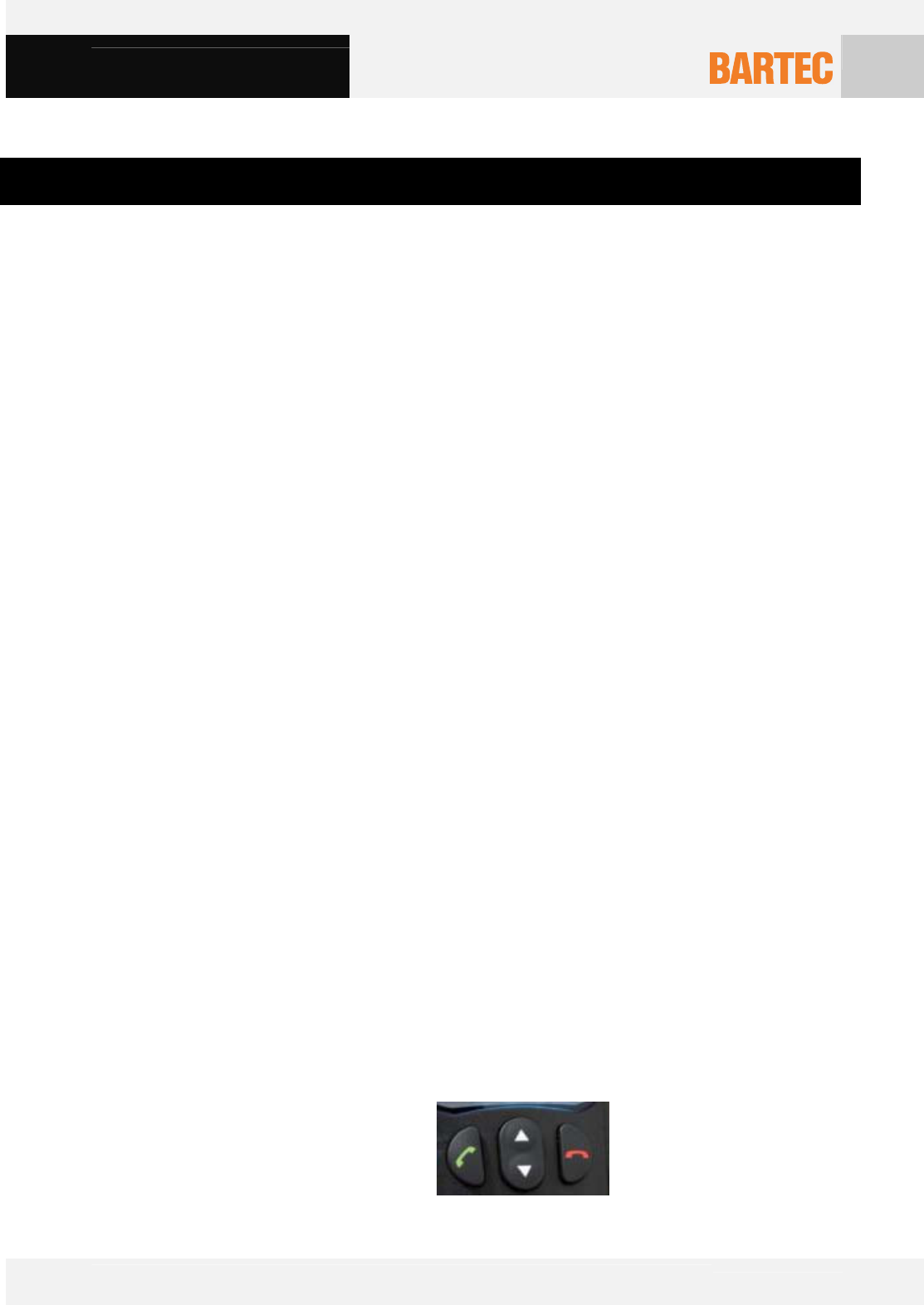
User Manual Pegasus 70xx series
Technical data subject to change without notice.
Issue 01/2010 Page 23 of 44
5 Operation
You are now ready to use your Pegasus 70xx for the first time.
Switch on the Pegasus by pressing the Power ON/OFF key. A start screen appears.
When you switch on your phone for the first time, you must configure it with various
settings that will remain by default until you choose to modify them.
After entering your PIN code, make your choice for the following settings: ring tone,
sound volume, hands-free, vibration, clock/date, man down function, tracking, etc.
If there are contacts saved in your SIM card, you can copy them into the phonebook
memory.
5.1.1 PIN number
This is a secret code for the SIM card. If access to the SIM card is protected, the device
prompts you to enter the PIN number. Enter the 4-digit PIN or customized code and
confirm it with OK.
For security reasons these digits will not appear on the screen.
If the SIM code is not accepted or the card is not recognised, turn the Pegasus Off and
check that the SIM card is inserted correctly in your Pegasus.
If an incorrect PIN number is entered three times in succession, your SIM card will be
blocked. In this case you must do the following:
■ Enter the PUK code provided by your operator.
■ Enter your PIN number and validate the entry.
■ Enter your PIN number again and validate the entry.
After 5 or 10 failed attempts, depending of the type of your SIM card, the SIM card will
be irrevocably locked. In this case you must contact your operator or provider to obtain a
new card.
5.2.1 Navigation Principle
Only 3 keys are needed to navigate through the different menus.
In the menus, a title bar reminds you of the previous level.
Left soft key Right soft key
(to call or OK) (to hang up or Back)
2-way navigation key
5.1 Getting started
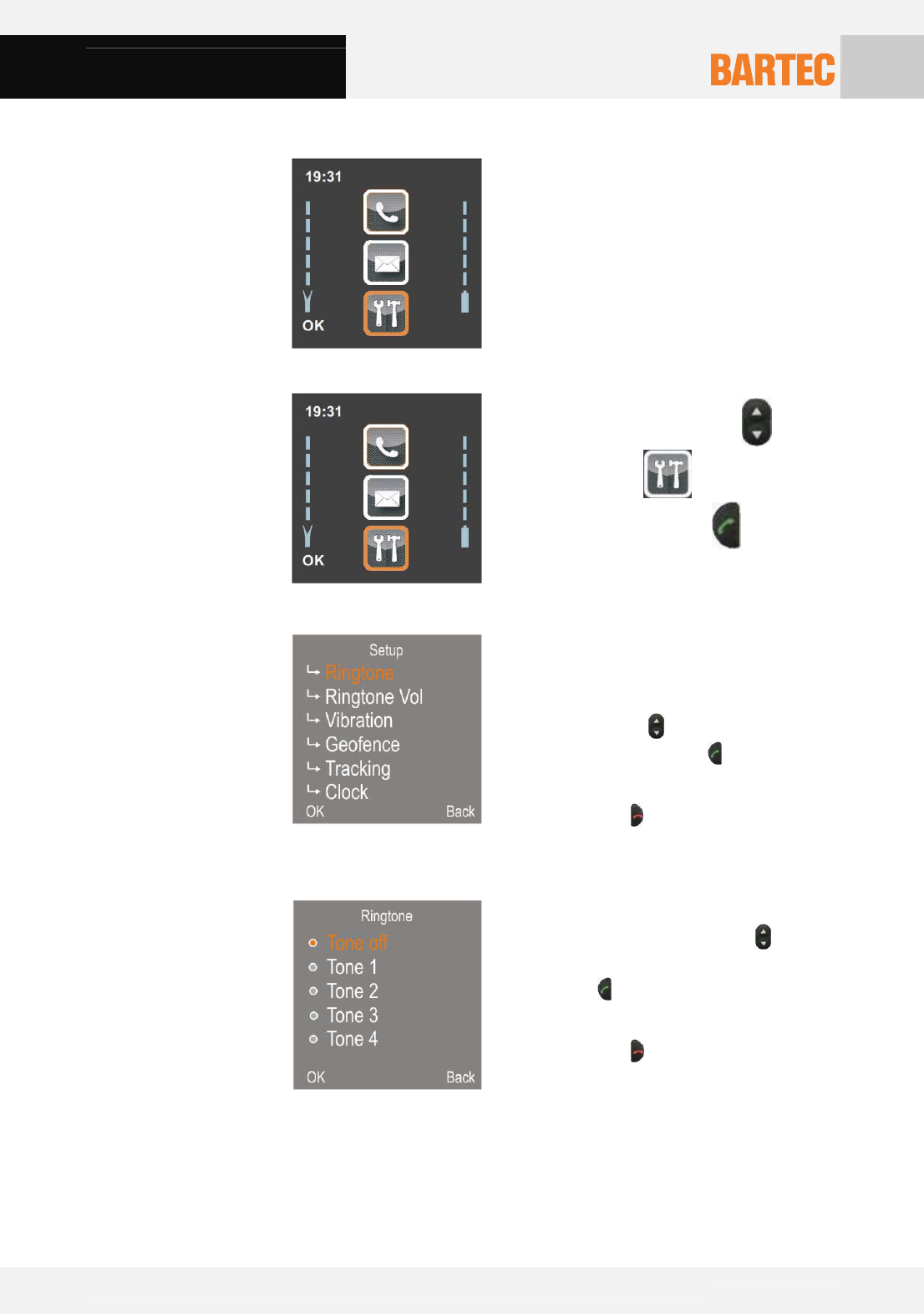
User Manual Pegasus 70xx series
Technical data subject to change without notice.
Issue 01/2010 Page 24 of 44
■ The 2-way navigation key is for the
selection of a menu entry.
■ The left soft key is used to go from a
menu to a sub-menu.
■ The right soft key is used to go from a
sub-menu to a higher-level menu.
5.3.1 General Settings
Use the 2-way navigation key
to select the settings menu and
press the left soft key to enter the
menu for customising your Pegasus 70xx.
Different menus are available for
customising your Pegasus 70xx.
You can select a menu with the 2-way
navigation key and enter the menu by
pressing the left soft key .
You can exit the sub-menu by pressing the
right soft key .
5.1.3.1 Ringtone
Use the 2-way navigation key to select
your ring tone and confirm it with the left
soft key .
You can exit the sub-menu by pressing the
right soft key .
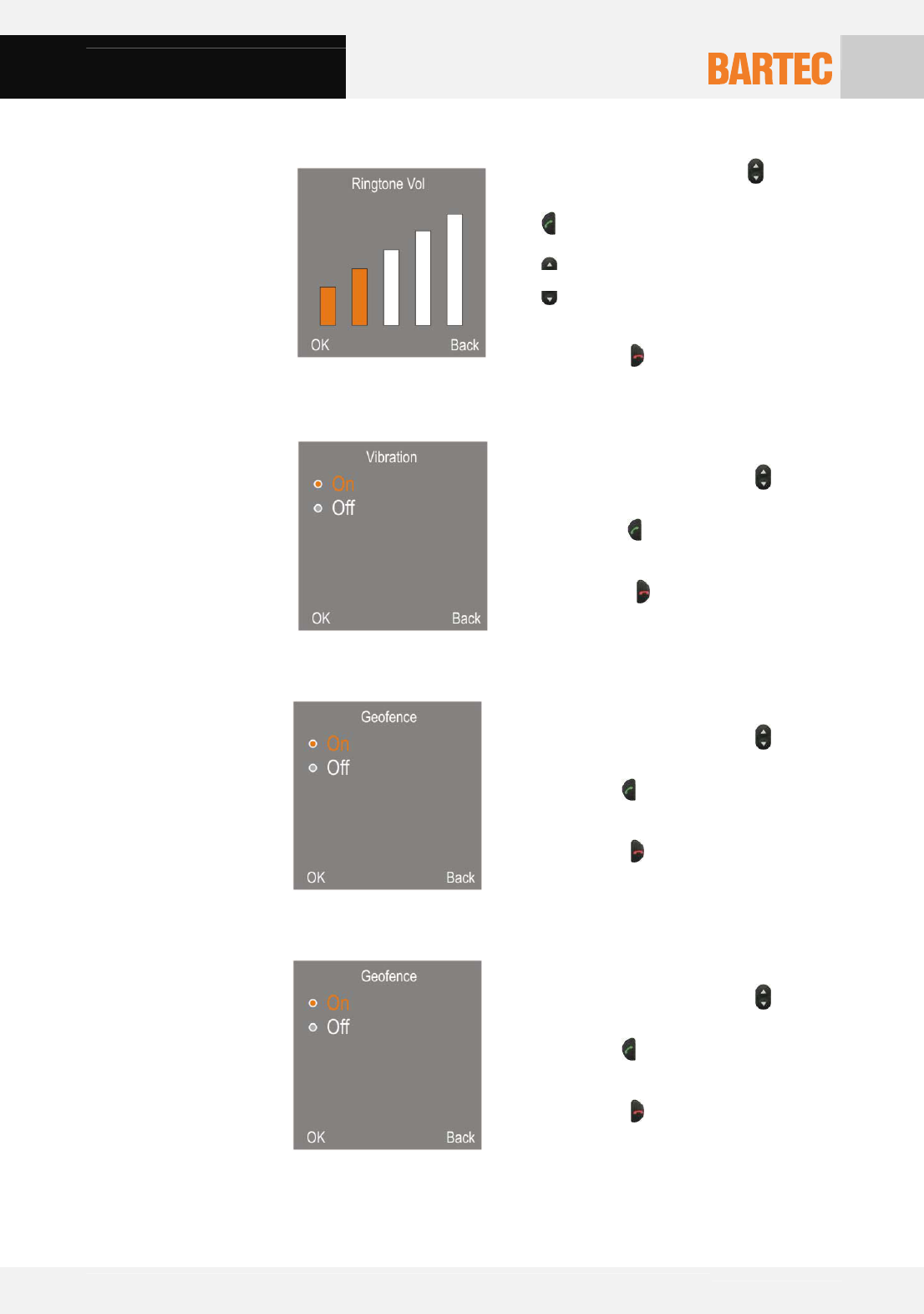
User Manual Pegasus 70xx series
Technical data subject to change without notice.
Issue 01/2010 Page 25 of 44
5.1.3.2 Sound volume
5
Use the 2-way navigation key to change
the volume and confirm with the left soft key
.
loud
low
You can exit the sub-menu by pressing the
right soft key .
5.1.3.3 Vibration
Use the 2-way navigation key to select
Vibration On or Off and confirm it with the
left soft key .
You can exit the sub-menu by pressing the
right soft key .
5.1.3.4 Geofence
Use the 2-way navigation key to select
Geofence On or Off and confirm it with the
left soft key .
You can exit the sub-menu by pressing the
right soft key .
5.1.3.5 Tracking
Use the 2-way navigation key to select
Tracking On or Off and confirm it with the
left soft key .
You can exit the sub-menu by pressing the
right soft key .
5.1.3.6 Clock setting
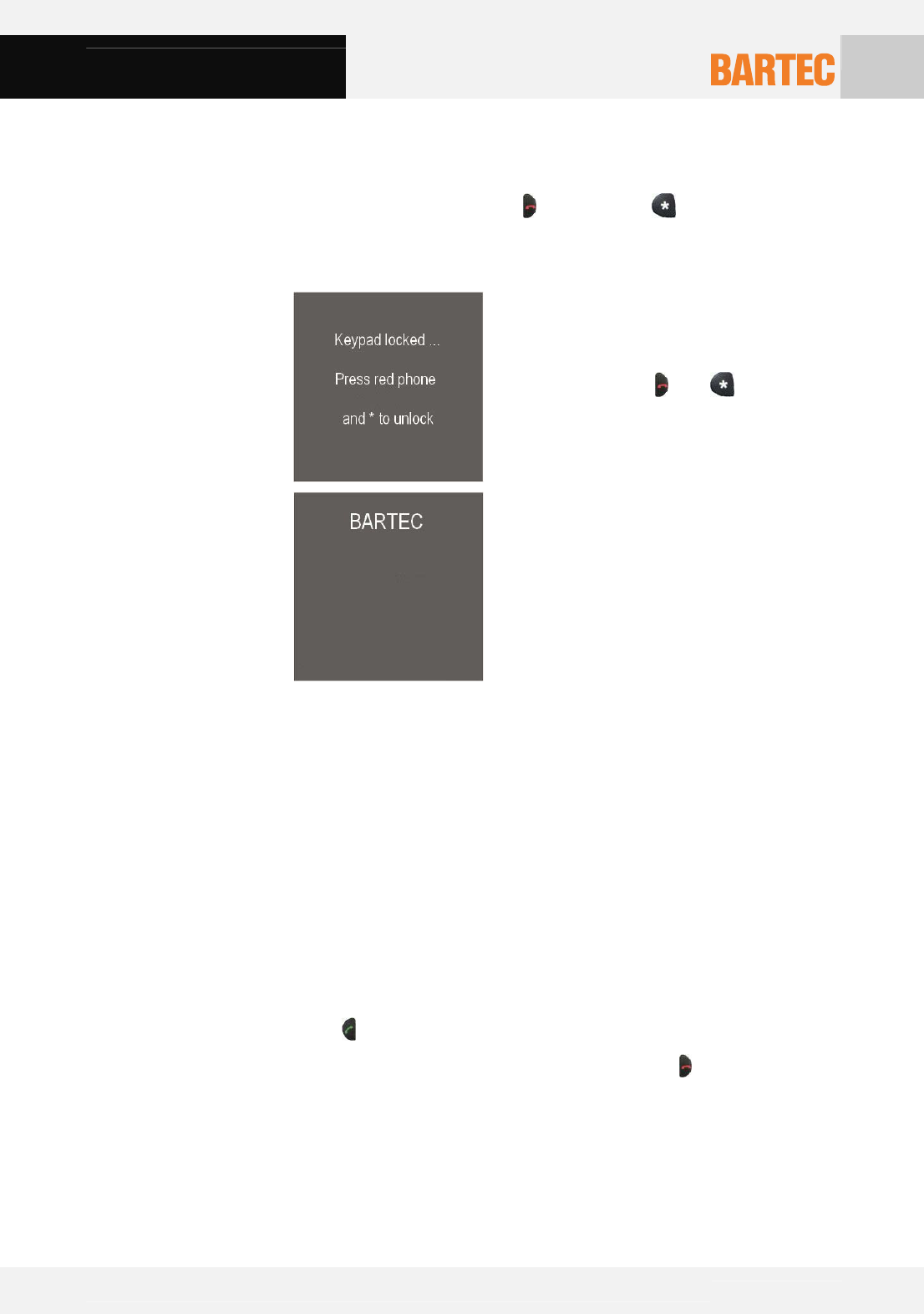
User Manual Pegasus 70xx series
Technical data subject to change without notice.
Issue 01/2010 Page 26 of 44
5.4.1 Key lock
You can lock and unlock the keypad with keypad shortcuts.
To lock or unlock, press the right soft key and the star key .
If the Pegasus 70xx is not in use for longer than 1 minute, the device will switch to
screen saving mode and lock the keys.
When the device is locked and you press a
key, the Press and key message
appears.
Locked keys:
You will see the screensaver.
5.1.2 Making a call
You have different options to establish a call:
¨ Start dial from the start screen.
¨ Start dial from the menu dialpad.
¨ Dial a number from the Phonebook or the SIM card.
5.2.2 Starting dialing from the start screen
¨ Begin to dial the number when you are in the start screen.
Press the left soft key to start the dialling process.
¨ You can cancel or stop the call by pressing the right soft key .
5.2 Phone settings
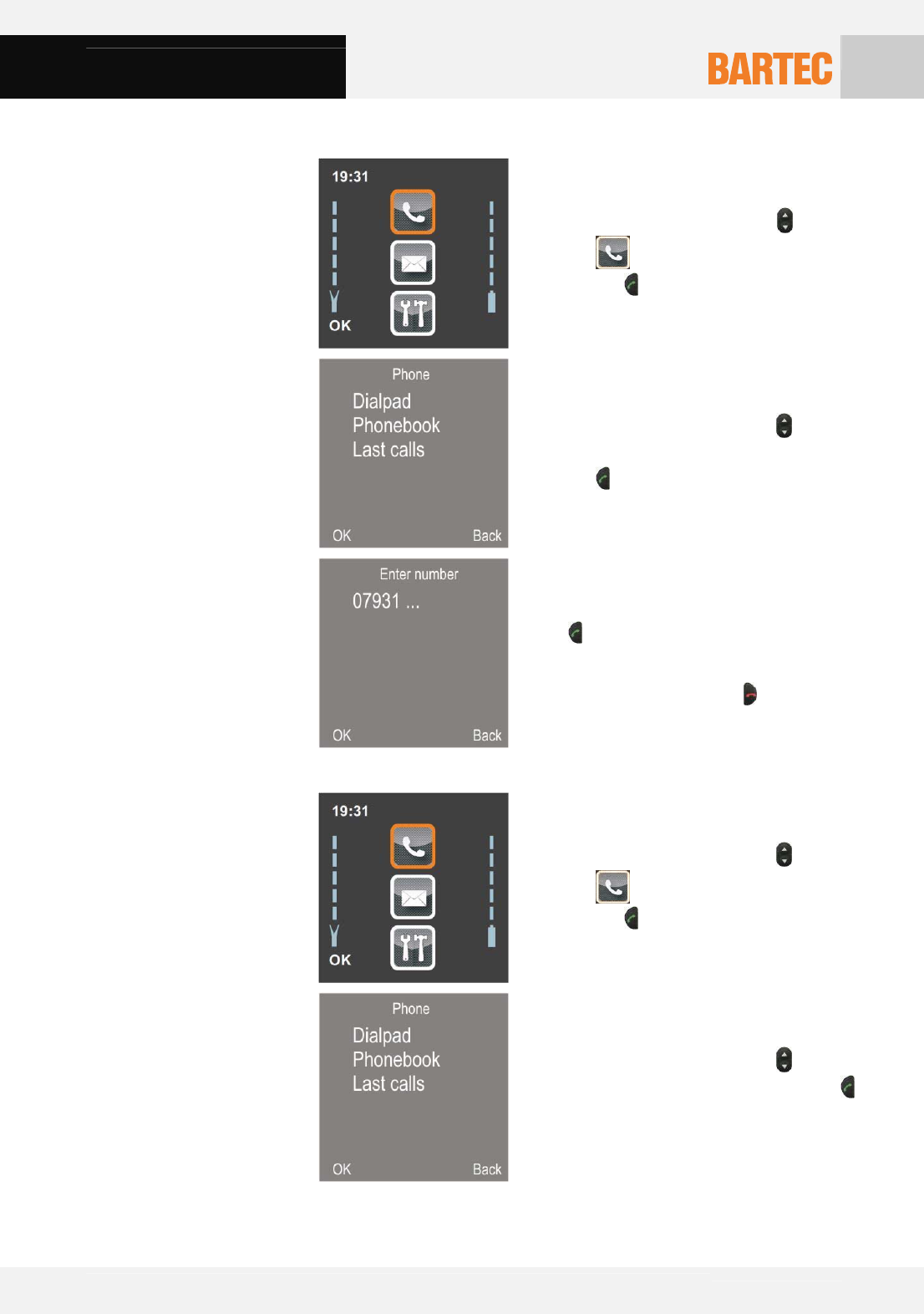
User Manual Pegasus 70xx series
Technical data subject to change without notice.
Issue 01/2010 Page 27 of 44
5.3.2 Starting dialing from the menu
Use the 2-way navigation key to select
the phone menu and press the left
soft key to enter the menu.
Use the 2-way navigation key to select
the “Dialpad” menu and press the left soft
key to enter the sub-menu.
Dial a number and press the left soft key
to start the dialling process.
You can cancel or stop the call by
pressing the right soft key .
5.4.2 Dialing a number from the Phonebook
Use the 2-way navigation key to select
the phone menu and press the left
soft key to enter the menu.
Use the 2-way navigation key to select
the “Phonebook” menu and press the
left soft key to enter the sub-menu.
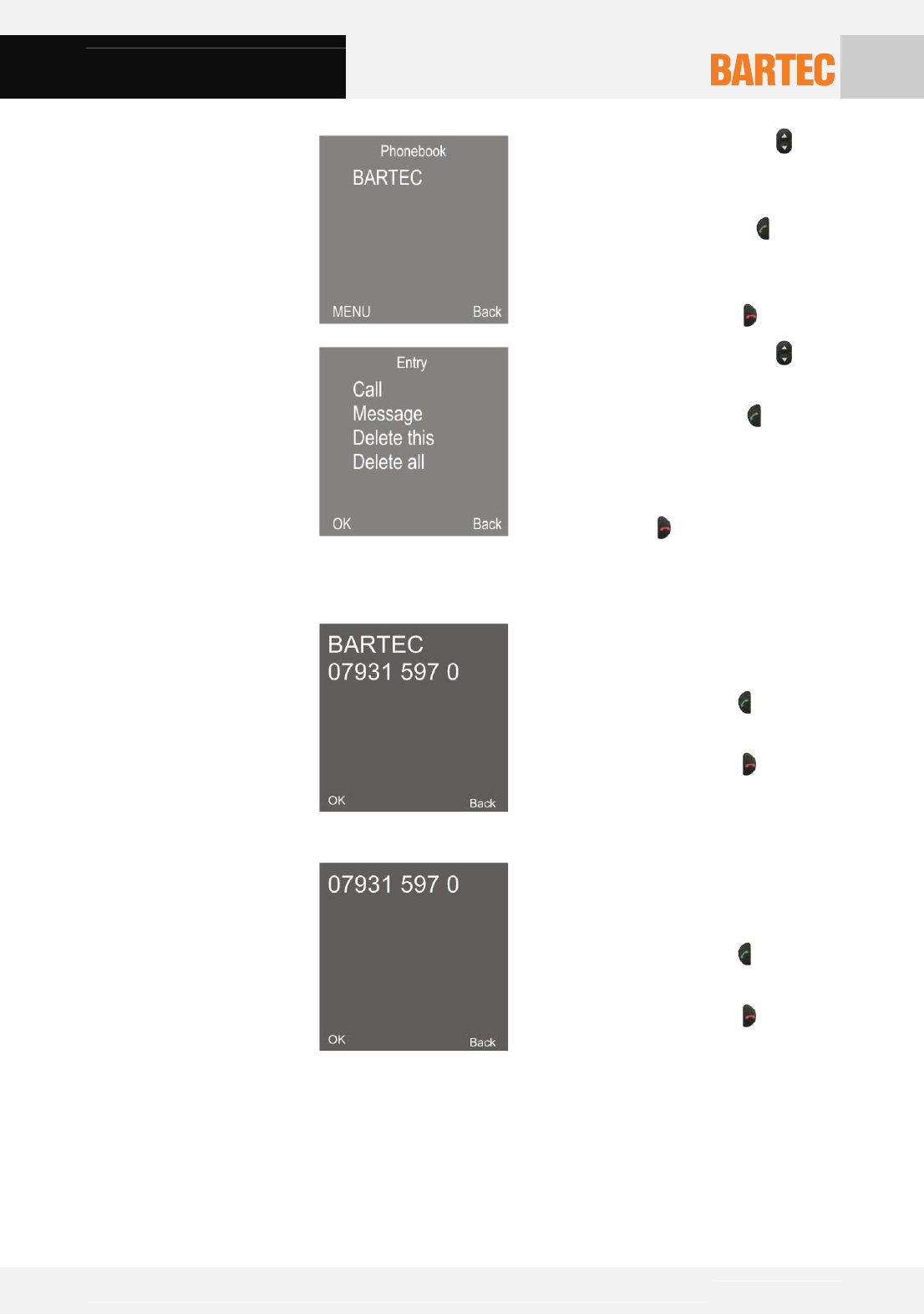
User Manual Pegasus 70xx series
Technical data subject to change without notice.
Issue 01/2010 Page 28 of 44
Use the 2-way navigation key to select
a contact in your “Phonebook” or the “SIM
card”.
First press the left soft key to show the
sub menu of the contact.
You can cancel or stop the call by
pressing the right soft key .
Use the 2-way navigation key to select
a option in your “Phonebook”
Press the left soft key to start the
dialling process, write a message or delete
the Phonebook entry.
You can exit the sub-menu by pressing the
right soft key .
5.5.2 Receiving call
5.6.2 Known call
The name and the number of the incoming
call appear on the screen.
Press the left soft key to accept the
incoming call.
Press the right soft key to refuse the
incoming call.
5.7.2 Unknown call
Only the number of the incoming call
appears on the screen. Only this function
is supported by the network.
Press the left soft key to accept the
incoming call.
Press the right soft key to refuse the
incoming call.
5.8.2 Last call
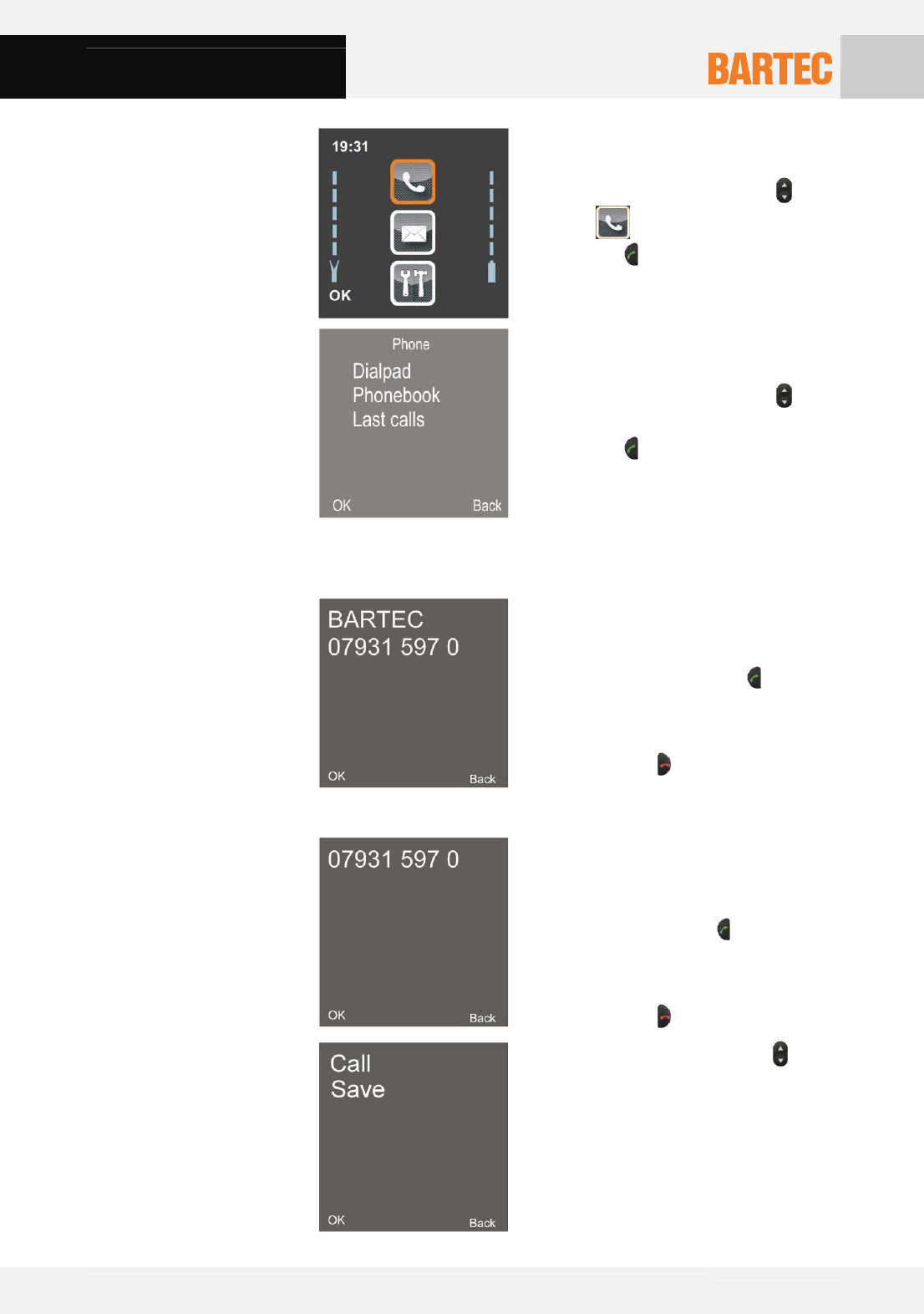
User Manual Pegasus 70xx series
Technical data subject to change without notice.
Issue 01/2010 Page 29 of 44
Use the 2-way navigation key to select
the phone menu and press the left
soft key to enter the menu.
Use the 2-way navigation key to select
the “Last caller” menu and press the left
soft key to enter the sub-menu.
5.9.2 Known call
The name and the number of the incoming
call appear on the screen.
Press the left soft key to start the
dialling process.
You can exit the sub-menu by pressing the
right soft key .
5.10.2 Unknown call
Only the number of the incoming call
appears on the screen. Only this function
is supported by the network.
Press the left soft key to go into the next
sub-menu.
You can exit the sub-menu by pressing the
right soft key .
Use the 2-way navigation key to select
an option.
■ Call start to dial the number.
■ Save save the contact in the
“Phonebook”
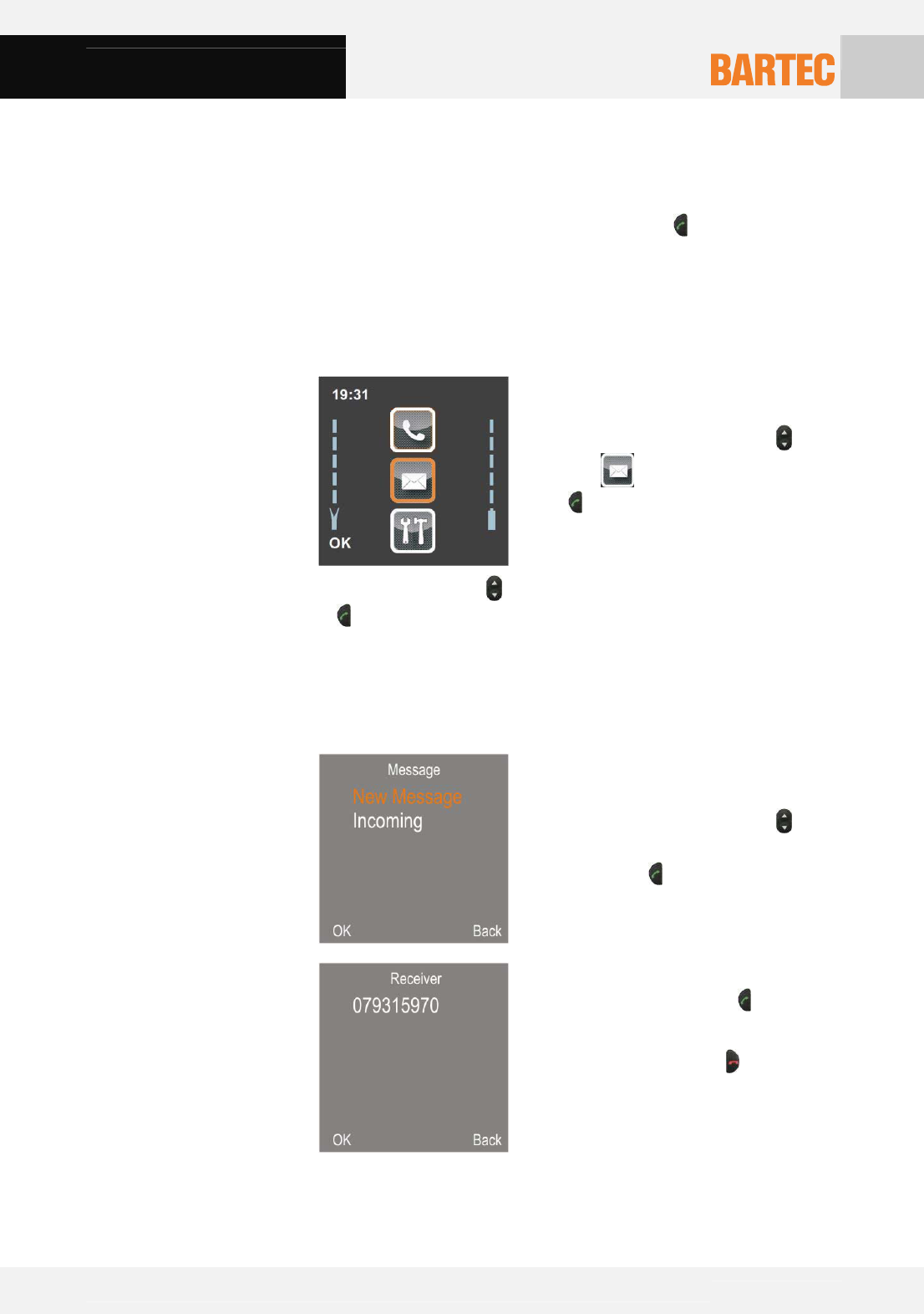
User Manual Pegasus 70xx series
Technical data subject to change without notice.
Issue 01/2010 Page 30 of 44
Save:
Type the name of the contact and save the
contact in your “Phonebook” by pressing
the left soft key .
5.1.3 SMS Options
Use the 2-way navigation key to select
the “Message” menu and press the
left soft key to enter the menu.
Use the 2-way navigation key to select your option in the “Message” menu and
press the left soft key to enter the sub-menu.
■ New message Write a new message and send to a contact/s.
■ Incoming Received SMS are stored in the Inbox.
5.2.3 Creating a new message
Use the 2-way navigation key to select
the “New message” menu and press the
left soft key to enter the menu.
Enter the number of the Receiver.
Press the left soft key to accept the
number.
Press the right soft key to delete the last
character entered and to exit the sub-
menu
5.3 SMS (Short Message Service) Settings
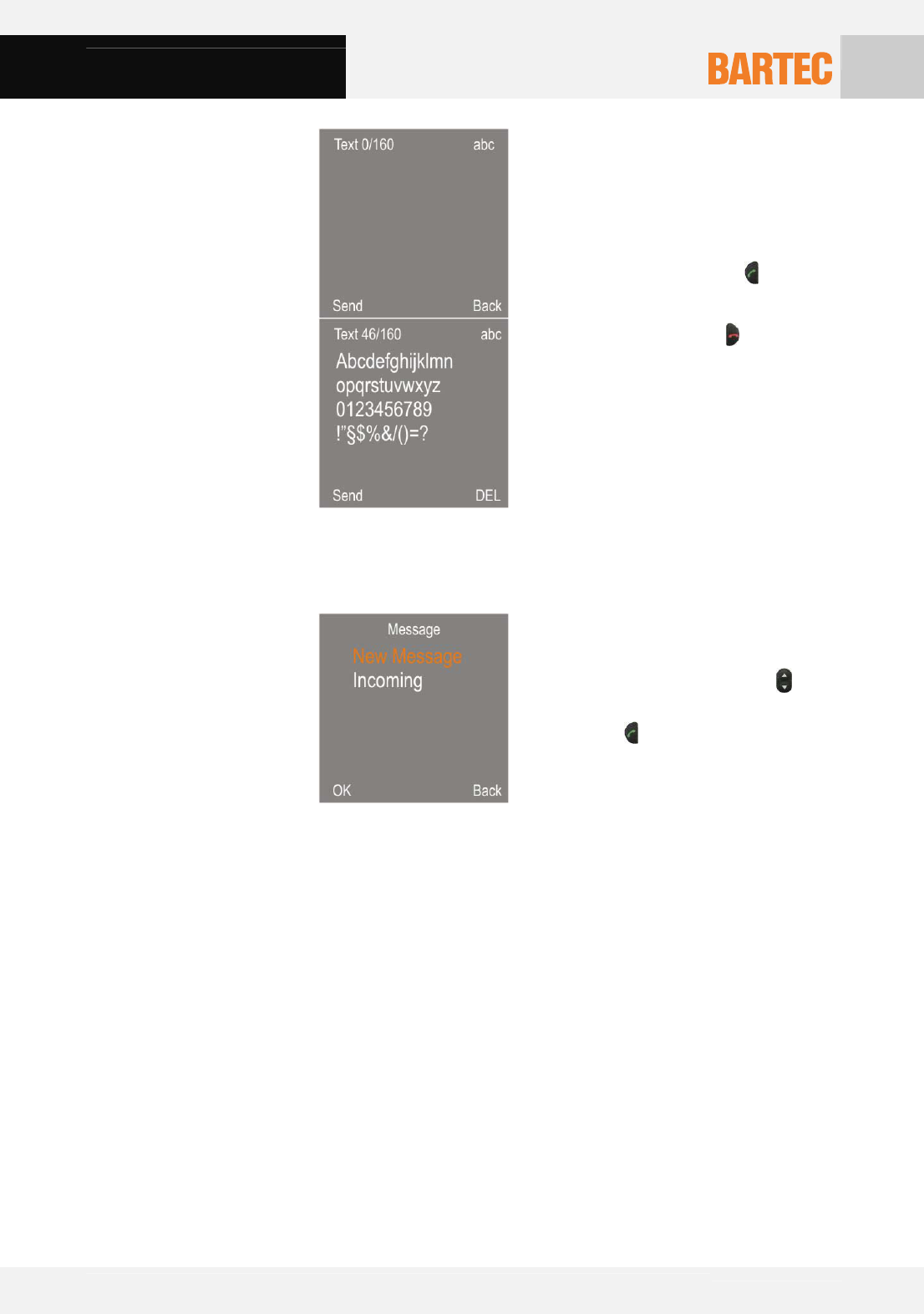
User Manual Pegasus 70xx series
Technical data subject to change without notice.
Issue 01/2010 Page 31 of 44
Enter the text in the field.
Press the left soft key to send the
message
Press the right soft key to delete the last
character entered.
5.3.3 Incoming
All messages received are stored in this
menu.
Use the 2-way navigation key to select
the “Incoming” menu and press the left
soft key to enter the menu.
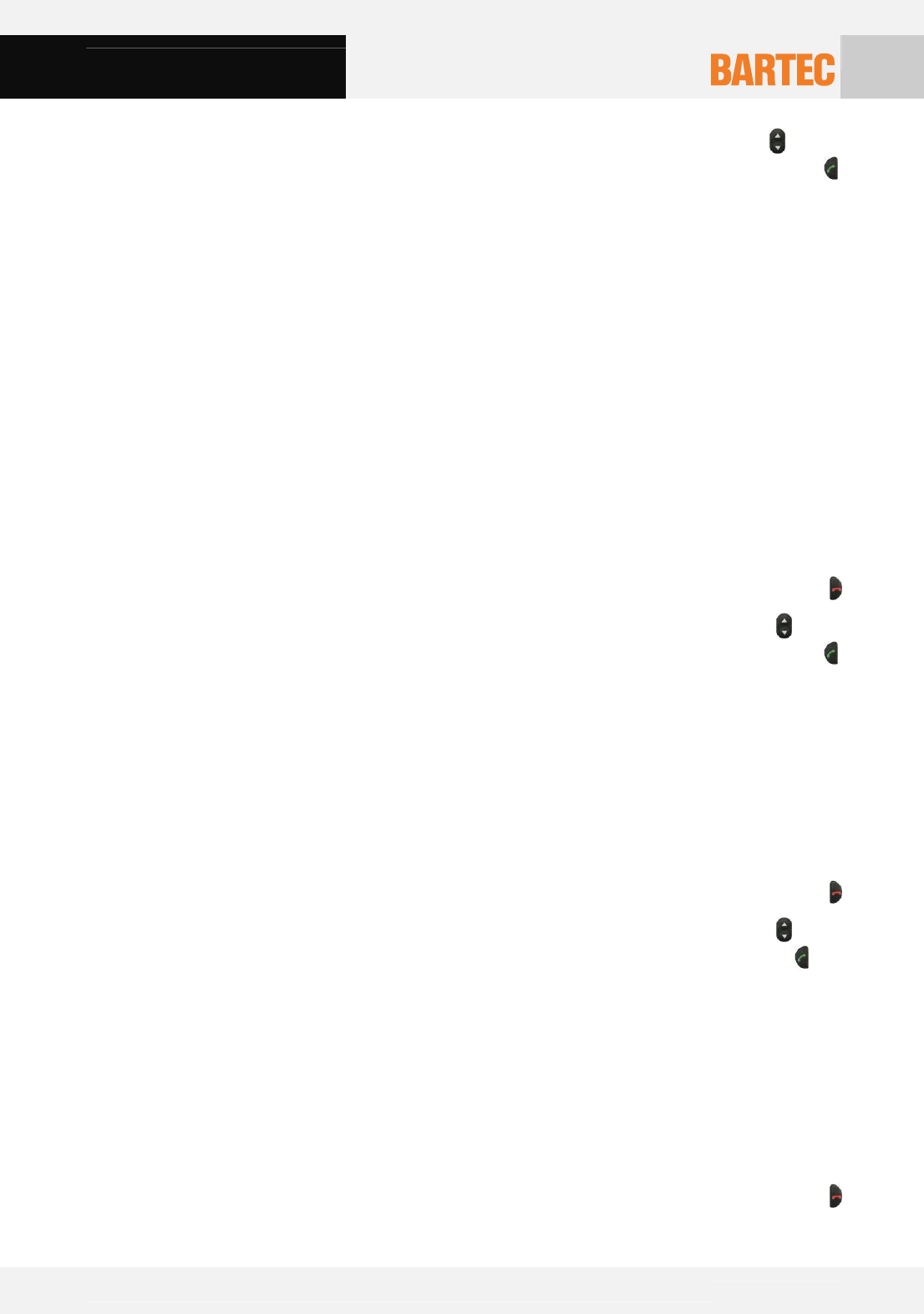
User Manual Pegasus 70xx series
Technical data subject to change without notice.
Issue 01/2010 Page 32 of 44
Use the 2-way navigation key to choose
a message and press the left soft key to
read it.
■ Messages are listed chronologically.
■ The newest message is listed first.
■ Unread messages are highlighted
with a bold font.
Options:
■ Read the message.
■ Delete the message.
■ Forward the message.
■ Answer the message.
You can exit the sub-menu or the
message by pressing the right soft key .
Use the 2-way navigation key to select
a message and press the left soft key to
read it.
Options:
■ Send the message again
■ Forward the message
■ Delete the message.
You can exit the sub-menu or the
message by pressing the right soft key .
Use the 2-way navigation key to select
a draft and press the left soft key to edit
it.
Options:
■ Send the message
■ Edit the message
■ Delete the message.
You can exit the sub-menu or the
message by pressing the right soft key .

User Manual Pegasus 70xx series
Technical data subject to change without notice.
Issue 01/2010 Page 33 of 44
6 Maintenance, Inspection, Repair
Caution!
Only trained and qualified personnel may commission and do maintenance work on the
Pegasus 70xx series! Trained qualified personnel are people who are familiar with the
installation, assembly, commissioning and operation of the Pegasus 70xx series, have
been instructed about the risks and have the appropriate qualifications by virtue of the
work they do.
Maintenance intervals
The mechanical status of the devices should be checked at regular intervals. The length
of the maintenance intervals depends on the ambient conditions. We recommend
checking at least once a year. Regular maintenance is not necessary if operated
appropriately in conformance with the installation instructions and with due consideration
to the ambient conditions.
Inspection
Under IEC 60079-19 and EN 60079-17, the owner/managing operator of electrical
installations in hazardous areas is obliged to have these installations checked by a
qualified electrician to ensure that they are in a proper condition.
Servicing
Adhere to the applicable regulations under Directive 99/92/EC, IEC 60079-19 and IEC
60079-17 when servicing, doing maintenance work on and testing associated operating
equipment!
Assembly/disassembly, operating and maintenance work may be done only by trained
specialists. The statutory rules and other binding directives on workplace safety,
accident prevention and environmental protection must be observed.
Observe the national waste disposal regulations when disposing of the equipment.
Instructions for Repairs
If you wish to send in a defective device for repair, please read the RMA procedure
guidance first. Then fill in and sign the RMA (Return Merchandise Authorization) form
and send it to our "Retouren Center".
Email: services@bartec.de Fax: +49 7931 597-119
We cannot guarantee any contractually agreed processing times for devices that are
sent in without an RMA number.
The RMA guide and the RMA form are available on our homepage for downloading.
http://www.bartec-group.de Quality and culture RMA form
Have you any questions? Write us an e-mail or call us.
E-mail: services@bartec.de Phone: +49 7931 597-444
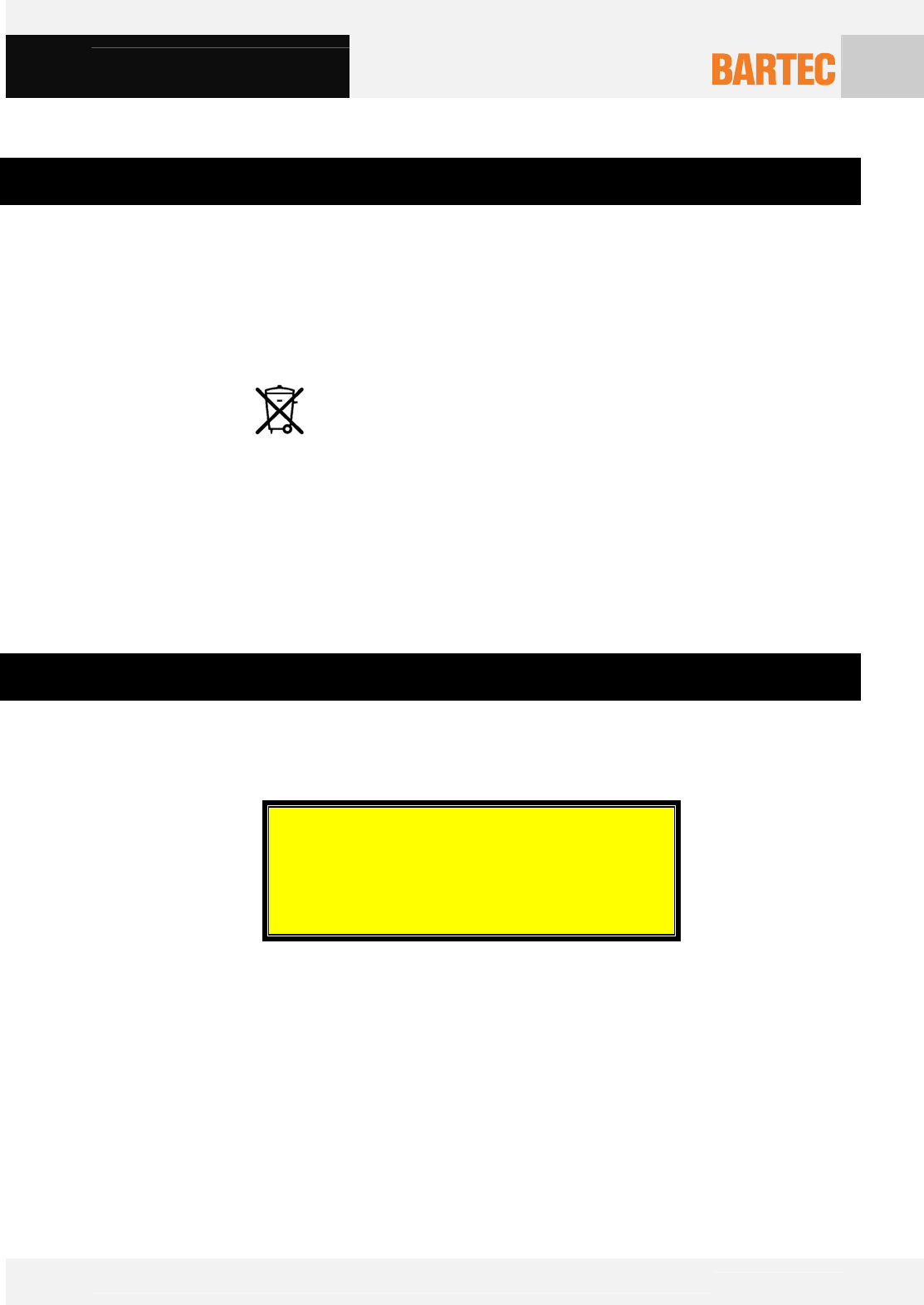
User Manual Pegasus 70xx series
Technical data subject to change without notice.
Issue 01/2010 Page 34 of 44
7 Disposal
Battery packs should not be disposed of in general household waste. Observe the local
waste disposal regulations, which you can find out about contacting your local authority.
All electrical and electronic products should be disposed of separately from the
municipal waste stream via designated collection facilities appointed by the government
or the local authorities.
This crossed-out wheeled bin symbol on the product means the product is
covered by the European Directive 2002/96/EC
The correct disposal and separate collection of your old appliance will help prevent
potential negative consequences for the environment and human health. It is a
precondition for reuse and recycling of used electrical and electronic equipment.
For more detailed information about disposal of your old appliance, please contact your
local council refuse centre or the original supplier of the product.
8 Dispatch and Packaging Instructions
Important information regarding transport and dispatch
! Sensitive Devices!
It is essential to send in the device in the
original packaging to prevent damage to
the device.

EC-Declaration of
Conformity Pegasus 70xx series
Technical data subject to change without notice.
Issue 01/2010

Technical data subject to change without notice.
Issue 01/2010 Page 36 of 44